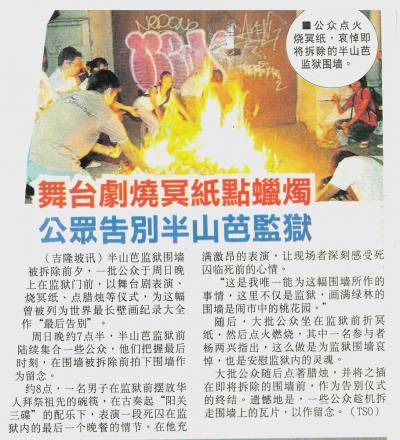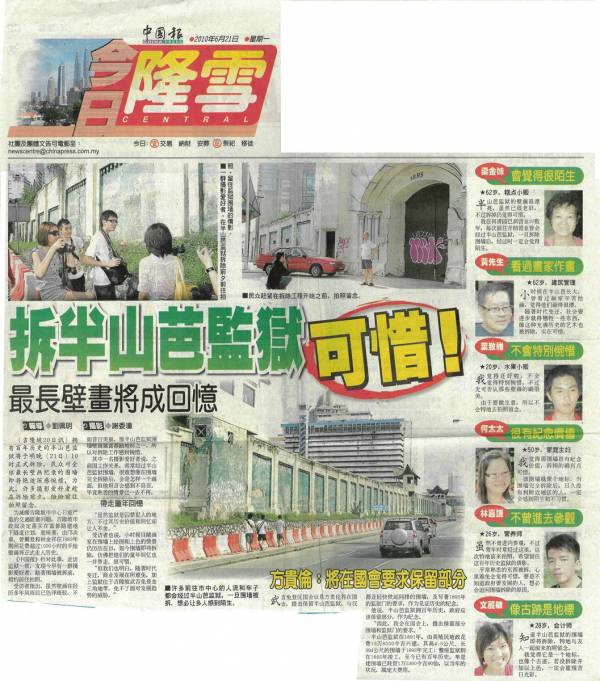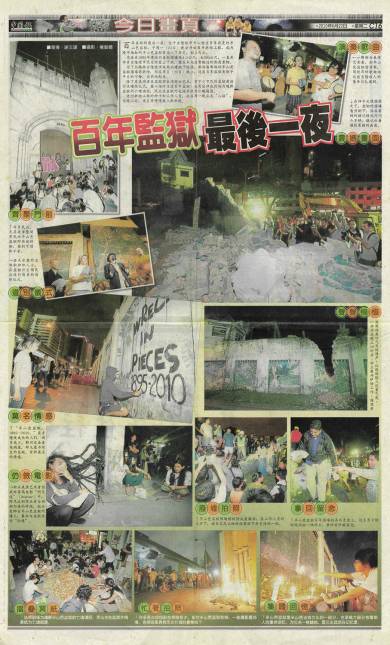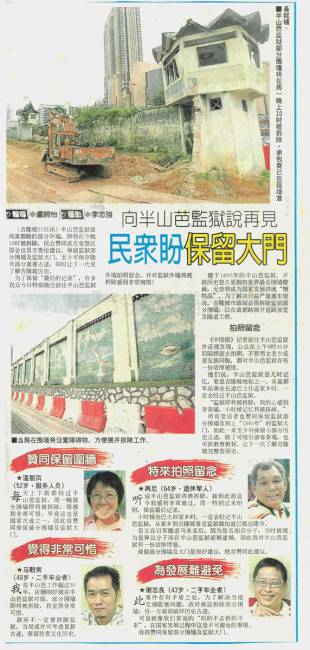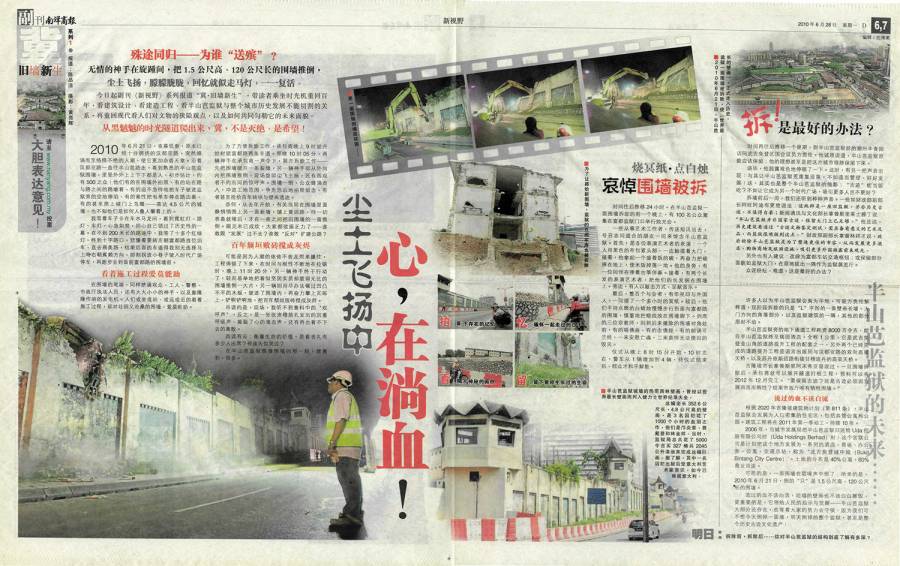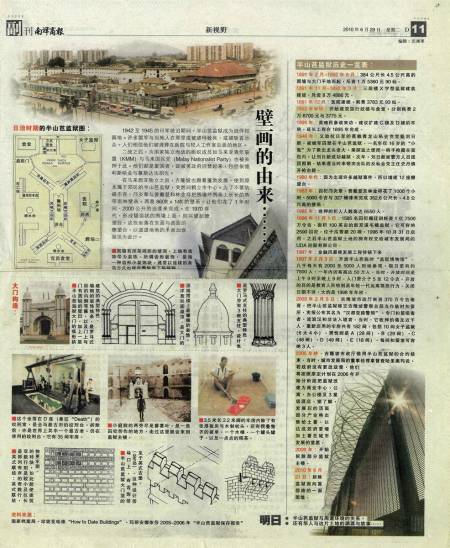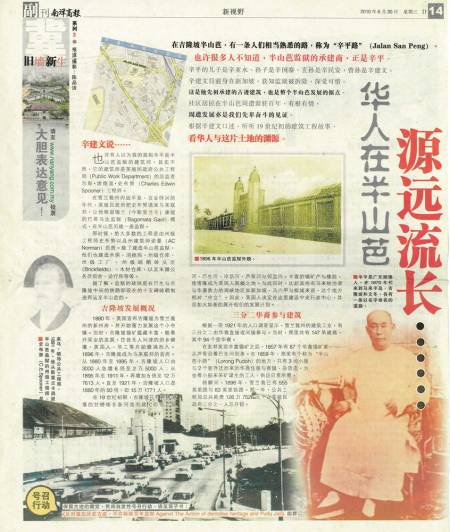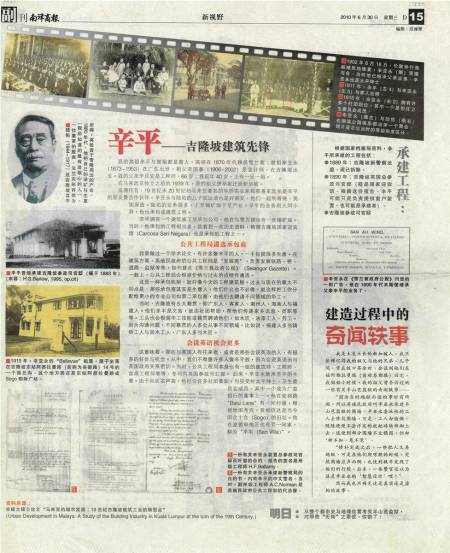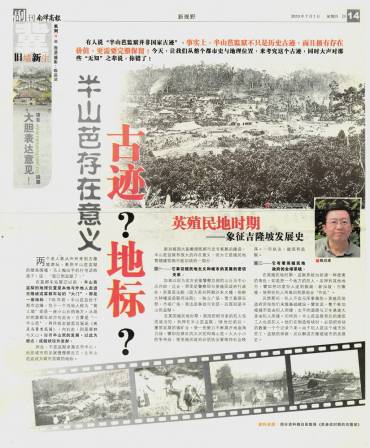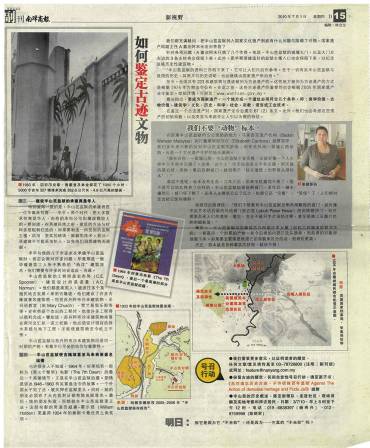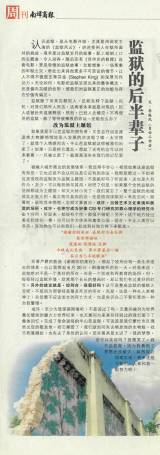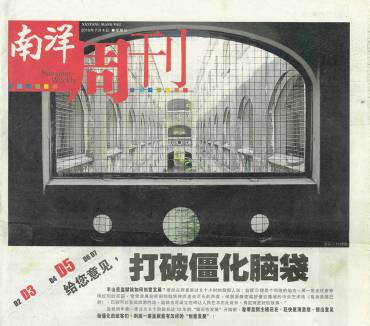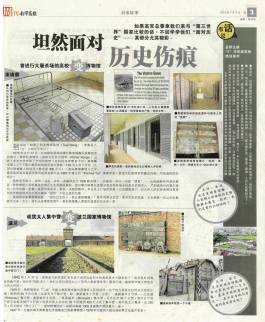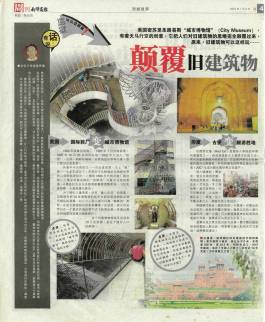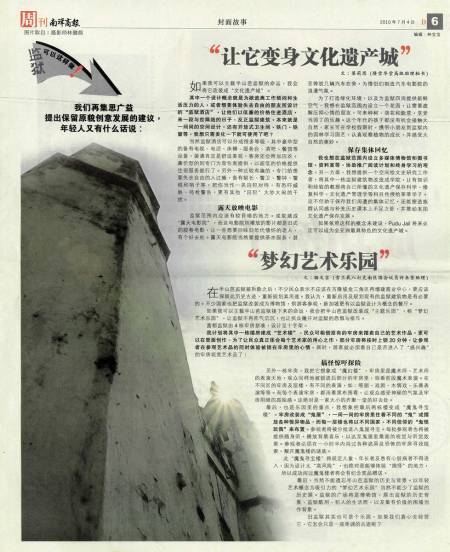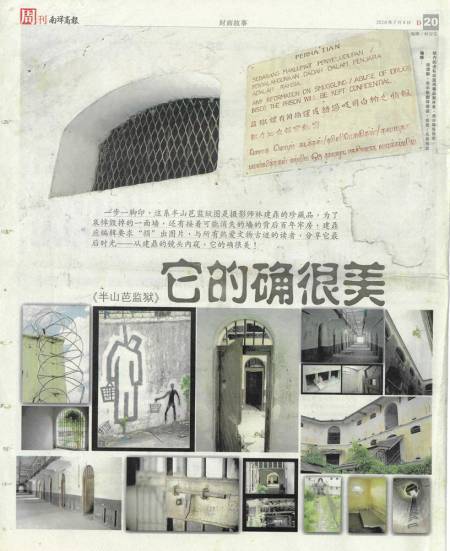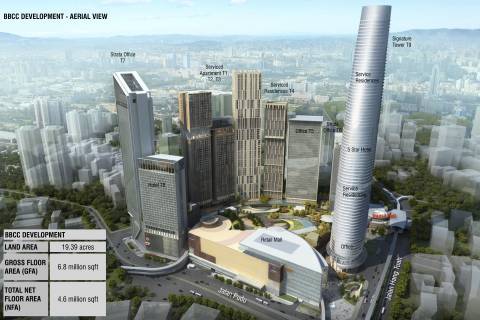Jadual Kandungan
Penjara Pudu (1895-2010)
Penjara Pudu adalah sebuah penjara di Kuala Lumpur, Malaysia. Ia telah dibina secara berperingkat oleh kerajaan kolonial British di antara 1891 dan 1895, dan terletak di Jalan Shaw (kini Jalan Hang Tuah). Pembinaan dimulakan dengan dinding penjara sepanjang 394 meter yang telah menelan belanja sebanyak $16,000 Straits dolar, dan ianya pernah dihiasi dengan mural terpanjang di dunia suatu ketika dahulu. Ruang setiap penjaranya kecil dan gelap, hanya dilengkapi dengan sebuah tingkap sebesar kotak kasut.
Kompleks penjara ini telah dimusnahkan hampir sepenuhnya menjelang Disember 2012, untuk tujuan pembangunan kota. Di atas permintaan para pemulihara warisan dan orang awam, gerbang utama serta sebahagian dinding luar dikekalkan dan kini menjadi sebahagian daripada taman persekitaran Pusat Bandar Bukit Bintang dan pusat beli-belah, yang dibina di tapak penjara.
1889-1957: Zaman Kolonial
1889: Pemilihan dan Penyediaan Tapak
“Pada tahun 1889, kerajaan Selangor telah mengenalpasti lokasi tapak penjara yang paling sesuai dan strategik. Sebidang tanah seluas 10 hektar di Kampung Pudu telah dikenalpasti. Kedudukan tanah ini yang hanya sebatu (kira-kira 1.5 km) sahaja dari pusat bandar. Tidak jauh tetapi tersembunyi daripada pandangan penduduk awam Kuala Lumpur. Pelan pembangunan penjara baharu di Pudu ini telah diluluskan oleh pemangku Residen British ketika itu, Sir J.P. Rodgers. Kawasan tapak Penjara Pudu ini sebenarnya kawasan hutan di mana sering kedengaran suara harimau mengaum mencari makanan di dalamnya. Cuma terdapat beberapa buah rumah papan beratap nipah di situ. Sebenarnya sebahagian besar tapak tersebut merupakan jirat Cina lama yang ditinggalkan. Kemungkinan jirat ini mengebumikan ratusan mayat pekerja-pekerja lombong bijih timah seawal pembukaan Kuala Lumpur lagi. Lama kelamaan jirat ini ditutupi hutan belukar. Namun,tidak jauh dari sana, terletaknya sebuah perkampungan kaum Cina di Pudu. Mereka bertani menanam sayur-sayuran di kebun-kebun mereka di pinggir hutan tersebut untuk dijual di pasar-pasar sekitar Kuala Lumpur. Kerajaan sedar tentang kewujudan jirat Cina lama di situ, tetapi kedudukan strategiknya tidak boleh dibiarkan begitu sahaja. Maka proses pengambilan tanah di situ pun bermula. Sebahagian besar kawasan tersebut dimiliki oleh tiga orang penduduk tempatan iaitu Haji Suleyman, Baginda Halim dan See Bee Bee. Terdapat lima buah rumah milik penduduk tempatan di situ. Pampasan kewangan hanya akan dibayar selepas rumah-rumah mereka dirobohkan dan tanah diserahkan kepada kerajaan. Kerajaan memutuskan nilai pampasan sebanyak $25 dibayar bagi setiap lot tanah tersebut dan $20 hingga $30 bagi setiap rumah. Dalam tahun yang sama juga, Mayat dan sisa-sisa tulang dari jirat ini perlu dikumpulkan dengan betul, dengan penuh kehormatan, dikeluarkan dari tapak itu, dan dikebumikan di tempat lain mengikut adat pengebumian Cina. Kerajaan bersetuju dan akan membiayai semua kerja penggalian serta pengebumian semula tulang-tulang tersebut.”
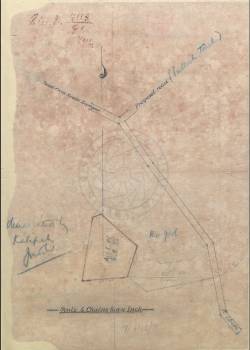
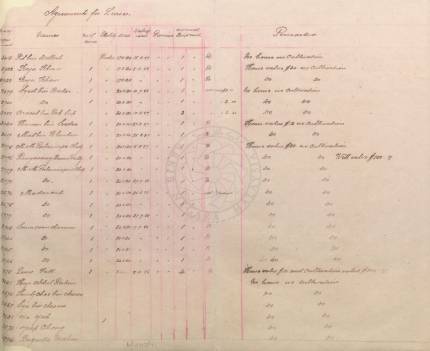
Kiri: “Kedudukan Tapak Penjara Pudu yang strategik”
Kanan: “Keterangan pemilik-pemilik asal tapak penjara Pudu pada tahun 1891”
(Sumber: Aku Budak Telok, 30 September 2022: |"Menyingkap Tirai Besi di Penjara Pudu (1895-1899)").
Cebisan perihal pemilik asal tapak penjara:-
- “NOTIFICATION FROM HAJI SLEMAN AND BAGINDA MALIM, LANDOWNERS KUALA LUMPUR TO THE ACTING BRITISH RESIDENT REGARDING THEIR PETITIONS IN THE MONTH OF JUNE AND OCTOBER PRAYING FOR ASSISTANCE IN CONNECTION WITH THEIR LAND IS RETURNED BY GOVERNMENT FOR THE PURPOSE OF THE NEW JAIL AT PUDU AREA” (07/12/1891: |"RE THEIR LAND AT PUDU GAOL SITE. ASK FOR COMPENSATION").
1891-1895: Pembinaan
Penjara Pudu mula dibina pada 1891, dan siap pada 1895. Rekabentuk serta pembinaannya adalah untuk memuatkan seramai 950 orang banduan, dan dijalankan oleh jurutera negeri merangkap pengarah Public Works Department ketika itu, iaitu Charles Edwin Spooner. Ianya telah menelan kos sebanyak RM 138 000 ($320 000), dan dibina dalam enam peringkat menggunakan besi, batu bata dan simen, yang diimport dari koloni-koloni British. Ianya dibina di suatu kawasan hutan di sebelah tenggara Kuala Lumpur (lama), yang telah diterangkan, bernama Kampung Pudu. Kawasan tersebut dipilih oleh kerana lokasinya yang strategik (agak hampir dengan bandar, tapi bukan jarak yang membahayakan). Ianya dikelilingi deretan kedai dan kediaman polis dan para pegawai penjara: “Pudu Jail’s construction began in 1891 and was completed in 1895. It was designed by Charles Edwin Spooner, the state engineer and director of Public Works Department to fit 950 inmates. At the cost of RM 138 000 ($320 000), the prison was built in six phases using steel, brick and cement, all imported from British colonies. Built in a jungle clearance named Pudu Village (south east of old Kuala Lumpur), the prison’s location seemed ideal during that period, being conveniently close to the city but not close enough to be a threat. Surrounding the prison walls were rows of shop-houses and residential of police and prison officers.”
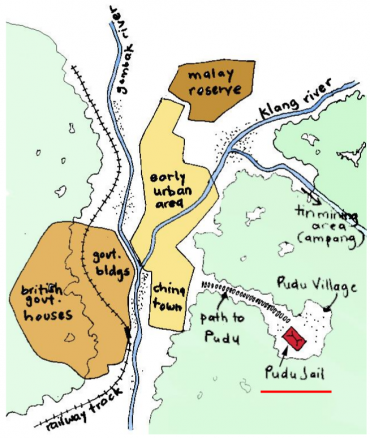
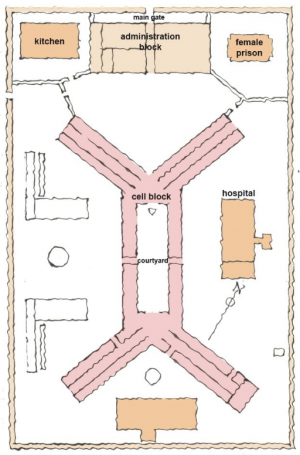
Kiri: Lakaran peta lokasi Pudu pada tahun 1900-an, oleh Mariana Isa: “Figure 5: Author’s sketch of Pudu Jail’s location in 1900.”
Kanan: Lakaran pelan Penjara Pudu pada peringkat awal: “Figure 7: A sketch of Pudu Jail’s early layout.”
Struktur utamanya ialah blok tahanan besar setinggi 3 tingkat, yang berbentuk seperti “St. Andrew's Cross”. Ianya dibina dengan batu dan konkrit, dengan ruang laman di tengah-tengahnya untuk tempat berkumpul, serta pengudaraan dan sumber cahaya. Ruang tersebut juga dijadikan tempat hukuman sebatan dijalankan. Pintu masuk hadapannya direkabentuk gaya Moorish, dilengkapi dua menara berkubah. Ianya berhadapan blok pengurusan setinggi 2 tingkat, dengan blok penjara wanita dan dapur di dua sisinya. Hospital penjara terletak di sebelah timur, berasingan dari blok utama: “The main prison structure is the Cell Block. Built to the shape of St. Andrew’s cross, it is a massive three storey stone and concrete building housing cells and gallows. The Cell Block has a narrow open courtyard in the centre where whippings took place. The courtyard was a gathering space that served lighting and ventilation purposes. The front gate depicts Moorish architecture in its two domed towers. It led to a two storied building known as the Administrative Block with a separate female prison and prison kitchen on each side. A prison hospital was to the east, separated from the main building.”
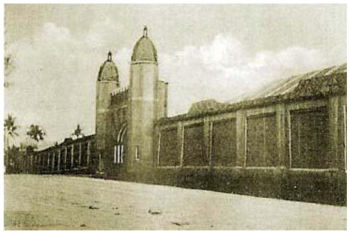

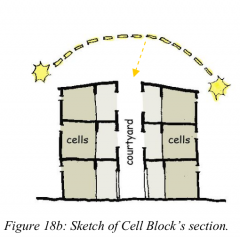
Kiri: Gambar gerbang hadapan pada tahun 1896: “Figure 4: Pudu Jail’s front gate in 1896.”
Tengah: Ruang laman di tengah blok utama (2006): “Figure 18a: Courtyard of Pudu Jail’s Cell Block”
Kanan: Lakaran pencahayaan dan pengudaraan di laman blok utama: “Figure 18b: Sketch of Cell Block’s section.”
Pintu utamanya pula direkabentuk gaya Moorish, dan dilengkapi dua menara berkubah. Sebagai peninggalan zaman Victoria, rekabentuknya dipengaruhi struktur penjara kolonial British pada zaman itu, yang menitikberatkan keselamatan serta pengoperasian secara manual, selain terlindung dan terhindar daripada pandangan orang awam. Ciri binaannya disesuaikan untuk keadaan iklim serta budaya setempat: “A relic of the Victorian period, Pudu Jail’s architecture is strongly influenced by British colonial prison structure and design which emphasizes security and manual operation. The butterfly form of the Cell Block is the key architectural asset, hidden from the view of polite society for a century. The building’s bare design and minimal details strengthens its architectural impact as a prison. Its grim character adds an awkward charm to the place. Spooner has produced a prison design that was suitable to the local climate and culture. These are apparent in the use of courtyards, jack-roofs, large overhangs and the Moorish front gate.”
(Sumber: Mariana Isa @ University of Bath, 2006: |"Pudu Jail Conservation Statement", m.s. 9-10, 16-17).
Bentuk “X” atau “cruciform” pada blok utamanya adalah mirip Penjara Kandy di Bogambia, Afrika: “The prison was built at the then princely sum of $138,000. Its first governor was Lt-Kol J.A.B. Ellen. Also known as Pudoh Gaol, most of its building materials were imported from India and Britain. Its design of an X (cruciform) was copied from the Kandy Prison in Bogambia, Africa. It originally had 240 cells on three floors, but more cells were added over the years. Its mass kitchen, bathrooms, administrative office, hospital and training centre are located outside the main X-building structure.” (The Star, 17 Jun 2008: |"Pudu Prison a prominent landmark in the city").
LATAR PERISTIWA: Pembinaan Penjara Pudu (1891-1895).
1895-1910: Operasi Peringkat Awal
Pada tahun-tahun awal operasinya, Penjara Pudu adalah satu-satunya penjara di Selangor, memenjarakan lelaki dan wanita dalam tempoh hukuman yang tidak lama. Ia dilengkapi kebun yang dapat menampung keperluan makanan penghuninya: “Early in its history, Pudu Prison was the only prison in the state of Selangor and used to imprison men and women with short sentences. The prison was also self-sufficient as it had a vegetable garden that could produce enough food for its inmates annually.” (Wikipedia: Pudu Prison).
Ia juga turut digunakan sebagai pusat operasi tentera British, termasuk tempat menjalankan hukuman bunuh ke atas pemberontak, sama ada oleh pasukan penembak atau digantung. Mayatnya ditanam di kawasan penjara, bagi mengelak diketahui umum: “During its early years, Pudu Jail was used by the British as an army command centre. Those who fought against the British were executed, either by a firing squad or by hanging, and buried on prison grounds to prevent news about the executions from going beyond Pudu Prison walls.” (Mariana Isa @ University of Bath, 2006: |"Pudu Jail Conservation Statement", m.s. 11).
LATAR PERISTIWA: Operasi Awal Penjara Pudu (1895-1910)
1895-1898: Wabak Taun dan Beri-Beri
Tidak lama selepas dibuka, wabak taun melanda Penjara Pudu mulai sekitar Ogos 1895, dan kekal selama 3 tahun, sebelum dapat dikawal dan dikenalpasti puncanya. Siasatan mendapati puncanya ialah punca bekalan air dari telaga di bekas perkuburan yang tercemar: “In August 1895, an outbreak of cholera spread through the prison which led to many prisoners being quarantined in their cells. Unfortunately, only a few were treated while the rest were left to their fates, resulting in a death toll in the hundreds. It took three years for the outbreak to finally subside and an investigation was launched to discover the outbreak source. As it turned out, building atop a graveyard had the side effect of decaying corpses contaminating the prison’s water system.” (Noel Wong @ FMT Lifestyle, Free Malaysia Today, August 29, 2022: |"5 strange facts about Malaysia’s infamous Pudu Jail").
Sementara itu, wabak Beri-Beri telah pun mula menular dengan berleluasa pada suku akhir kurun ke-19, dan kebanyakan penghidapnya adalah imigran Cina. Sepanjang waktu itu, puncanya tidak dapat dikenalpasti. Penjara Pudu turut terkesan dengan penularan wabak beri-beri ini, seawal tahun 1895, tidak lama selepas pembukaannya. : “Beri-beri began spreading like wildfire throughout Malaya during the last quarter of the 19th century. It was particularly prevalent among young Chinese immigrants and, at that time, nobody had any clue of its origin.” (Alan Teh Leam Seng @ New Straits Times, June 16 2021: |"Malaya led the way in medical research").
Ianya diikuti wabak malaria (1908), namun ianya lebih terkawal.
LATAR PERISTIWA: Kawalan Penyakit di Penjara Pudu (1895-1910)
1902-03-04: Lawatan Professor J.W. Jenks
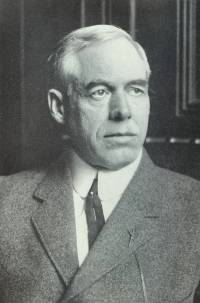
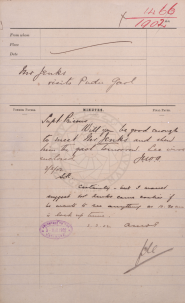
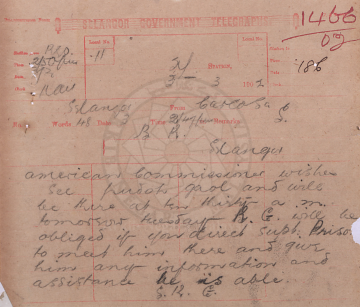
Kiri: “Jeremiah Jenks, circa 1912” (Wikipedia: Jeremiah Jenks).
Tengah & Kanan: Telegraf rasmi memohon persediaan pihak pengurusan penjara untuk menerima lawatan beliau.
Pada 4 Mac 1902, Profesor Ekonomi dan Politik Jeremiah Whipple (J.W.) Jenks dari Cornell University membuat lawatan rasmi ke Penjara Pudu atas kapasiti “American Commissioner”: “American Commissioner wishes see Pudoh Gaol and will be there at ten thirty a.m. tomorrow Tuesday. R.G. will be obliged if you direct Supt. Prisons to meet him there and give him any information and assistnace he is able. - S.R.G.” (PEJABAT SETIAUSAHA KERAJAAN NEGERI SELANGOR, 03/03/1902: |"MR. JENKS VISITS PUDU GAOL").
Liputan akhbar tentang lawatan ini:-
- “Professor Jenks, an high official in the United States service, is touring the Native States just now.” (Pinang gazette and Straits chronicle, 4 March 1902, Page 2: |"Tuesday, 4th March, 1902").
- “Professor J.W. Jenks, Professor of Political Economy and Politics at Cornell University , U.S.A., is visiting the Native States. We are told that “he has been through British India and Burmah and is visiting the Straits Settlements and the Federated Malay States, as a special Commissioner, on behalf of the United States Government, in order to make inquiries regarding the methods of Government here. He will, in particular, give special attention to the questions of imported labour, local taxation, and police.” (The Singapore Free Press and Mercantile Advertiser, 7 March 1902, Page 2: |"The Singapore Free Press. FRIDAY, MARCH 7, 1912").
1929-08-16: Memorandum Jaksa Pelawat
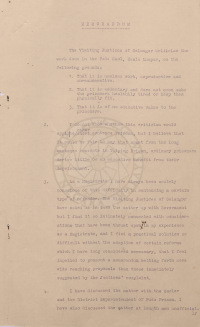
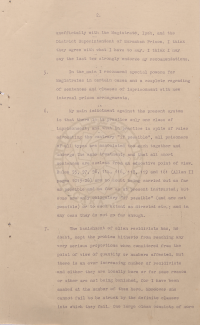
Para Jaksa Pelawat / Visiting Justices di Selangor telah membuat lawatan ke Penjara Pudu dan mengemukakan memorandum agar aktiviti banduan lebih produktif dan mendidik, selain menyihatkan. Cadangan ini telah pun maklum di kalangan para pentadbir penjara, dan mereka tetap berpendirian sebahagiannya tidak realistik, atas faktor-faktor tertentu: “The Visiting Justices of Selangor criticise the work done in the Pudu Gaol, Kuala Lumpur, on the following grounds: 1. That it is useless work, unproductive and unremunerative 2. That it is sedentary and does not even make the prisoners healthily tired or keep them physically fit 3. That it is of no educative value to the prisoners.” (PEJABAT SETIAUSAHA KERAJAAN NEGERI SELANGOR, 16/08/1929: |"(I) CRITICISM BY VISITING JUSTICES ON THE LABOUR DONE IN PUDU GAOL - (II) MEMORANDUM ON PRISON REFORM BY THE MAGISTRATE, KUALA LUMPUR: INFORMATION REGARDING THE CRITICISM AND SUGGESTIONS BY THE MAGISTRATE KUALA LUMPUR ON THE SENTENCES METED OUT TO PRISONERS AND THE NEED FOR PRISON REFORM CONTAINED IN HIS MEMORANDUM.").
1930-an: Kemakmuran Relatif
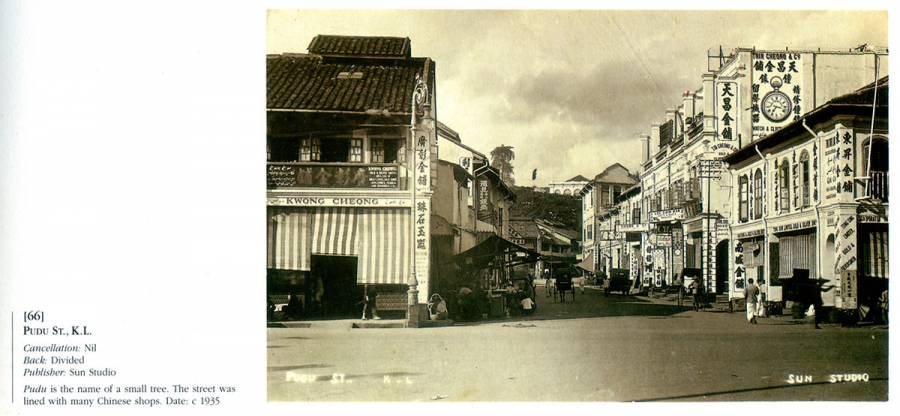
Jalan Pudu (1-2km ke sebelah barat laut Penjara Pudu), Kuala Lumpur, tahun 1935. Mahkamah di atas bukit itu kini Menara Maybank: “Pudu St., K.L. … Publisher: Sun Studio. Pudu is the name of a small tree. The street was lined with many Chinese shops. Date: c. 1935.” (Lostgens, September 2010: |"Pudu Community Art Project").
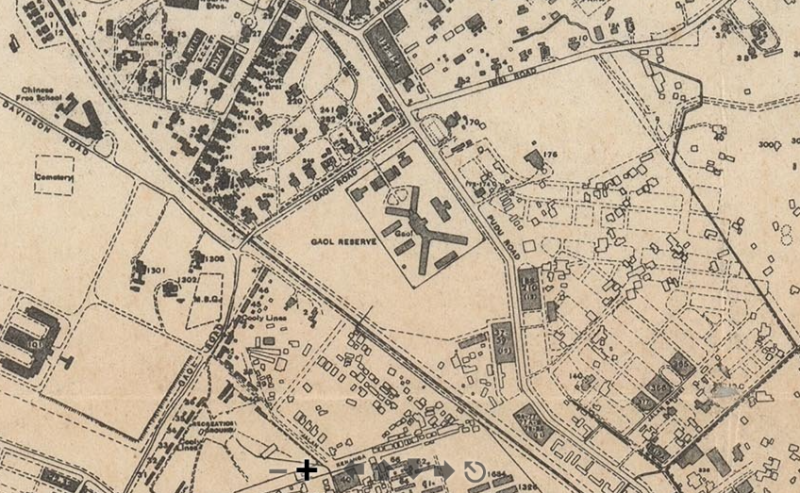
Peta lokasi Penjara Pudu di Kuala Lumpur, 1936, di sebelah selatan Jalan Gaol (kini Jalan Hang Tuah). Kelihatan kawasan rizab penjara di sebelah barat dan selatannya: “A very uncommon 1936 map of Kuala Lumpur, the capital of Malaysia, issued by Printers Ltd. of Singapore. This map is centered on the Kuala Lumpur City Center and the modern-day Central Market. It extends from the modern-day Perdana Botanical Garden (Public Gardens) east as far as Jalan Tun Razak (Circular Road). This map is based upon surveys completed by the Surveyor General of the Federated Malay States and the Straits Settlements. … This map was issued in Singapore by Printers Limited to accompany the Singapore and Malayan Directory of 1936. It is extremely rare to find any early maps of Kuala Lumpur, so this is an exceptional discovery.” (Printers Ltd. of Singapore @ Geographicus, 1936: |"1936 Printers Limited Map of Kuala Lumpur, Malaysia").
1942-1945: Penjara Tahanan Perang Jepun
Sepanjang tahun 1942-1945, Penjara Pudu menjadi pusat tahanan perang oleh pihak Jepun. Ramai ahli pasukan Perikatan dan orang tempatan diseksa dan dipancung di penjara ini, dan sebahagiannya dipamerkan kepalanya. Mayat mereka mungkin ditanam di sekitar hospital dan di belakang bengkel dobi. Tahanan perang menanam ubi keledek untuk dijadikan makanan mereka. Bilik seorang tahanan bernama Padre Noel Duckworth telah dijadikan gereja kecil untuk acara keagamaan setiap Ahad. “The prison became the central prisoners of war (P.O.W) camp in Malaya during the Japanese Occupation (1942-1945). Many members of the Allied Forces and locals were tortured and beheaded on prison grounds, some heads stuck to polls for all to see. They were believed to be buried around the hospital and behind the laundry workshop area. Sweet potatoes were planted by the P.O.Ws on the prison grounds for food. There was also a chapel created from a cell by a prisoner named Padre Noel Duckworth to hold Sunday services.”
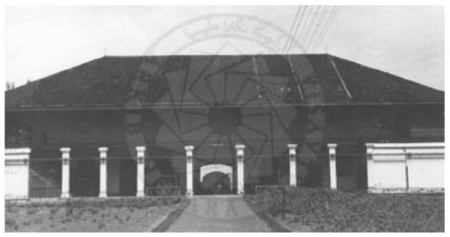
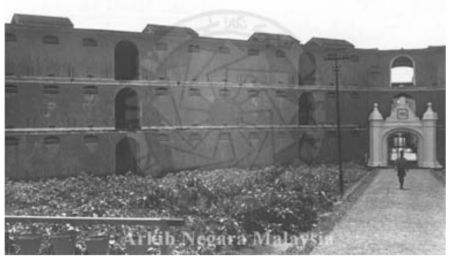 Kiri: “Figure 8: Pudu Jail’s Administrative Block (1946)”
Kiri: “Figure 8: Pudu Jail’s Administrative Block (1946)”
Kanan: “Figure 9: Sweet potatoes planted on the prison grounds (1946)”
(Sumber: Mariana Isa @ University of Bath, 2006: |"Pudu Jail Conservation Statement", m.s. 10-11).
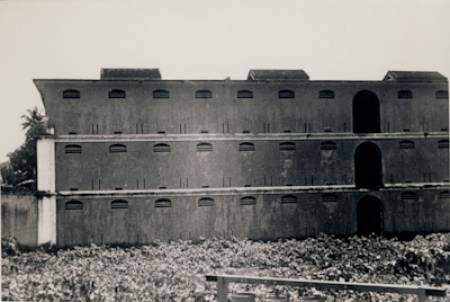
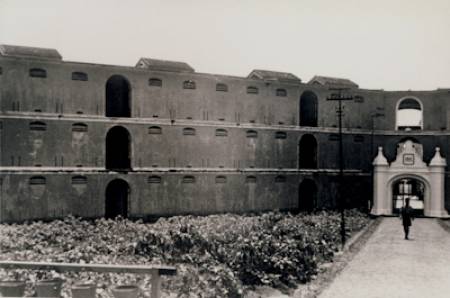
Kiri: “gambar 1941.RARE”
Kanan: “1940 pintu masuk kedua selepas pintu utama dihapan”
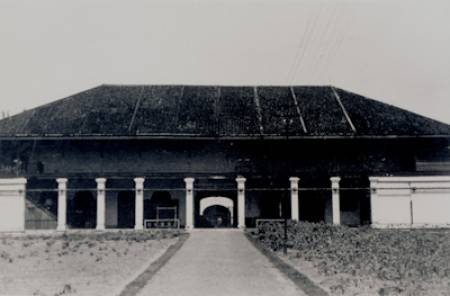
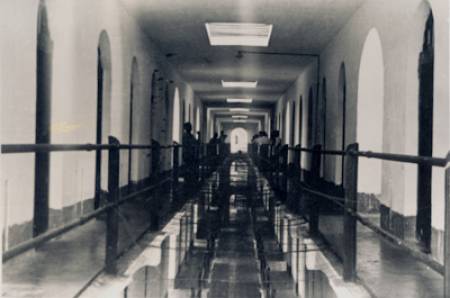
Kiri: “bahagian dalam penjara pada 1942,masih dikekalkan dengan sedikit penambahan sebelum dirobohkan pada 2010”
Kanan: “gambar diambil pada 1941,dan masih ada pada 2012”
(Sumber: Mohd Subhi Mohd Saleh, 10 Julai 2012: |"GAMBAR SEKITAR PENJARA PUDU").
Riwayat Bekas Tahanan
QX20158 McClaren, Robert Kerr @ 2/4th Machine Gun Battalion (1942): “Pudu originally housed about 350 British and Australian POWs and civilian prisoners. Another estimation put the figure at about 500 confined in buildings intended to house 70 prisoners during the British regime. Included amongst the numbers were soldiers captured in Malaya and escaped POWs from Singapore including Jock McClaren, Burnett and Wilkie who had all been together with Penrod Dean and Jock McGregor of 2/4th at a Chinese Guerrilla Camp in Malaya having escaped Singapore. Conditions were primitive and rations scarce with almost all prisoners suffering with beri beri, pellagra and other vitamin deficiencies. Lack of vitamin 3 resulted in ‘the four D’s’ – diarrhoea, dermatitis, dementia and death. Dysentery was rife with overcrowding. Initially the small outdoor areas were dug up to provide pit latrines which overflowed. Prisoners then switched to buckets. Fortunately POWs could volunteer for work parties that went into the city to load scrap iron and other materials intended for the planned Burma-Thai Railway – and where opportunities arose to scavenge food. Those too sick to to work were unlikely to survive. Known escapees were forbidden to work in the city – including McClaren, Burnett and Wilkie. They were trapped inside the overcrowded and disease-ridden gaol and knew they would be lucky to survive. Four Australians and 101 British died at Pudu between January to September 1942. Following the retreat in the face of Japanese advancement to Singapore, many soldiers were caught behind the front lines had lived in the jungle for months before being brought in; and were in dire physical condition. During October 1942 the POWs were moved to Changi, Singapore.”

“QX20158 McClaren, Robert Kerr (known as ‘Jock’) Enlistment photo.
Successful POW escapee from Singapore only to be captured in Malaya, imprisoned Pudu Gaol POW Camp before being returned to Singapore.”
(Sumber: 2/4th Machine Gun Battalion Ex Members Association, 17 Sep 2021: |"PUDU GAOL, KUALA LUMPUR, MALAYA").
Frank Larkin NX43393 & Charlie Edwards NX35590 @ 2/19th Battalion AIF (January - 30 September 1942): “During 1942 my father Frank was incarcerated in Pudu Gaol, Kuala Lumpur, Malaya, He was a guest of the Imperial Japanese Army following his capture during the Battle of Muar in January, 1942. … My father was in the gaol from late January 1942 through to the 30th September 1942.”
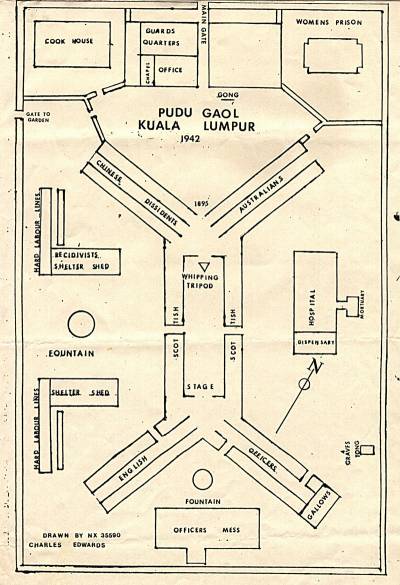
Lakaran Pelan Penjara Pudu oleh rakan tahanannya, Charlie Edwards: “Charlie Edwards, also a member of the 2/19th Battalion AIF with my father, wrote this account of life in Pudu Gaol in a letter to myself some years back. … Charlie Edwards drew a map of the gaol and he sent me a copy.”
(Sumber: John Larkin @ Prisoner of War: Frank Larkin NX43393 AIF, 12/06/2011: |"Pudu Gaol Kuala Lumpur").
1945-10-08: Selepas Pendudukan Jepun
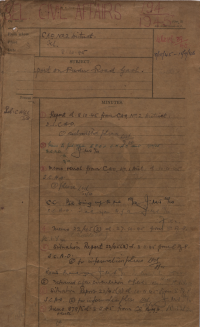
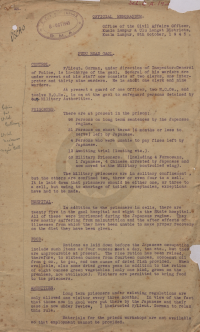

“There are at present in the prison:-
- 98 Persons on long term sentences by the Japanese regime.
- 21 Persons on short terms (6 months or less to serve) left by Japanese.
- 4 Persons who were unable to pay fines left by Japanese.
- 13 Awaiting trial (looting etc.).
- 69 Military Prisoners. (Including 4 Formosans, 1 Japanese, 4 Chinese arrested by Japanese and now moved to the Military controlled wing).”
(Sumber: PEJABAT SETIAUSAHA KERAJAAN NEGERI SELANGOR, 08/10/1945: |"REPORT ON PUDU ROAD GAOL: INFORMATION ON CASES OF PRISONERS IN PUDU ROAD JAIL AND ALSO DAILY SCALE OF RATIONS FOOD ORDERED BY THE INSPECTOR OF PRISON.").
1946-1957: Penjara Tahanan British
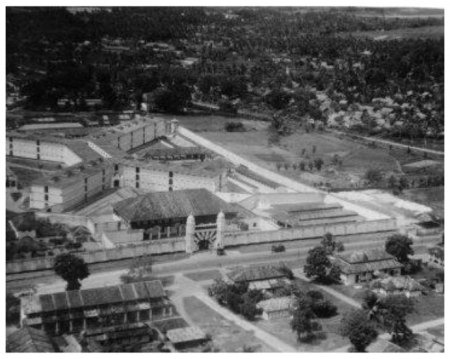

Kiri: “Figure 6: Pudu Jail in early 20th century.” (Mariana Isa @ University of Bath, 2006: |"Pudu Jail Conservation Statement", m.s. 10-11).
Kanan: “Pudu Jail (or was it called Pudu Gaol), Kuala Lumpur - Housing Japanese POW's after the end of WWII, probably in 1946.” (Vijaya Kumar Ganapathy @ Facebook: Classic Malaya & Malaysia, 17 September 2021 : "Pudu Jail (or was it called Pudu Gaol), Kuala Lumpur - Housing Japanese POW's after the end of WWII, probably in 1946.").
“Korperal Hamada dan Sarjan Yamamoto, merupakan tahanan jenayah Perang Dunia ke-2 yang dijatuhkan hukuman mati oleh tribunal tentera semasa perbicaraan pada hujung Januari 1946. Mereka adalah tahanan jenayah perang pertama yang dijatuhkan hukuman di Kuala Lumpur. Hukuman gantung dilaksanakan pada 12 Mac 1946 jam 8.06 pagi di Penjara Pudu kerana kekejaman yang menyebabkan kematian orang awam. Hukuman dijalankan secara serentak oleh Indian Troops. 5 minit selepas hukuman dilaksanakan, Leftenan J.D Wilson (Royal Army Medical Corps) mengesahkan banduan telah mati selepas pemeriksaan dijalankan. Hamada yang menggangotai Kempeitai Jepun (Polis Tentera) disabitkan kesalahan menyebabkan kematian 6 orang awam di Kuala Lumpur dengan menikam mereka menggunakan bayonet dan menghumban mayat mereka ke dalam sebuah rumah sebelum dibakar. Yamato turut disabit kesalahan sama di Kuala Lumpur, menyebabkan kematian seorang awam. sumber : The Straits Times, 13 March 1946” (Megat Kucing @ Santai Sejarah, 30 Januari 2020: "Korperal Hamada dan Sarjan Yamamoto").
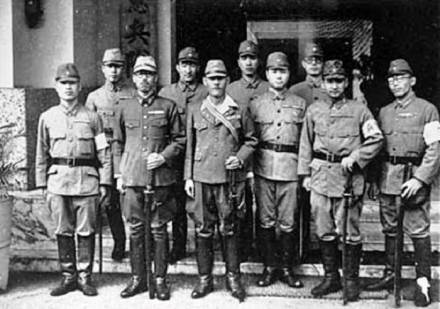
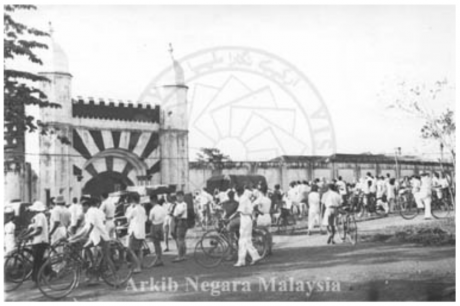 Kiri: “Satu perarakan lori terbuka mendedahkan bekas Kempeitai Jepun telah diadakan di Kuala Lumpur pada 30 September 1946 .” (Megat Kucing @ Facebook: Santai Sejarah, 7 Oktober 2021: "BEKAS KEMPEITAI JEPUN DIKECAM DI KUALA LUMPUR").
Kiri: “Satu perarakan lori terbuka mendedahkan bekas Kempeitai Jepun telah diadakan di Kuala Lumpur pada 30 September 1946 .” (Megat Kucing @ Facebook: Santai Sejarah, 7 Oktober 2021: "BEKAS KEMPEITAI JEPUN DIKECAM DI KUALA LUMPUR").
Kanan: Gambar sekitar 1946: orang ramai mengerumuni jenazah pesalah yang telah dihukum mati ketika dibawa masuk ke dalam lori: “Figure 16: A crowd gathers to watch the bodies of executed prisoners carried into lorries (1946).” (Mariana Isa @ University of Bath, 2006: |"Pudu Jail Conservation Statement", 15-16).
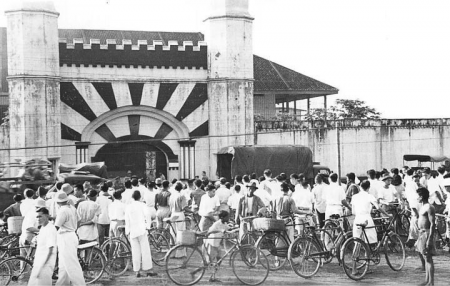
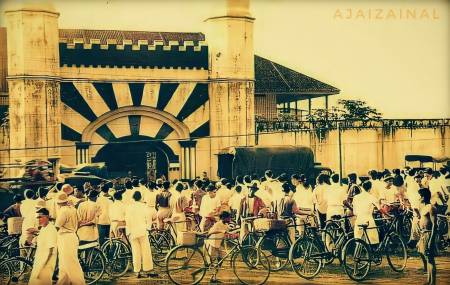
Kiri: “Pudu Jail, Kuala Lumpur. 1945. Foto: Tropenmuseum” (Melayu Tempo Dulu @ Facebook, 7 Disember 2016 : "Pudu Jail, Kuala Lumpur. 1945").
Kanan: “Foto 1945 - diedit semula” (Faizal Zainal @ Selangor 10, 1 Jun 2020: "Sekilas Catatan Tentang Penjara Pudu").
Latar gambar-gambar: “BEKAS KEMPEITAI JEPUN DIKECAM DI KUALA LUMPUR
Satu perarakan lori terbuka mendedahkan bekas Kempeitai Jepun telah diadakan di Kuala Lumpur pada 30 September 1946 . Orang awam ketika itu bersorak “bakeru/bagero” (bakayaro-perkataan menyumpah atau bodoh) diselangi dengan teriakan boo (teriakan mengejek) serta siulan mengecam mereka yang pernah berkuasa di situ semasa Pendudukan Jepun di Tanah Melayu.
Dalam perarakan dua buah lori ini, mereka dikawal oleh Military Police dan didahului dengan sebuah van yang lengkap dengan pembesar suara dari bahagian Public Relations. Ketika itu tahanan ini turut diikat semasa dipertontonkan kepada umum sepanjang jalan utama di Kuala Lumpur.
Pengumuman disiarkan dalam Bahasa Melayu, Cina, India dan Inggeris ini telah menarik perhatian umum terutamanya kepada mereka yang mempunyai bukti kekejaman dan pembunuhan oleh Kempeitai supaya tampil dan mendakwa mereka yang terlibat ini ke muka pengadilan.
Perarakan bermula jam 10 pagi dari Pudu Gaol (Penjara Pudu) dan tiba di Padang (Dataran Merdeka) dan diteruskan ke Pudu Road, Court Hill, Klyne Street, Malacca Street, Mountbatten Road, Cross Street, Foch Avenue, High Street, Market Square, the Embankment dan kembali ke Jalan Raja. Ketika kemuncak acara di Padang, Bahagian Jenayah Perang turut mencatat nama dan alamat mereka yang dikenal pasti sebagai tali barut Jepun.
Menurut sumber yang dipetik dari kajomag.com, Kempeitai merupakan Polis Tentera Jepun yang terkenal dari tahun 1881 hingga 1945. Di wilayah yang dijajah Jepun, pasukan polis ini bertugas menangkap dan menghukum mereka yang disyaki anti-Jepun.Terkenal dengan perlakuan kejam terhadap tahanan semasa Perang Dunia ke-2, sejarawan merujuk mereka sebagai Gestapo versi Jepun, iaitu polis rahsia Nazi Jerman. Mereka dilatih di bawah Kementerian Perang Jepun dan turut mempunyai manual soal siasat sendiri yang disediakan oleh pemerintah mereka.”
(Sumber: Megat Kucing @ Facebook: Santai Sejarah, 7 Oktober 2021: "BEKAS KEMPEITAI JEPUN DIKECAM DI KUALA LUMPUR").
Selepas perang, Penjara Pudu dijadikan penjara pejuang kemerdekaan seperti ahli Kesatuan Melayu Muda (KMM) dan Parti Kebangsaan Melayu Malaya (PKMM), antaranya Idris Hakim dan Mustapha Hussain: “The post war period saw the formation of local organizations fighting for an Independent Malaya such as the The Young Malay Union (KMM) and Malay Nationalist Party. A large number of nationalists were imprisoned in Pudu Jail by the British Administration, among them Idris Hakim and Mustapha Hussain.”
Hal ini menjadi salah satu hujah penting mengapa penjara ini harus dipulihara: “It is important to realize that within 100 years of serving as a prison, Pudu Jail’s inmates were not solely convicts but also servicemen and nationalists who fought against the Japanese and British for Malaya’s liberation. The prison’s key significance is the role it played towards the emergence of Malaysia’s nationhood.”
(Sumber: Mariana Isa @ University of Bath, 2006: |"Pudu Jail Conservation Statement", 15-16).
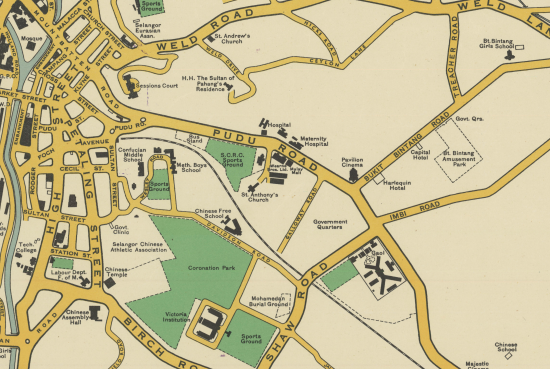
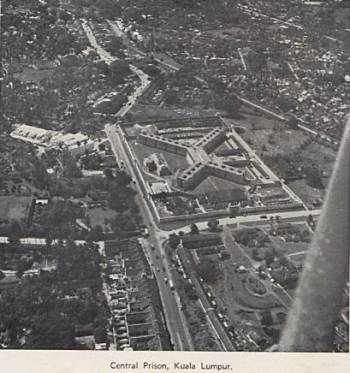
Kiri: Peta lokasi Penjara Pudu, 1950. Jalan Gaol di sebelah utaranya telah diberi nama Jalan Shaw (kini Jalan Hang Tuah): “Malaysia, Malaya, Kuala Lumpur, Sheet 47, 1950, 1:7 920” (Surveyor General, Malaya. Drawn and printed by the Survey Dept: Federation of Malaya @ The Australian National University, 1950: |"Malaysia, Malaya, Kuala Lumpur, Sheet 47, 1950, 1:7 920").
Kanan: “Pandangan dari Udara Penjara Pudu dalam tahun 1950” (Aku Budak Telok, 27 September 2022: |"Menyingkap Tirai Besi di Penjara Pudu: Pengenalan Merentas Masa").
Antara tokoh nasionalis yang dipenjarakan ketika itu ialah Ishak Haji Muhammad atau Pak Sako: “Allahyarham (Ishak Haji Muhammad atau Pak Sako) semakin aktif dalam politik dan menganggotai Parti Kebangsaan Melayu Malaya yang ditubuhkan dalam 1945 tetapi diharamkan tiga tahun kemudian berikutan perintah Darurat. Allahyarham ditangkap dan ditahan di penjara Pudu, Kuala Lumpur.”
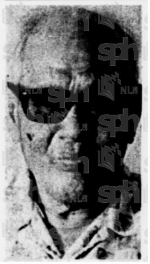
(Sumber: Berita Harian, 11 November 1991, Page 10: |"Perginya sasterawan nasionalis").
Antara pemimpin gerakan buruh yang telah dihukum di Penjara Pudu ialah S.A. Ganapathy. Beliau dihukum gantung pada 4 Mei 1949.

“Many of the leaders of the labour movement were arrested, charged, convicted and sentenced. SA Ganapathy, for example, who was the first president of the 300,000-strong PMFTU, was hanged by the British in May 1949. He was said to be on the way to the police to surrender a firearm he found, when he was arrested by the police and sentenced to hang in Pudu Jail.”
(Sumber: Charles Hector @ Malaysiakini, 18 Nov 2017: |"How the British suppressed the Malayan labour movement").
LATAR PERISTIWA: Penjara Pudu Selepas Jepun (1945-1957)
1953-03: Selangor Eurasian Association Clubhouse
Sekitar Mac 1953, Selangor Eurasian Association dianugerahi lesen pendudukan sementara (T.O.L.) di sebahagian tanah rizab Penjara Pudu di sebelah selatannya. Sebuah clubhouse telah didirikan di lokasi tersebut, dan ianya kekal sehingga selepas perobohan keseluruhan Penjara Pudu, iaitu pada 8 Oktober 2013:-
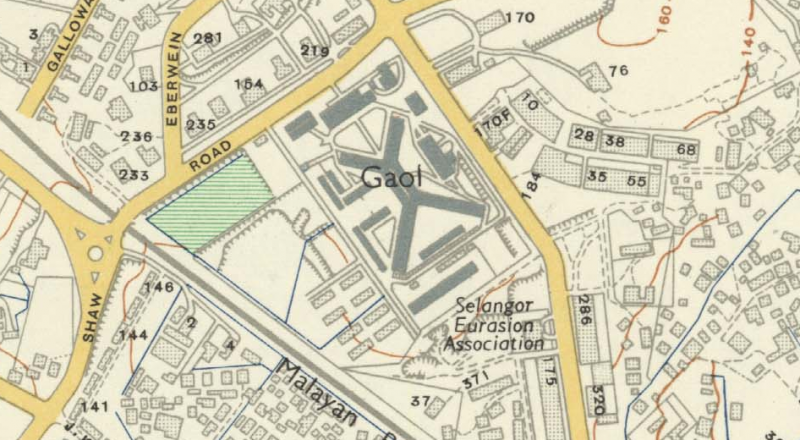
Peta lokasi Penjara Pudu, 1957. “Malaysia, Malaya, Kuala Lumpur, 1957, 1:380 160” (Surveyor General, Malaya @ The Australian National University, 1957: |"Malaysia, Malaya, Kuala Lumpur, 1957, 1:380 160").
Kelihatan di dalam peta di atas, “clubhouse” Selangor Eurasian Assocation (kini Selangor and Federal Territory Eurasian Association - SAFTEA) di tanah rizab Penjara Pudu di sebelah selatannya seluas 0.64 ekar.
Ringkasan sejarah clubhouse: “In 1940, the Selangor and Federal Territory Eurasian Association (SAFTEA’s earlier incarnation) was offered a licence to use a piece of land (of about 4 acres) in Maxwell Road. We could not accept the land at the time, as we could not afford to build a clubhouse then. After the war, the association wanted to accept the land, but it was then unavailable, as the military was using it. SEA was informed that the land would be available in 1955; according to records however, the association did not claim the land after this time. … We moved to the clubhouse at 167, Jalan Pudu in 1953, and have been here for 60 years; the area now occupied by SAFTEA is 0.64 acres.” (Selangor & Federal Territory Eurasian Association (SAFTEA), September 2013: |Saftea News, ISSUE 1 / 2013 Jan - Sept, m.s. 1-3).
LATAR PERISTIWA: Selangor Eurasian Association Clubhouse (1940-2013)
Selepas Merdeka (1957-1996)
“Mengikut rekod yang dikeluarkan oleh Jabatan Penjara Malaysia seramai 180 pesalah telah menjalani hukuman gantung sampai mati di jerut tali gantung di situ akibat pelbagai kesalahan berat dari tahun 1960 sehingga operasinya ditutup secara rasminya pada 31 Oktober 1996. Akta yang melibatkan hukuman mati ketika itu ialah Akta Senjata Api (Penalti lebih berat) 1971, Kanun keseksaan (Akta 574), Akta Penculikan 1961, Akta Senjata 1960, Akta Angkatan Tentera 1972 dan Akta Dadah Berbahaya 1952.” (Bebasnews, 05/06/2020: |"Penjara Pudu – Masihkah kau ingat lagi").
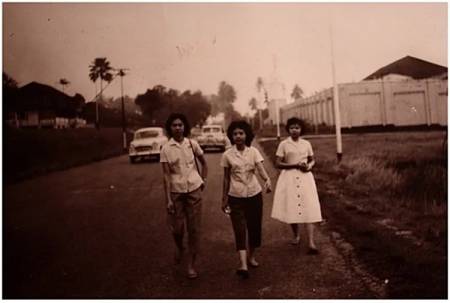
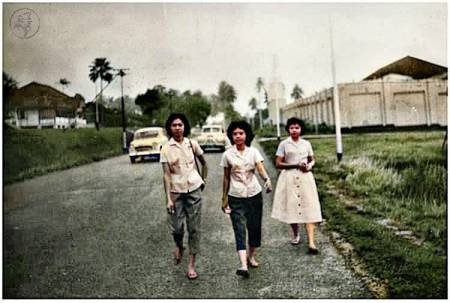
Kiri: Penjara Pudu dan Jalan Shaw (kini Jalan Hang Tuah), kemungkinan sekitar 1950-an: “Pudu Jail & part of Shaw Road (now Jalan Hang Tuah)” (taurus064 @ Skyscraper City, Jan 23, 2011: |"KUALA LUMPUR | OLD Pictorial Thread", m.s.14).
Kanan: “Walking at Shaw Road (Jalan Hang Tuah) and Pudu Jail - Kuala Lumpur, circa 1940's / 50's” (Vijaya Kumar Ganapathy @ Facebook: Classic Malaya & Malaysia, 30 Julai 2022: "Walking at Shaw Road (Jalan Hang Tuah) and Pudu Jail - Kuala Lumpur, circa 1940's / 50's").
Cebisan Peristiwa, Kakitangan, dan Tahanan: Penjara Pudu Selepas Merdeka (1957-1996)
1960-an: Pusat Tahanan Sementara
Mulai tahun 1960-an, Penjara Pudu hanya menjadi lokap sementara untuk tahanan reman serta banduan yang bakal dibebaskan: “From 1960, Pudu Jail only housed remand and pre-released prisoners.” (Mariana Isa @ University of Bath, 2006: |"Pudu Jail Conservation Statement", m.s. 14).
Rutin banduan Penjara Pudu: “The prisoner's day started at 10 o’clock on the day where they worked as tailors, cobblers and at the dhobi, but at night the prison came alive with activities. Secret deals were made via ‘night shooters’, where the prisoners would share information with other inmates by using what they called a blowpipe or in Malay ‘sumpit’ made from rolled-up newspaper and shoot paper bullets with messages (Inishah, 2011).” (Izzul Hafiy Rosli, Roslina Abdul Latif @ Taylor's University / International Journal of Research and Innovation in Applied Science (IJRIAS), Volume VI, Issue III, March 2021: |"Penjara Pudu: Demolished Prison of Dark Recollections").
1963-12-01: Kedai Penjara: “Sa-buah bangunan yang sederhana besar-nya dan berdinding kacha di hadapan-nya, bertentangan dengan pintu besar Penjara Pudu Kuala Lumpur, kini menjadi tumpuan pelawat2 - terutama dari luar negeri dan lebeh utama lagi orang2 Eropah. Bangunan yang saya maksudkan itu ia-lah 'Kedai Penjara'. Di-sini-lah segala hasil kerja tangan orang2 tahanan di-dalam penjara itu di-pamerkan dan di-jual. Berbagai jenis barang yang boleh di-buat oleh tangan manusia ada di-pamerkan di-situ - kebanyakan-nya alat dan perabut rumah - dari kerusi meja hingga kapada alat2 memasak di-dapor. Sa-orang pelawat dan bakal pembeli, malah boleh memesan dari sa-orang pegawai di-situ barang yang di-kehendaki-nya, jika apa yang di-hajati-nya tidak ada di-situ atau telah di-beli orang lain. Kedai itu di-kendali-kan oleh sa-orang pegawai yang bertauliah, di-bantu oleh tiga orang wader. Bile kita masok ka-kedai itu, yang mula2 menarek hati kita ia-lah susunan barang2-nya. Barang2 yang di-pamerkan di-situ di-susun rapi dan indah, tidak berbeda langsong dari barang2 yang di-pamerkan di kedai2 besar di-Ibu Kota itu. Tidak ada barang biar sa-kechil2-nya, yang di-buat oleh orang luar. Semua-nya di-hasilkan sendiri oleh orang2 tahanan penjara sendiri. Mereka membuat barang2 itu pada sa-belah petang sa-lepas habis mengerjakan tugas. Mereka pun tidak di-paksa membuat barang2 itu. Siapa yang tidak tertarek membuat-nya pada waktu yang di-khaskan (waktu di-ada-kan Hobby Class) di-benarkan bermain sukan. Segala bahan2 itu di-sediakan oleh Kerajaan. Dan apabila barang2 itu di-jual, wang-nya di-bahagi dua dengan orang2 yang membuat-nya. Wang itu akan di-simpan dahulu oleh pehak penjara. Dan apabila mereka selesai menjalani hukuman, wang itu-lah yang akan di-serahkan kapada mereka untok modal memulakan penghidupan baharu. Mereka di-lateh untok membuat barang2 itu oleh guru2 yang mahir dari segi pertukangan tangan. Guru2 itu di-gaji khas oleh kerajaan. Suatu hal yang menarek hati ia-lah harga barang2 itu lebeh murah dari harga barang2 yang di-jual di-kedai2 biasa. Hal ini mudah di-fahami. Dasar 'Kedai Penjara' ini bukan menchari untong, tetapi hanya untok menolong orang2 tahanan di-situ, memulehkan harapan dan memulakan hidup baharu sa-chara halal di-tengah2 masharakat yang akan menerima mereka kembali di-satu masa kelak.” (Berita Harian, 2 December 1963, Page 4: |"Kedai Penjara pemuleh harapan baru").
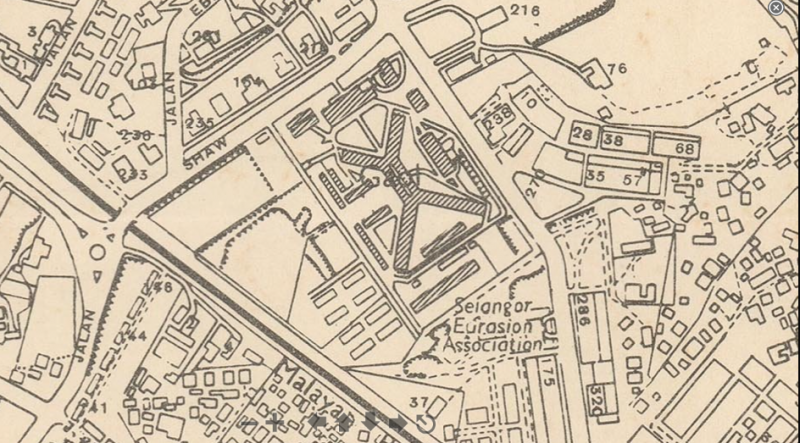
Peta lokasi Penjara Pudu, 1964: “A rare 1964 large-scale Survey Department of Malaya map of Kuala Lumpur, Malaysia. This map is centered on the Kuala Lumpur City Center and the modern-day Central Market. This map captures Kuala Lumpur's most dramatic period of urban expansion. At the base of the map various airlines, including SAS and Swiss, promote their services.” (Kerajaan Malaysia @ Geographicus, 1964: |"1964 Survey Dept. of Malaya Map of Kuala Lumpur, Malaysia").
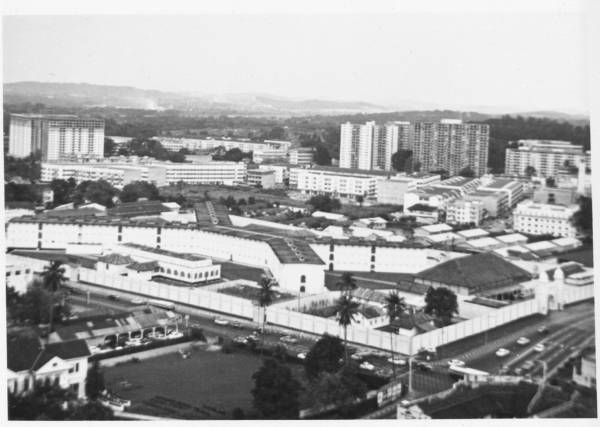
“Penjara Pudu dalam tahun 1960-an” (Sumber: Aku Budak Telok, 30 September 2022: |"Menyingkap Tirai Besi di Penjara Pudu (1895-1899)").
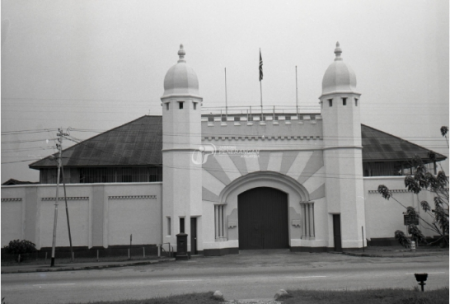
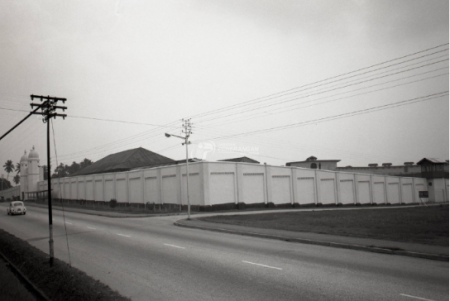
“View of Pudu Jail in 1967. Source: Jabatan Penerangan Malaysia” (rakan KL @ Facebook, 20 Disember 2016: "View of Pudu Jail in 1967").
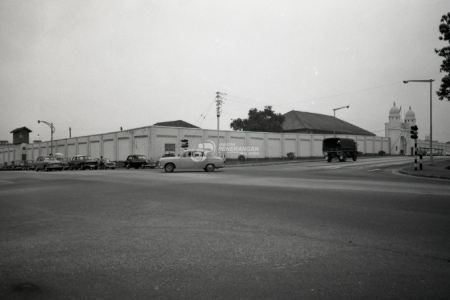

Kiri: “View of Pudu Jail in 1967. Source: Jabatan Penerangan Malaysia” (rakan KL @ Facebook, 20 Disember 2016: "View of Pudu Jail in 1967").
Kanan: “Pudu Jail - Kuala Lumpur, 1967” (Vijaya Kumar Ganapathy @ Facebook: Classic Malaya & Malaysia, 22 Disember 2022: "Pudu Jail - Kuala Lumpur, 1967").
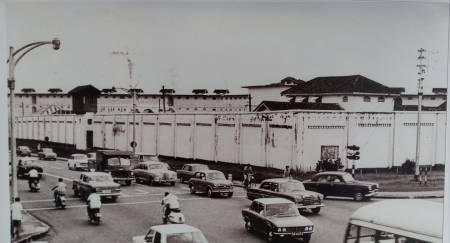
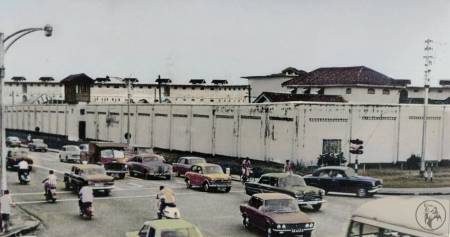
Kiri: “Pudu Prison/Pudu Jail, Kuala Lumpur: 1 November 1968 - NSTP News Image Bank @ Kuala Lumpur Photo Exhibition 2019” (Megat Kucing @ Santai Sejarah, 24 Ogos 2019: "Pudu Prison/Pudu Jail").
Kanan: “Pudu Jail, Kuala Lumpur. Pic > 01 Nov 1968 via C.y. Leong” (Vijaya Kumar Ganapathy @ Facebook: Classic Malaya & Malaysia, 26 April 2023: "Pudu Jail, Kuala Lumpur. Pic > 01 Nov 1968 via C.y. Leong").
1962-1971: Perancangan Awal Perobohan
1962-12-17: Ahmad Arshad adalah antara tokoh awal yang mencadangkan agar Penjara Pudu dipindahkan keluar dari Kuala Lumpur. Hujah beliau, selain ianya menakutkan pengunjung kota, ianya tidak sesuai untuk menjadi pusat pemulihan yang sempurna bagi tahanannya, oleh kerana kota di sekelilingnya semakin besar dan sesak: “Benar-kah penjara besar Pudu Kuala Lumpur itu sa-lama ini “menggerunkan” pelanchong2 dan pelawat2 luar ka-ibu kota? Menurut Inche Ahmad Arshad (Per: Muar Utara) ada-nya penjara itu di-tengah2 ibu kota ini memang menakutkan pelawat2 itu. Beliau kemudian-nya meminta supaya penjara itu di-aleh ka-suatu tempat di-luar ibu kota yang lebeh luas dan lebeh munasabah. “Ibu kota ini makin besar dan makin sesak. Kerana itu ada-nya penjara itu di-tengah2 kota ini tidak-lah munasabah,” kata-nya. Menurut-nya kalau dapat di-chari suatu kawasan yang lebeh luas untok orang2 tahanan itu, mereka dapat di-lateh lebeh sempurna untok menjadi ra'ayat yang baik bila keluar nanti.” (Berita Harian, 18 December 1962, Page 1: |"Mereka maseh di-soal, kata Menteri").
LATAR PERISTIWA: Dato' Ahmad Arshad: “Ahmad bin Arshad dilahirkan pada hari Isnin 06 November 1921 bersamaan 30 Ramadan 1339 H di Kampung Gudang Garam, Segamat, Johor. Mendapat pendidikan awal di Sekolah Agama Kerajaan Johor dan di Sekolah Melayu Laki-Laki Bandar Segamat. Selepas tamat persekolahan, beliau berkerja sebagai seorang guru agama di Sekolah Agama Kerajaan Johor. Beliau aktif dalam bidang politik dan turut berada di Istana Besar Johor Bahru ketika penubuhan United Malays National Organisation (UMNO). Beliau telah mengasaskan UMNO Bahagian Tangkak dan telah dipilih sebagai Ahli Parlimen Muar Utara dan pernah menjadi Ahli Dewan Negara. Beliau pernah mewakili Malaysia, berucap dalam Bahasa Melayu di Pertubuhan Bangsa-Bangsa Bersatu pada tahun 1970. Beliau juga bergiat aktif dalam bidang penulisan dan pernah menjadi penulis khas Majalah Juita di Negeri Sembilan antara tahun 1948 hingga 1950. Dato Ahmad bin Arshad telah kembali ke Rahmatullah pada hari Jumaat, 26 Mei 2000 bersamaan 22 Safar 1421 H ketika berusia 78 tahun.” (FotoGrafik Malaysia, 1 Nov 2022: "Siapa Sebenarnya Dato' Ahmad Arshad?").
1964-12-18: Menteri Dalam Negeri, Dato Dr. Ismail bin Dato Abdul Rahman menyatakan pihak kerajaan masih mencari tempat yang sesuai untuk memindahkan Penjara Pudu: “Menyentoh shor Inche Abdul Razak Hussin (PER-Lipis) supaya kerajaan memindahkan penjara Pudu di-Kuala Lumpur it ka-pada satu kawasan yang lebeh munasabah, Dato Ismail berkata chadangan ini sedang di-kaji sekarang. Soal-nya sekarang ia-lah untok menchari satu tempat yang sa-suai untok memindahkan penjara itu, kata-nya.”
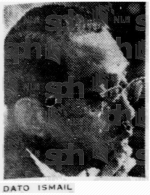
(Sumber: Berita Harian, 19 December 1964, Page 1: |"GAJI SAMA POLIS").
1965-12: Penyata Rancangan Pertama Malaysia antara lain mengandungi perancangan perobohan Penjara Pudu, dan bakal digantikan dengan penjara baru di Kajang: “Penjara Pudu di-tengah2 bandar Kuala Lumpur akan di-robohkan dan sa-buah penjara baru yang menelan belanja $8 juta akan di-bena di-Kajang. Demikian menurut Penyata Ranchangan Pertama Malaysia. Tapak kawasan Penjara Pudu sekarang akan di-majukan dalam bidang usaha2 pembangunan kawasan ibukota. Sa-jumlah $16.6 juta akan di-belanja untok membaiki penjara2 yang ada dan membuat barek (termasok $8 juta untok penjara baru di-Kajang).” (Berita Harian, 10 December 1965, Page 5: |"Penjara Pudu akan di-roboh di-ganti baru tapi di-Kajang").
1965-12-20: Perancangan Penjara Kajang diperincikan oleh Menteri Dalam Negeri, Dato Dr. Ismail: “Dato Dr. Ismail (Menteri Dalam Negeri) juga memberitahu bahawa dalam peruntokan kemajuan tahun hadapan bagi Jabtan Penjara, $200,000 telah di-sediakan untok menjalankan kerja2 pertama memindahkan penjara dari Pudu ka-Kajang. Pusat penjara di-Kajang ini akan menelan belanja $8 juta dan akan mengandongi ibu pejabat Jabatan Penjara serta pusat latehan warder di-samping sa-buah penjara yang moden. Penjara di-Kajang ini juga akan menggantikan Penjara di-Seremban. Dato D. Ismail menerangkan bahawa Kerajaan Selangor telah pun menyediakan sa-keping tenah seluas 202 ekar di-Kajang untok pembenaan penjara ini. Kerajaan jua menyedia-kan peruntokan $3 juta untok membena pusat tahanan negara di-Taiping. Pusat ini di-jangka akan siap dalam masa satu tahun.” (Berita Harian, 21 December 1965, Page 5: |"Lebeh banyak rumah untok anggota2 polis di-Malaysia").
1967-02: Pengumuman oleh Abdul Rahman Yaakob di Dewan Rakyat mengenai permulaan pembinaan penjara baru di Kajang pada tahun 1968, bagi menggantikan Penjara Pudu. Sementara itu, Penjara Pudu masih lagi dibaiki: “Kerja untok membena penjara baru yang berharga kira2 $8 juta akan dimulakan pada tahun depan. Penjara baru itu akan dibena di-Kajang kira2 15 batu dari sini, dalam sa-buah kawasan sa-luas 202 ekar, demikian sa-orang juruchakap Kementerian Dalam Negeri menyatakan hari ini. Juruchakap itu menambah bahawa tanah untok membena penjara baru itu telah di-beli dari Kerajaan Selangor berharga lebeh $30,000. Sa-lain dari membena penjara, rumah2 untok pegawai dan kakitangan, padang permainan dan sekolah latehan warder akan juga di-bena. Pengumuman untok membena penjara baru ini telah di-buat oleh Inche Abdul Rahman Yaakob, di Dewan Ra'ayat dalam bulan February tahun ini. Menurut-nya, penjara baru itu di-jangka siap dalam masa tiga tahun. Penjara yang ada sekarang di-Jalan Pudu telah berumor lebeh 70 tahun, bangunan itu di-bena dalam sa-buah kawasan yang luas-nya 37 ekar. Sementara itu kerja membaiki penjara Pudu sedang di-jalankan sekarang. Pagar2 berduri telah mula di-pasang di-atas tembok penjara itu yang tinggi-nya kira2 15 kaki.” (Berita Harian, 19 September 1967, Page 3: |"PENJARA BARU $18 JUTA TAHUN HADAPAN").
1969-01-12: Pengumuman oleh Menteri Besar Selangor, Dato Harun Idris, mengenai kemungkinan pemindahan Penjara Pudu ke Shah Alam: “Kerajaan Selangor akan berusaha menchari wang sa-banyak $12 juta untok memindahkan penjara besar di-Pudu ka-Ibunegeri Selangor yang baru bandar Shah Alam. Demikian kata Menteri Besar, Dato Harun Idris ketika beruchap dalam majlis Hari Raya yang di-hadhiri oleh kira2 400 orang di-rumah-nya Alang Bidara di-sini baru2 ini. Dato Harun menyatakan bahawa bangunan penjara itu kelak akan di-robohkan dan di-jadikan pusat perniagaan sa-baik sahaja telah di-pindahkan. Sa-belum itu Dato Harun menyatakan bahawa permohonan tanah di-Shah Alam akan di-keluarkan pertengahan tahun ini. Kilang2 dan rumah2 kedai akan di-dirkan di-situ sa-lepas itu.” (Berita Harian, 13 January 1969, Page 7: |"Selangor akan chari $12 juta untok aleh Penjara Pudu").
1969-02-07: Peruntukan pembinaan Penjara Kajang diluluskan: “Tuan Haji Abu Bakar Hamzah (Pas-Bachok) menda'awa bahawa layanan di-kemah tahanan Taiping sangat menyedehkan dan menyeru Kementerian membaiki-nya. Ketika membentang peruntokan itu petang semalam, Enche Bahaman (bin Shamsuddin, Menteri Keadilan) berkata bahawa sa-buah penjara baru yang besar akan di-bena di-Kajang tidak lama lagi. Penjara itu kelak akan mengantikan penjara Pudu dan Penjara Seremban. Enche Bahaman memberi jaminan bahawa keadaan layanan di-kemah2 tahanan akan di-baiki. “Bagaimana pun Kerajaan tidak-lah dapat memberikan kemudahan sa-penoh-nya kepada semua kemah2 tahanan kerana kekurangan wang.” Peruntokan itu kemudian di-luluskan.” (Berita Harian, 7 February 1969, Page 2: |"Menteri: Kita tunggu Jakarta").
1969-04-17: Dato Harun mengumumkan perancangan pelaksanaan pemindahan Penjara Pudu ke Kajang pada tahun 1970: “Kerajaan Selangor meranchang untok membena satu komplek perniagaan menelan belanja $200 juta di-Kuala Lumpur. Tapak komplek itu ialah di-kawasan penjara Pudu sekarang yang akan di-pindahkan ka-Kajang kelak. Demikian menurut Menteri Besar Selangor, Dato Haji Harun Idris dalam satu temuramah dengan Berita Harian hari ini. Komplek itu kelak akan di-lengkapi dengan segala kemudahan moden, kata-nya. “Kita harap projek ini akan dapat di-laksanakan dengan jaya-nya nanti. Ini-lah azam besar saya sa-lepas Perikatan di-pileh berkuasa sa-mula kelak. “Saya mahu ranchangan in menjadi sumber kewangan yang besar kapada Kerajaan Negeri dan dapat menampong banyak pekerjaan ka-pada ra'ayat,” kata Dato Harun. Menurut-nya, ranchangan untok memindahkan penjara Pudu ka-sa-buah kawasan 200 ekar dekat Kajang dapat dilaksanakan tahun depan. Kata-nya belanja mendirikan penjara baru di-Kajang itu di-taksirkan antara $10 juta hingga $12 juta dan Kerajaan Pusat telah pun bersetuju memberi pinjaman permulaan untok projek itu.” (Berita Harian, 18 April 1969, Page 1: |"Pusat perniagaan $200 juta di-Kuala Lumpur").
1971-05-22: Pengumuman pembinaan Penjara Kajang di bawah Rancangan Malaysia ke-2: “Penjara di-sini dan di-Pudu Kuala Lumpur, akan di-pindahkan satu kawasan baru yang menelan belanja berjuta2 ringgit di-Kajang di-bawah Ranchangan Malaysia kedua ini. Timbalan Menteri Hal Ehwal Dalam Negeri, Enche Mohamed bin Yaacob, menyatakan demikian kapada para pemberita di-sini hari nii ketika menamatkan lawatan-nya sa-lama tiga hari. Beliau menerangkan bahawa tapak penjara2 tersebut kemudian akan di-gunakan untok komplek tertentu oleh Kerajaan negeri masing2.” (Berita Harian, 23 May 1971, Page 3: | "PENJARA PUDU AKAN PINDAH KA-KAJANG").
1970-an: Kekal Beroperasi
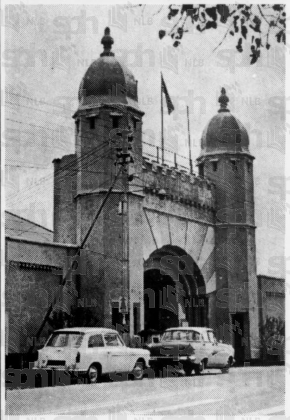
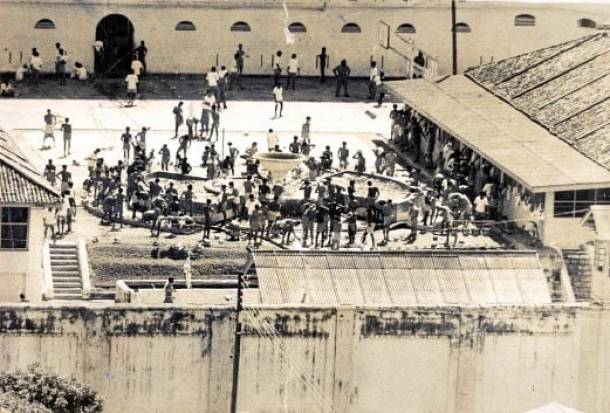
Kiri: “Gerbang Penjara Pudu, tahun 1971” (The Straits Times, 25 September 1971, Page 5: |"Page 5 Advertisements Column 2").
Kanan: “Gambar banduan di Penjara Pudu pada tahun 1975. - Foto NSTP” (Mohd Azis Ngah @ Berita Harian, 19 Ogos 2015: |"Pening layan helah banduan lolos empat kali").
Menara Pengawal
Pada tahun 1970-an, menara-menara pengawal telah dibina. Rekabentuknya mirip atap rumah Minangkabau dan kelihatan agak canggung di kalangan binaan kolonial di sekelilingnya. Namun berdasarkan hiasan ukiran kayunya, tujuannya adalah untuk menyumbang kepada perwatakan kota di sekelilingnya: “In 1970s, watch towers were built to a vernacular style with jagged edges and pointed roofs called the Minangkabau on the east and west prison walls. … The watch towers of 1970s sits rather awkwardly in the colonial prison. Nevertheless, they mark the early presence of Malaysia’s modern regional architecture. Wood carvings on the Minangkabau roofs are rare ornamentations for a prison, showing that the main intention was to contribute to the townscape’s character.”
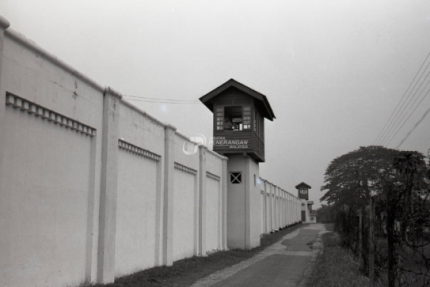

Gambar rekabentuk asal menara Penjara Pudu pada tahun 1967: “View of Pudu Jail in 1967. Source: Jabatan Penerangan Malaysia” (rakan KL @ Facebook, 20 Disember 2016: "View of Pudu Jail in 1967").
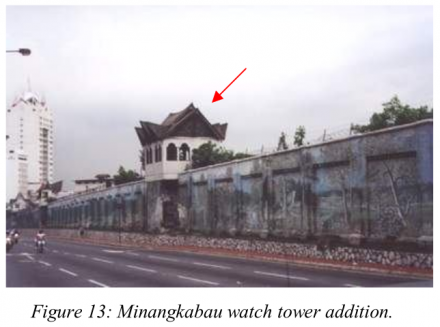
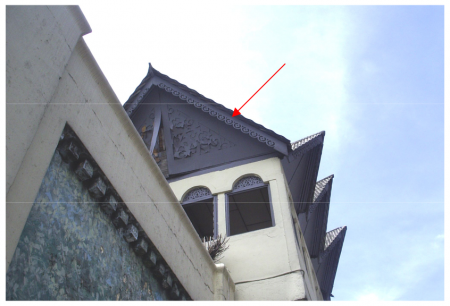
Kiri: Gambar menara pengawal berbentuk gaya Minangkabau, dari jarak jauh (2006): “Figure 13: Minangkabau watch tower addition.”
Kanan: Gambar menara pengawal dari jarak dekat (2006). Kelihatan ukiran kayu pada tingkap dan bumbung menara: “Figure 19: Visible wood carvings on the Minangkabau watch tower.”
(Sumber: Mariana Isa @ University of Bath, 2006: |"Pudu Jail Conservation Statement", m.s. 12, 14, 17).
Kawasan Sekitar Penjara Pudu, 1970-an
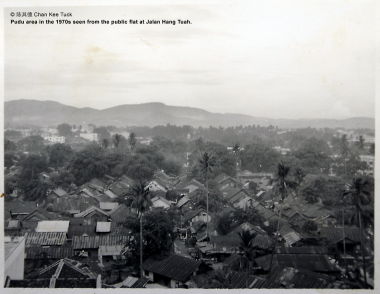
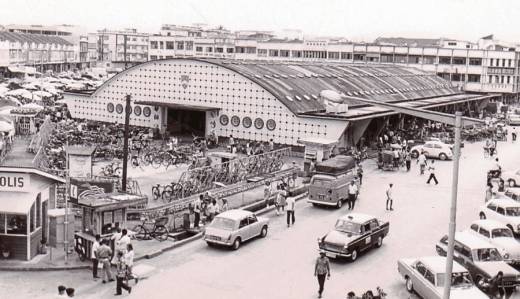
Kiri: “Pudu area in the 1970s seen from the public flat at Jalan Hang Tuah” (Chan Kee Tuck @ Kuala Lumpur Old Pictorial Threads at www.skyscrapercity.com @ Faridah / The Early Malay Doctors, 23 October 2014: |"Pudu Prison").
Kanan: “The iconic Pudu wet market in the early 1970s.” (Alan Teh Leam Seng @ New Straits Times, May 15, 2022: |"A glimpse into Pudu's past").
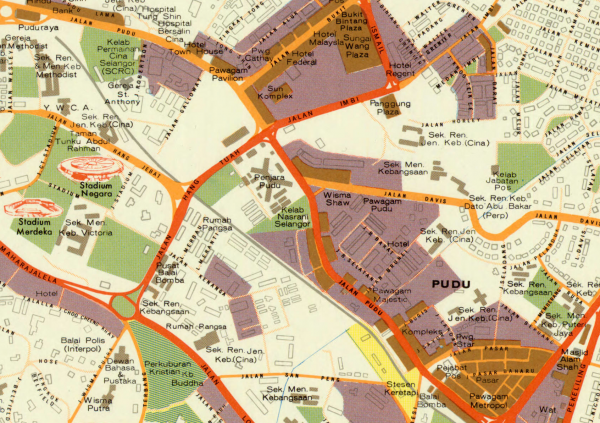
Peta sekitar Penjara Pudu pada tahun 1982. Jalan Shaw telah diubah nama kepada Jalan Hang Tuah: “Kuala Lumpur / diterbitkan oleh Pengarah Pemetaan Negara” (Jabatanarah Pemetaan Negara @ American Geographical Society Library, University of Wisconsin-Milwaukee Libraries, 1982: |"Kuala Lumpur / diterbitkan oleh Pengarah Pemetaan Negara").
1980-10: Penjara Pusat Selangor (Penjara Kajang)
Penjara baru di Kajang, yang dirancang sebagai pengganti Penjara Pudu sejak tahun 1960-an, akhirnya mula dibina pada tahun 1975. Mulai Oktober 1980, ketika penjara masih dalam pembinaan, 30 orang tahanan dari Penjara Pudu dibawa ke sana untuk kerja-kerja penyelenggaraan. Ia hanya beroperasi sepenuhnya sebagai “Penjara Pusat Selangor” pada pertengahan tahun 1985, kemudiannya dinamakan sebagai “Penjara Kajang”: “Penjara Kajang, Selangor yang dahulunya dikenali sebagai Penjara Pusat Selangor merupakan salah sebuah daripada 38 buah institusi penjara yang terletak di bawah pentadbiran Jabatan Penjara Malaysia. Ia terletak di kawasan Sungai Jelok, Kajang, lebih kurang 3 kilometer dari bandar Kajang. Penjara Kajang mula dibina pada tahun 1975 di atas tanah seluas 161.3 hektar dan beroperasi sepenuhnya pada pertengahan tahun 1985. Pada permulaannya Penjara Kajang hanya menempatkan seramai 30 orang banduan yang dibawa setiap hari dari Penjara Pudu, Kuala Lumpur pada bulan Oktober 1980. Mereka ditempatkan di Bahagian Pra Bebas dan ditugaskan untuk kerja-kerja kebersihan dan penyelenggaraan kawasan dan bangunan-bangunan penjara yang baru siap dibina.”
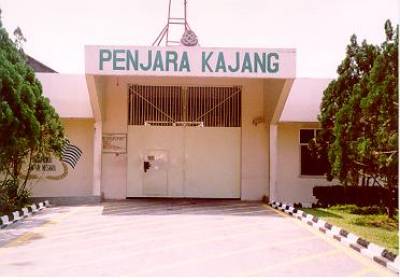
(Sumber: Jabatan Penjara Malaysia, 14 Jun 2021: |"Penjara Kajang").
1984: Lukisan Mural
Salah seorang tahanan Penjara Pudu, Khong Yen Chong, telah melukis mural di dinding luar penjara sepanjang 860 kaki dan setinggi 14 kaki. Beliau mengambil masa setahun untuk menyiapkannya, menggunakan kira-kira 2000 liter cat. Ia direkodkan di dalam Guiness Records sebagai mural terpanjang di dunia. Ia berperanan menampilkan imej yang lebih aman kepada pemandangan kota di sekelilingnya, juga turut dipengaruhi nilai Islami, berdasarkan ketiadaan lukisan makhluk hidup di dalamnya: “Kuala Lumpur expanded rapidly after the formation of Malaysia. Pudu Jail suddenly found itself in the heart of a bustling city centre. Perceived as being too grim for the cityscape, an inmate named Khong Yen Chong painted the outer prison walls with an impressive mural of tropical scenes as community service. The 860ft x 14ft mural took a year to complete using up to 2000 liters of paint. It was recorded in the Guinness Records as the longest mural in the world. … The mural paintings on the prison walls smoothens the relation of the prison with the cityscape. It is noted that the absent of sentient beings on the murals are influenced by the Islamic religion.” (Mariana Isa @ University of Bath, 2006: |"Pudu Jail Conservation Statement", m.s. 12, 14, 17, 21).
Menurut New Straits Times, beberapa banduan lain turut membantu, dan rekod dicatat ketika ia masih belum siap sepenuhnya: “Using some 2,000 litres of paint, Khong and other inmates painted a long mural depicting the country's tropical landscape, while serving his jail sentences in 1984. The mural, which was not completed at the time, earned a mention in the Guinness Book of Records for being the longest in the world.” (Esther Landau @ New Straits Times: August 20, 2020: |"NST175: For 100 years a city landmark").
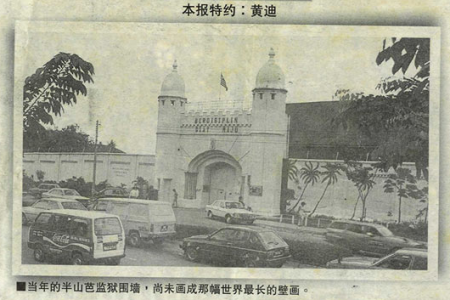
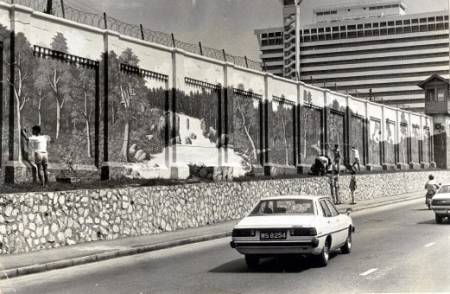
Kiri: Gerbang dan dinding Penjara Pudu, ketika mural masih dalam pembikinan (Nanyang Siang Pau @ Lostgens, 4 Mac 2001: "Goodbye Pudu Jail"))
Kanan: Kelihatan beberapa orang banduan sedang melukis mural di dinding Penjara Pudu, dengan diawasi para pegawai penjara: “Pemandangan di luar Penjara Pudu yang dihiasi mural, yang dilukis oleh penghuninya. - Foto NSTP” (Mohd Azis Ngah @ Berita Harian, 19 Ogos 2015: |"Pening layan helah banduan lolos empat kali").
Anugerah yang diperolehi oleh Khong Yen Chong: “The painting earned Khong the Guinness Stout Effort Award for “outstanding achievement in his world record work of art”.” (The Star, 17 Jun 2008: |"Pudu Prison a prominent landmark in the city").
Menurut pelakon Abu Bakar Juah, yang pernah bertugas di Penjara Pudu dari tahun 1975 hingga 1986, pencetus awalnya adalah cadangan beliau agar gerbang hadapan penjara dihiasi dengan taman batuan. Setelah itu, rakan setugasnya Mohd Rashidi Samsuddin mencadangkan agar dindingnya turut dihiasi mural: “Abu Bakar also had a small part to play in the painting of the mural on the outside walls of Pudu Prison. (The mural was recognised by the Guinness Book of Records as the world’s longest mural.) “It wasn’t my idea but it all started when I suggested making a rock garden along the length of the front wall,” he says, adding that the idea to paint the walls came from another officer, Mohd Rashidi Samsuddin.” (D. RAJ and JOSEPH LOH @ The Star, 27 Jun 2010: |"If the prison walls could talk").
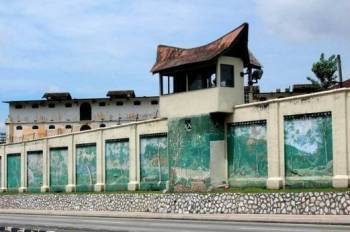
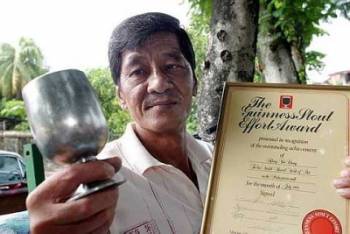
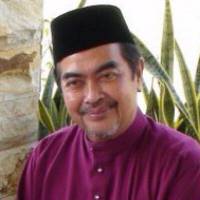
Kiri: “Mural sepanjang 384 meter dan tinggi 4.5 meter yang menghiasi tembok Penjara Pudu adalah terpanjang di dunia yang dilukis oleh penghuninya. - Foto NSTP”
(Sumber: Mohd Azis Ngah @ Berita Harian, 19 Ogos 2015: |"Pening layan helah banduan lolos empat kali").
Tengah: “Hard work: Khong Yen Chong showing the award he received for painting the mural when he was an inmate at the prison in the 1980s.” (STORIES JAYAGANDI JAYARAJ @ The Star, 17 Jun 2008: |"Mega development plan proposed for Pudu Prison land").
Kanan: Abu Bakar Juah (Tengku Suzana Raja Mamat @ Kosmo, 15 Ogos 2020: |"Seniman Abu Bakar Juah meninggal dunia akibat kanser").
Selepas beliau dibebaskan dari penjara, Khong masih terus menyambung muralnya: “Khong was so dedicated to his work that even after he was released from prison as a free man, he returned simply to ensure the mural would be completed.” (Noel Wong @ FMT Lifestyle, Free Malaysia Today, August 29, 2022: |"5 strange facts about Malaysia’s infamous Pudu Jail").

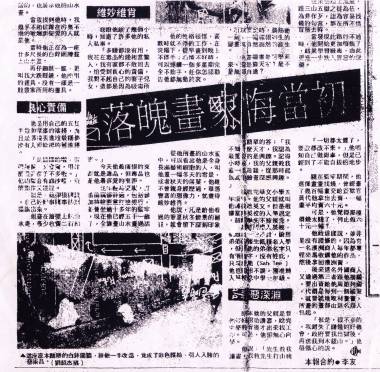
Keratan akhbar New Life Post新生活报 24.2.1993: liputan mengenai Pang Sun Qiang atau Pha Tee: “New Life Post新生活报, 24.2.1993 Wednesday: Five Fingers Painted The Famous Walls by Li You (李友)”
Menurut akhbar New Life Post新生活报 24.2.1993, salah seorang banduan yang turut sama melukis mural ini ialah Pang Sun Qiang atau Pha Tee. Beliau mula melukis di dalam penjara, menggunakan kaedah luar biasa seperti menggunakan jari-jemarinya sahaja. Beliau menjual karya-karyanya kepada wardennya, yang kemudiannya menjual kepada peminat seni warga Australia. Beliau pernah ditawarkan kerja oleh warga Australia tersebut, untuk melukis pemandangan di serata dunia, namun beliau tidak dapat menerimanya: sejurus selepas dibebaskan, beliau dihantar pula ke Pulau Jerejak, Pulau Pinang: “Five Fingers Painted The Famous Walls by Li You (李友): Who will come to their mind when they look at this sloppy looks Pang Sun Qiang (directly translate from mandarin name) is one of the painter of the Pudu Jail’s wall, mural painting at Country Heights Kajang and developing urban residence. … He only started to paint when he was imprisoned and manage to make it as his survivor skill. He sends few hundred paintings to the warder to please him for sells. The warder paid him sixty ringgit per painting only. He knew his artworks worth more than that amount because of there’s an Australia Merchant acted as an art dealer came to Malaysia to buy his artworks then sold his artworks in Australia. This Australia benefactor even went through a middle man to approach him again and wished to offer him to travel to the world, in return Phang must paint each country’s sceneries to him. “Unfortunately I miss this glorious opportunity because of I was sent to Pulau Jerejak, Pulau Pinang just after bailed from jail.” His voice resonant…”
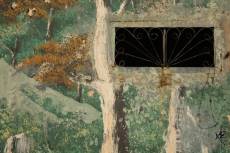
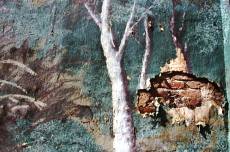

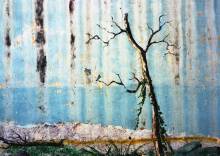
Gambar-gambar sebahagian mural Penjara Pudu ini diambil oleh NZ Phang, anak saudara Pha Tee yang hanya mengenalinya melalui pengkisahan bapanya. Menurutnya, beliau seorang yang berbakat besar dalam melukis namun terjebak dengan dadah dan jenayah di usia muda. Setelah dipenjarakan, kesihatan beliau merosot (muka lebam akibat kesan jangkitan, dan sebelah kaki dipotong). Ketika Sukan Komanwel 1998, bahagian sempadan dinding dicat putih lalu merosakkan sedikit impak mural, malah setelah itu diconteng pula dengan grafiti: “Note: photographed and note by NZ: Pudu Jail the wall,i found my memory on it … Second uncle whom I never touch but only through the verbal narrative from my dad: Among the brothers and sisters, he is the brightest. He not only inherit tidy and beautiful handwriting but also talented in drawing and painting. … Through my dad’s words of mouth, just I knew about my second uncle is the chic and tongue Pudu Jail mural painter. … My dad used to live together with my second uncle and witnessed him painted on the wall in his room with his own fingers. At that time my dad still naïvely to ask him: “What are you doing?” and the result was the wall ended up with full of my second uncle’s finger print. … The first time and also is the last time I met him, he doesn’t looks good. He has to lose one leg and has a swollen face due to heath problem. I think I probably only four to five year old and I still remembered my mom brought him food. It is a strange feeling, although he wore like a beggar but intuitively told me that he is my relative. … Every time I passed by the mural, I will announce to my accompanies the facts of my uncle is the painter and the unique way how he painted the wall. The feed back always is: “aren’t the wall is painted by the prisoners?” and every time I will affirm to them: “Yes! He was.” … Before the demolition, the mural is a history; so do as after the demolition but also become a legend, because of the wall wasn’t there anymore. … Time passes and it become really painful because of there is no cares and restoration vice versa it was being abused all along the time. Since 1998 Commonwealth Game, City Hall had painted the divider of the wall into white; numerous of white frames along the wall had ruined the originality and spoiled the visual aesthetic, even the anonymous did the graffiti on it in recently.”
“After all, I’m very thankful to NZ’s effort to approach Diana Phang Lai Peng, daughter of Pha Tee and let us have a glimpse to this respective family who have went through so much where we can’t imagine.”
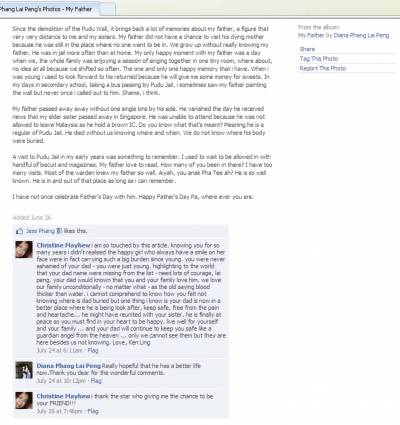
“Diana Phang who prefer stay low profile generously giving her true senses into words and posted on facebook as the response to this informal interview.”
(Sumber: Tan Hui Koon, 22 December 2010: |"Sebukit Bintang : Stars On The Hill").
Perihal Pang Sun Qiang atau Pha Tee ini turut diceritakan oleh Helen Ang (NST, 21 April 1994): “Let me share with you something I wrote in NST on April 21, 1994. It’s about ex-convict Pha Tee, the man on crutches with one leg amputated. A former drug addict, Pha had been in and out of jail most of his adult life, serving his first term in 1963 and last released 1990. His daughter recalled she sometimes saw her father painting the Pudu mural when she passed by the prison; “I wished then that I could have stopped and talked to him.” In the photo, the right side of Pha’s jaw is swollen ”“ “due to an infection which began when a fish bone stuck in his gum. In an attempt to cure the ailment he had extracted several of his teeth, using a string to pull them out”. Pha earned his living through menial work, scavenging cables and electrical wires from abandoned buildings or collecting scrap metal. According to Pha, the other artists who worked on the mural ”“ and whom he remembered ”“ were Khong Yen Chong, Cheng Tai Cheng, and Lee Kim Seng. At the time I interviewed him in 1994, Pha said he’d painted murals on a block of flats in Jalan Pandan, another on a fence in a back lane behind Jalan Talalla, hotel in Perlis and factory in Terengganu. As for my article headline; Pha said covering the prison walls with scenes from his captive imagination allowed him to remember the jungles and streams from his younger days, and gave him a transient feeling of ”˜freedom’. “We worked outside from morning until early afternoon but the guard was always there, and so you always knew you had to go back inside.””
Petikan di atas disampaikan oleh Pamela Lim di dalam blognya, bersama dengan anekdot beliau sendiri: “In the 1980’s, there would be a man, with buckets of paints, preparing to spread the wall with a white emulsion. I watched in fascination as daddy sends us to school & most often we get stuck in traffic along Jalan Pudu. The earth-coloured walls would take on panel by panel of white paint, much like what the art teacher taught us to lay down a foundation before your work of art goes onto the paper. Over the weeks, these white walls were soon taking on a greenish hue, multi-tones of turquoise & stops where the outline of what seemed to be tree trunks, took place. As the branches were drawn, I could only imagine that the artist was painting a jungle – totally befitting of how the area derived its name from. Pudu in Cantonese is called Pun San Par, meaning ”˜half jungle.’ With my windows down, I would watch this artist accompanied by a uniformed watchmen, with fascination as he laid the intricacies of the mural with his fingers & hand! He paid no attention to the buses & vehicles plying the route & went on to paint from morning till whenever. This stretch of 394m vertical facade made the entry to the Guinness Book of World Records for the longest mural on earth. Week by week, the walls transformed into a beautiful work of art that was vibrantly standing in the heart of the Golden Triangle. Sceneries of the beach & seaside was also captured on the Jalan Hang Tuah’s section of the wall. Although several people worked on this mural according to Helen Ang who wrote in the NST on April 21, 1994, only one person (Khong Yen Chong) got the recognition for it.”
(Sumber: Pamela Lim @ Pummkin's Pitch, 23 Jun 2010: |"The Pudu Prison Walls of Hope").
Rekabentuk lukisan mural adalah bergaya modenis awal 1980-an: “San-serif font used on all signages and wayfinding in Pudu and serif fonts used on manually painted information graphics. The styles of the murals capture an era of dictatorship, the modernist design culture in the early 1980s.” (Malaysia Design Archive: |"The Marginalia of Pudu Jail").
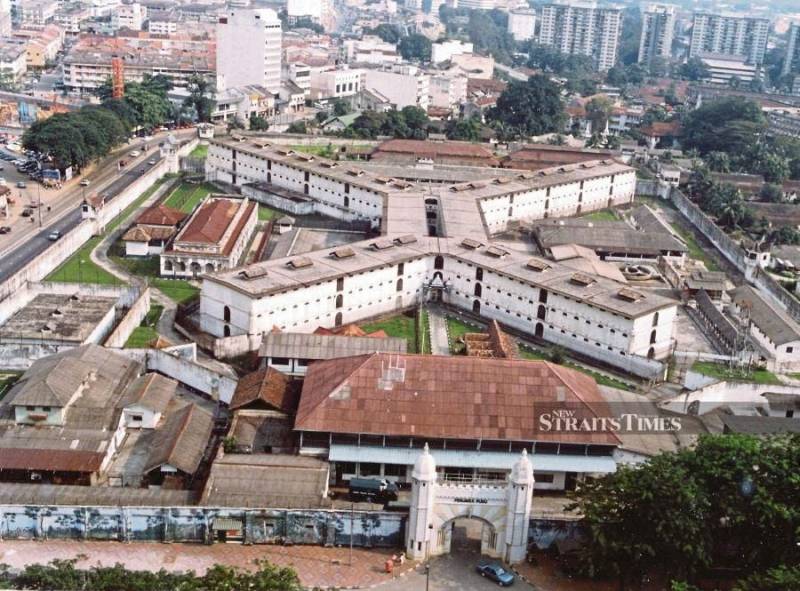
Gambar ini dilaporkan sebagai tahun 1975, namun kewujudan mural di sepanjang dinding menyatakan sebaliknya: kemungkinan pertengahan 1980-an sehingga 1990-an: “An aerial view of Pudu Jail in Jalan Hang Tuah, Kuala Lumpur, taken on April 16, 1975. - NSTP/File pic” (Esther Landau @ New Straits Times: August 20, 2020: |"NST175: For 100 years a city landmark").
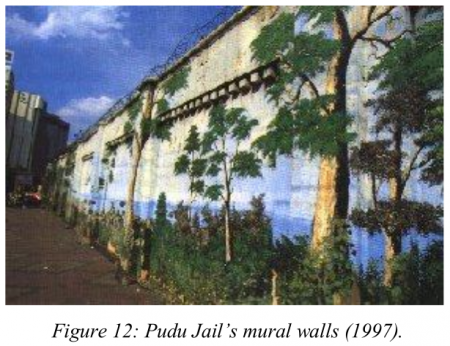
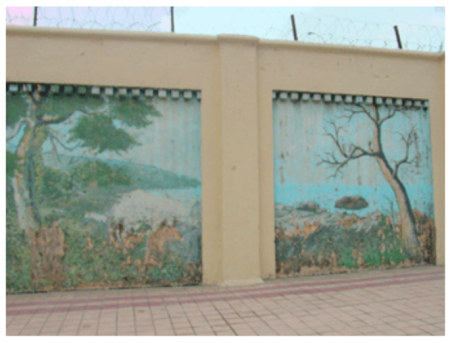
Kiri: Sebahagian mural pada dinding luar penjara (1997): “Figure 12: Pudu Jail’s mural walls (1997).”
Kanan: Sebahagian mural pada dinding luar penjara (2006). Kelihatan cat yang kian pudar: “Figure 22: Present mural walls of Pudu Jail. Paint condition is poor. New overcoat deemed unsuitable.”
(Sumber: Mariana Isa @ University of Bath, 2006: |"Pudu Jail Conservation Statement", m.s. 12, 14, 17, 21).
1985: Kesesakan Banduan
Pada tahun 1985, Penjara Pudu mengalami masalah kesesakan paling teruk, sehingga 6,550 orang tahanan terpaksa bergilir-gilir tidur dalam hanya 950 bilik tahanan: “There was a serious overcrowding problem in 1980s when it housed more than 1,300 prisoners. The worst happened in 1985 where 6,550 prisoners accommodated in the 950 cells had to take turn to sleep.” (Mariana Isa @ University of Bath, 2006: |"Pudu Jail Conservation Statement", m.s. 14).
Menurut Haji Aziz Haji Idris (pegawai di Penjara Pudu pada tahun 1965-1970, kemudian dilantik sebagai pengarahnya bagi tahun 1987-1991), sebelum Penjara Kajang dibina, Penjara Pudu merupakan satu-satunya pusat penjara di Malaysia, yang menerima banduan sejauh Perak dan Pahang. Ketika krisis kesesakan banduan berlaku, setiap bilik tahanan dimuatkan seramai 11 orang, dan mereka terpaksa tidur bergilir. Tingkapnya yang kecil (2 kaki lebar), dan kegunaan baldi plastik sebagai tandas, menyebabkan bau busuk:“Haji Aziz Haji Idris had two stints in Pudu Prison – the first from 1965 to 1970, and returning as its director from 1987 until he retired in 1991. He says that there were quarters for staff across the road, which was not as busy then. The staff would assemble in the morning and march across the road, and traffic had to stop for them to cross. … Aziz also remembers how bad the conditions in the jail were in the early 1980s. “Before Kajang Prison was built, it was the centre of incarceration for Malaysia. We used to get prisoners from as far away as Perak and Pahang. “At its worst, there were 5,000 to 6,000 prisoners in a prison that was only meant for 800,” he says. He describes the cells as being very small and meant for a single person, but they had to place 11 people in there. “It was so bad they had to sleep in shifts. Furthermore, there was hardly any ventilation, just a window about two feet wide. They had to use a plastic pail as a toilet, and when you opened the door to the cell, the stench was overpowering.”” (D. RAJ and JOSEPH LOH @ The Star, 27 Jun 2010: |"If the prison walls could talk").
Menurut pengalaman penulis di BebasNews: “Tahun 1985 juga menyaksikan kesesakan teruk berlaku di semua sel bilik dalam penjara ini yang padat memaksa mereka tidur secara bergilir-gilir sehinggakan ada yang bersuara di tengah malam meminta belas ihsan, “cikgu, tolong! kami tidak boleh tidur.” Bayangkan bagaimana keadaan mereka seramai belasan orang sepatutnya untuk lima orang banduan sahaja, boleh duduk di dalam sebuah sel, keluasannya lebih kurang 5×15 kaki yang panas sampai berpeluh badan, ada yang tidur kepalanya berhampiran tong najis. Dalam sel bilik penjara ini tiada tandas atau jamban, setiap bilik dibekalkan tong najis kecil berwarna hitam sekiranya hendak membuang air besar dan setiap pagi mereka akan keluar dan wajib mengangkut tong najis di sel masing-masing untuk dibersihkan. Setiap hari wadar penjara bertugas akan membuat rutin pemeriksaan khas dan membuka bilik pada jam 7.00 pagi, mahu tidak mahu terpaksa menghirup udara yang keluar dari bilik banduan amat kurang menyenangkan, rasa tidak tahan dengan bau badan mereka yang cukup menusuk hidung!. Ketika itu, mereka masih lagi boleh menunaikan tanggungjawab mengawal banduan seramai itu walaupun pihak berkuasa penjara menghadapi masalah kekangan kekurangan anggota.”
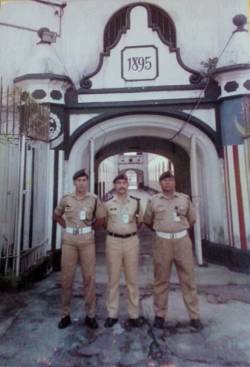
(Sumber: Bebasnews, 05/06/2020: |"Penjara Pudu – Masihkah kau ingat lagi").
1993-1994: Rakaman Jabatan Penjara
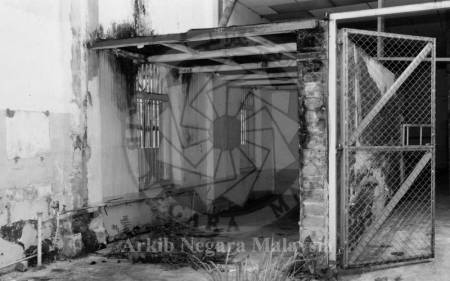
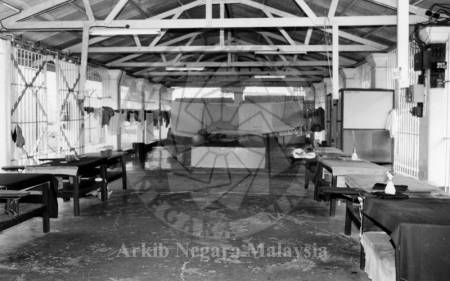
Kiri: “BAHAGIAN DALAM MAHKAMAH PENJARA PUDU, 10 NOVEMBER 1993.” (JABATAN PENJARA MALAYSIA, 10/11/1993: |"BAHAGIAN DALAM MAHKAMAH PENJARA PUDU, 10 NOVEMBER 1993").
Kanan: “RUANG DALAM DOBI PENJARA PUDU, 9 FEBRUARI 1994.” (JABATAN PENJARA MALAYSIA, 09/02/1994: |"RUANG DALAM DOBI PENJARA PUDU, 9 FEBRUARI 1994").
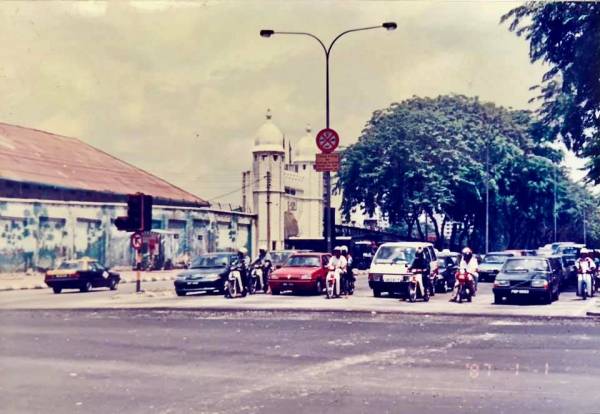
Gambar bahagian luar Penjara Pudu, kira-kira setahun sebelumnya: “View of already-demolished Pudu Jail, located along Jalan Hang Tuah (formerly Shaw Road); 1992. Just ignore the time-stamp on the photo since the time-stamp on the author's dad's camera was not adjusted when this photo was taken.” (taurus064 @ 1 Jun 2021: | "KUALA LUMPUR | OLD Pictorial Thread", m.s. 288).
1996-10-31: Penutupan
Penjara Pudu ditutup secara rasmi pada 31 Oktober 1996, setelah kesemua banduannya dipindahkan ke Penjara Sungai Buloh yang telah dibina di tapak Estet Perclairdon, Rawang (diwartakan sebagai tapak penjara sejak 2 Julai 1992 lagi): “Perancangan pembinaan Penjara Sungai Buloh bermula pada tahun 1992 setelah tapak penjara ini diwartakan pada 2 Julai 1992 iaitu di atas sebahagian Lot. 1450, Estet Perclairdon, Mukim Rawang, Daerah Gombak, Selangor dengan keluasan 126.6 ekar. Pembinaan penjara ini adalah bagi menggantikan Penjara Pudu yang telah ditutup secara rasminya pada 31 Oktober 1996 di atas faktor ketidaksesuaian lagi ianya beroperasi kerana pembangunan yang pesat di kawasan persekitaran serta tidak mampu untuk menanpung jumlah banduan yang semakin meningkat. Konsep pembinaan Penjara Sungai Buloh dilaksanakan secara penswastaan oleh Perbadanan Pembangunan Bandar (Urban Development Authority @ UDA) yang melibatkan kos berjumlah RM 172,000,000.00. Penjara ini mula beroperasi secara rasminya pada 1 November 1996.” (Institusi Penjara Malaysia: |"Penjara-Penjara").
Menurut The Nut Graph (dari sumber Jabatan Penjara), Penjara Pudu diserahkan kepada Perbadanan Pembangunan Bandar (Urban Development Authority @ UDA) pada 2 Mei 1996 lagi. Namun ia kekal sebagai penjara sehingga kesemua banduan dipindahkan ke Penjara Sungai Buloh pada November tahun itu: “The Prisons Department of Malaysia, when contacted by The Nut Graph, confirmed that Pudu Jail was handed over to the UDA on 2 May 1996, but continued to serve as a prison until all convicts were transferred to Sungai Buloh Prison in November that year.” (Nick Choo @ The Nut Graph, November 30, 2009: |"Remembering Pudu Jail (Updated 1 Dec 2009)").
1997-05: Muzium
Pada Mei 1997, Penjara Pudu dibuka sebagai Muzium Sementara Penjara Pudu, yang menerima kunjungan seramai 500,000 orang pengunjung setiap tahun. Pelan pembangunan awal telah ditunda akibat daripada krisis ekonomi Asia pada tahun itu.

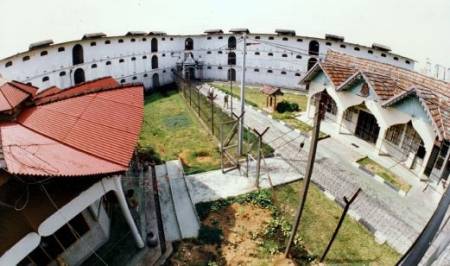
Kiri: “Penjara Pudu kini dibuka untuk orang ramai. - Foto NSTP”
Kanan: “Suasana di dalam Penjara Pudu. - Foto NSTP”
(Sumber: Mohd Azis Ngah @ Berita Harian, 19 Ogos 2015: |"Pening layan helah banduan lolos empat kali").
“Pudu Jail was opened as Pudu Prison Temporary Museum in May 1997, attracting around 500 000 visitors a year. Initial development proposals were called off due to the Asian 1997 economic crisis.”
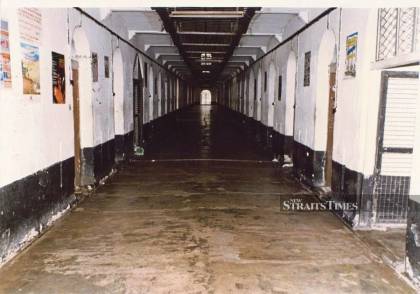
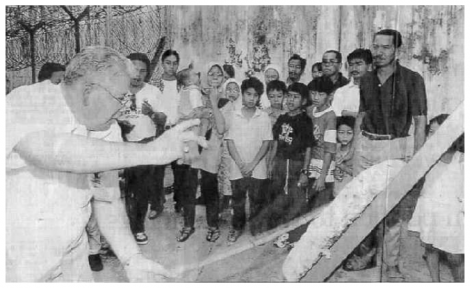
Kiri: Gambar bahagian dalam Penjara Pudu sekitar tahun 1997, kini sebagai muzium. “Pudu Jail was turned into a museum in May 1997. Visitors were able to experience life behind bars and walk inside the dimly-lit courtyard and along the dark alleyways. -NSTP/File pic”
(Esther Landau @ New Straits Times: August 20, 2020: |"NST175: For 100 years a city landmark").
Kanan: Pudu Prison was the first Malaysian prison to be opened to the public, attracting huge crowds.}}
Demonstrasi sebatan sedang dijalankan di hadapan para pengunjung di ruang laman blok utama: “Figure 14: Whipping demonstration carried out to the visitors (1997). Pudu Prison was the first Malaysian prison to be opened to the public, attracting huge crowds.”
(Sumber: Mariana Isa @ University of Bath, 2006: |"Pudu Jail Conservation Statement", m.s. 14).
Pameran Seni (3-26 Januari 1998)
Pada 3-26 Januari 1998, suatu pameran seni “The Outside World '98” telah diadakan di Penjara Pudu: “1998 > Co-organiser of “The Outside World '98” Art Exhibition, 3-26 January, Historical Pudu Prison, Jalan Hang Tuah, KL.” (Chin KonYit: |"About the Artist").
Akhbar Guang Ming Daily pernah mengimbau peristiwa pameran seni ini bersama salah seorang pengelolanya, Chin KonYit:-
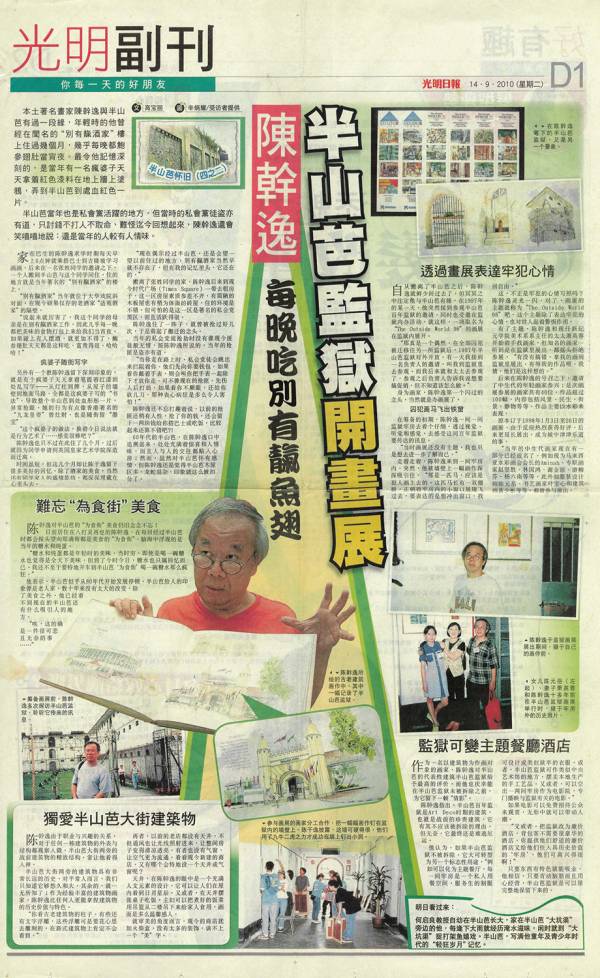
Guang Ming Daily, 14 September 2010 (Lostgens: "Goodbye Pudu Jail").
Penutupan Muzium
Namun operasi Muzium Penjara Pudu tidak lama, iaitu sehingga tahun 1998 sahaja: “The conservation statement also says the prison became the Pudu Prison Temporary Museum in May 1997, and served as the temporary Hang Tuah Police Station in 2004. This is backed up by reports by the Badan Warisan and the New Straits Times that the jail indeed served as a prison museum that operated from 1997 to 1998.” (Nick Choo @ The Nut Graph, November 30, 2009: |"Remembering Pudu Jail (Updated 1 Dec 2009)").
Gambar-gambar sekitar Muzium Penjara Pudu, tahun 1999 (kemungkinan setelah ditutup):-
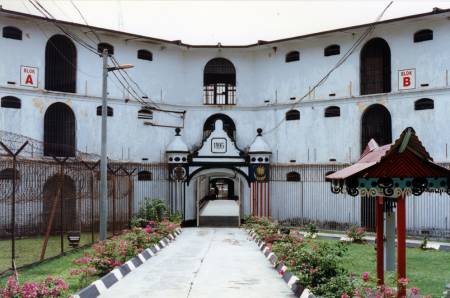
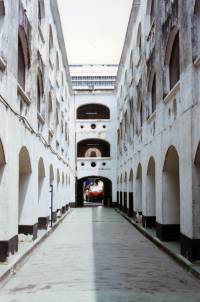
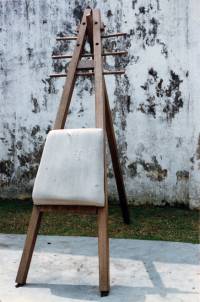
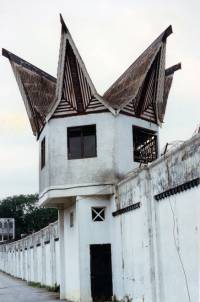

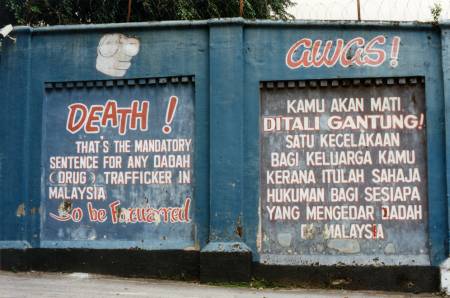
Gambar-gambar tahun 1999 (Jason7825 @ Wikimedia, 1999).
2002-2003: Terbengkalai
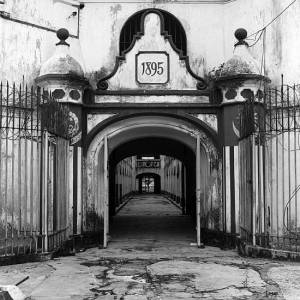
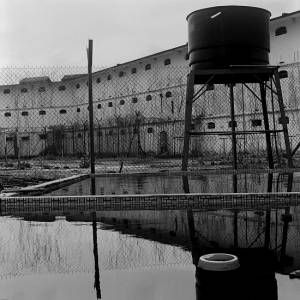
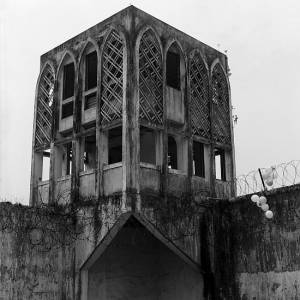
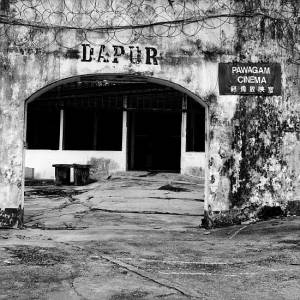
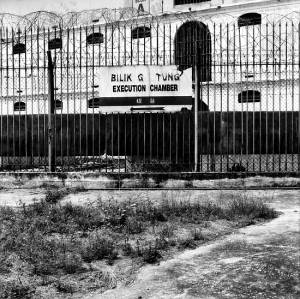
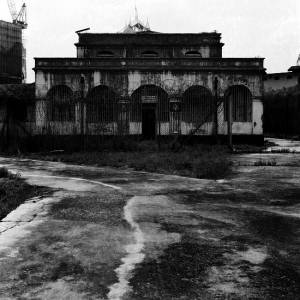
Sebahagian daripada gambar-gambar yang diambil oleh Khairul Azril Ismail pada tahun 2002 dan 2003. Ketika itu Penjara Pudu di dalam keadaan terbengkalai: “In 2002 and 2003, artist and photographer K Azril Ismail spent time exploring the abandoned Pudu Jail in Kuala Lumpur, taking pictures of the cells and areas around the prison. He documented the scratching, messages, writings and drawings on the walls of the prison cells. These, he says, gave outsiders a glimpse into the minds of the prisoners and their time under incarceration.” (Nick Choo @ The Nut Graph, November 30, 2009: |"Remembering Pudu Jail (Updated 1 Dec 2009)").

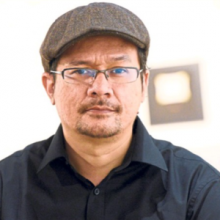
Antara koleksi gambar grafiti Dr. Khairul Azril yang dipamerkan di Badan Warisan Malaysia. Foto: Dr Khairul Azril Ismail (kanan). Latar pengambilan gambar-gambar di atas, menurut beliau sendiri: ““Saya telah ditugaskan oleh UDA Holdings pada 2002/2003 untuk mengambil gambar Penjara Pudu sebagai dokumentasi visual sebelum dirobohkan. Namun, keunikan grafiti pada dinding-dinding sel meninggalkan kesan pada diri saya dan akhirnya saya mengambil keputusan untuk menjadikan grafiti-grafiti tersebut sebagai penyelidikan saya,” ujarnya. Koleksi gambar Dr K. Azril telah dipamerkan di Badan Warisan Malaysia pada 2019.” (Nida Zahar @ Lensa Seni, Bandar Aktiviti Seni, CENDANA, 26 Januari 2022: |"Lukisan penjara pudu, luahan hati di sebalik jeriji besi").
Kertas kerja yang dihasilkan oleh beliau berdasarkan pengalaman di atas: “The aim of this thesis is to examine and analyse the images of graffiti contained within the portfolio of ‘Pudu Jail’s Graffiti (PJG)’, documented work from the abandoned prison facility in Kuala Lumpur, Malaysia, between 2002 and 2003.” (Khairul Azril Ismail, 2015: |"Pudu Jail's Graffiti: Beyond the Prison Cells").
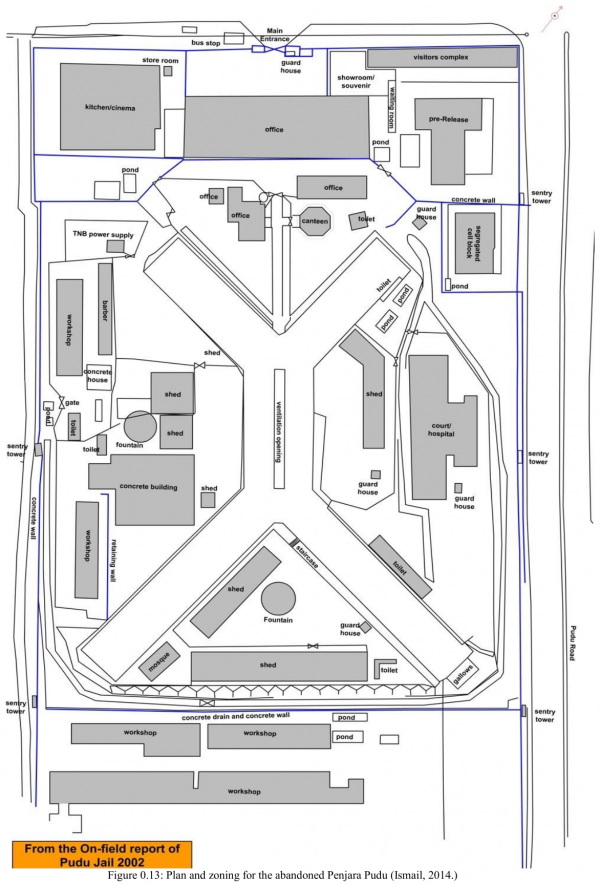
Lakaran pelan Penjara Pudu tahun 2002, oleh Khairul Azril Ismail: “From the On-field report of Pudu Jail 2002: Plan and zoning for the abandoned Penjara Pudu (Ismail, 2014.)” (Izzul Hafiy Rosli, Roslina Abdul Latif @ Taylor's University / International Journal of Research and Innovation in Applied Science (IJRIAS), Volume VI, Issue III, March 2021: |"Penjara Pudu: Demolished Prison of Dark Recollections").
2004-2008: Balai Polis Jalan Hang Tuah
Pada tahun 2004, ia telah dinaik taraf untuk dijadikan Balai Polis Sementara Jalan Hang Tuah: “The conservation statement also says the prison became the Pudu Prison Temporary Museum in May 1997, and served as the temporary Hang Tuah Police Station in 2004.” (Nick Choo @ The Nut Graph, November 30, 2009: |"Remembering Pudu Jail (Updated 1 Dec 2009)").
Menurut New Straits Times, ia juga dibuka sebagai muzium, serta pusat tahanan sementara penagih dadah: “It was closed again a few years later and reopened in 2004 as a museum. At the same time, it was also used as a temporary detention centre for drug addicts from the Hang Tuah police station.” (Esther Landau @ New Straits Times: August 20, 2020: |"NST175: For 100 years a city landmark").
Tiada maklumat lanjut diperolehi berkenaan penaiktarafan ini, oleh kerana ianya rahsia keselamatan pihak polis: “Information on the prison’s recent upgrade in 2004 is inaccessible due to the tight security of it being a new police station.” (Mariana Isa @ University of Bath, 2006: |"Pudu Jail Conservation Statement", m.s. 8).
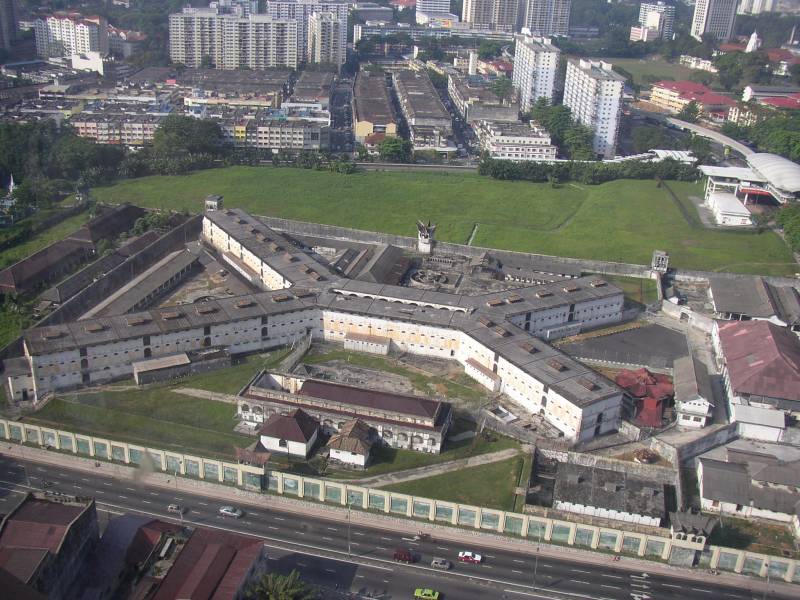
Gambar sekitar Februari 2004, ketika Penjara Pudu menjadi Balai Polis Sementara Hang Tuah. Kelihatan keadaan blok-blok serta persekitarannya jauh lebih baik berbanding gambar-gambar tahun 2002-2003, kemungkinan selepas dinaik taraf: “Aerial view of Pudu Prison (Original text: 2004-02-23)” (Joseph Gan @ Wikipedia, 5 Disember 2006 ( Tarikh sumber asal: 2004-02-23 @ http://www.ganfamily.com/holidays/2004%20-%20KL/slides/17.html ): "Aerial view of Pudu Prison").
Mulai tahun 2005, Penjara Pudu dijadikan pusat tahanan penagih dadah bagi sekitar Kuala Lumpur: ”…the Badan Warisan report says the prison was taken over by the Urban Development Authority (UDA) upon its shutdown in 1996, and operated as a detention centre from 2005.” (Nick Choo @ The Nut Graph, November 30, 2009: |"Remembering Pudu Jail (Updated 1 Dec 2009)").
Setakat tahun 2008, sebahagian Penjara Pudu masih digunakan sebagai Balai Polis Jalan Hang Tuah, pusat tahanan reman bagi kawasan Cheras, Sentul, Dang Wangi dan Brickfield, serta pusat kaunseling bagi remaja bermasalah, dengan kerjasama Jabatan Penjara dan Kementerian Pendidikan: “Today, a section of the prison building is used as the Jalan Hang Tuah police station. It is also a detention centre for remanded suspects in the Cheras, Sentul, Dang Wangi and Brickfield districts. The prison is also used to conduct counselling programmes for problem children with co-operation from the prisons department and the education department.” (The Star, 17 Jun 2008: |"Pudu Prison a prominent landmark in the city").
2006: Dikembalikan kepada Uda Holdings
Pada tahun 2006, setelah menjadi lokap sementara bagi penagih dadah di sekitar Kuala Lumpur, pihak pentadbiran Wilayah Persekutuan menyerahkan kembali Penjara Pudu kepada Uda Holdings Berhad, yang merancang untuk membina hotel, pusat perniagaan, premis pejabat dan kediaman di tapak penjara itu, dan bakal dikenali sebagai “Bukit Bintang City Centre”. Menurut Pelan Struktur Kuala Lumpur 2020, Penjara Pudu tidak akan dikekalkan. Sementara itu, Jabatan Muzium dan Antikuiti sedang membuat penilaian terhadap nilai warisan penjara ini: “Currently, Pudu Jail serves as Hang Tuah Police Station, a temporary drug addict hold up centre. In 2006, the Federal Territory Administration will return the land to its owner, Uda Holdings Berhad. The company plans to develop the site into series of hotels, retails, offices and apartments known as the Bukit Bintang City Centre. … Kuala Lumpur’s Structure Plan 2020 (paragraph 811) recommends Pudu Jail to be developed as a high density residential development incorporating service apartments and a neighbourhood park. It is noted that no intentions to conserve the prison are mentioned. … Measured drawings of the prison have been carried out by architectural students of Malaya University (1990) and International Islamic University Malaysia (2004). At present, The Malaysian Antiquity Department is analyzing the prison’s heritage value.” (Mariana Isa @ University of Bath, 2006: |"Pudu Jail Conservation Statement", m.s. 8).
Cadangan Pemuliharaan
Antara rekod seruan orang awam ke arah pemuliharaan Penjara Pudu ialah sebuah kertas kerja akademik yang diterbitkan pada tahun yang sama. Antara lain, ia menegaskan nilai sejarah pada binaan tersebut: “Pudu Jail, once Malaysia’s grand dame of penitentiary, currently faces possible redundancy and demolishment. This conservation statement is the first step in addressing these issues and will be used to support and initiate further listing application and consultation. It sets out Pudu Jail’s heritage attributes and looks into its protection while allowing appropriate development. The walled prison, located in the heart of Kuala Lumpur, has witnessed the city’s growth since 1895. Its integral role was when it was used as a P.O.W camp centre during the Japanese Occupation. Pudu Jail is of value for its colonial architectural design and its survival into modern Kuala Lumpur’s cityscape. Threats to Pudu Jail’s further existence includes Malaysia’s present statutory and legislation, disputes on suitable use, pressures of high real estate value, lack of public awareness, surrounding development and poor maintenance and upgrading works. The suggested conservation principles identifies the need for cooperation between public and private bodies, better informed management, raising awareness, public participation, monitoring of potential threats and market research for potential use. A successful transformation of Pudu Jail from a building synonym with incarceration and punishment into a new exciting quarter of national importance for Kuala Lumpur will mark a significant chapter in Malaysia’s heritage conservation history.” (Mariana Isa @ University of Bath, 2006: |"Pudu Jail Conservation Statement", m.s. 6).
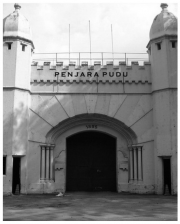
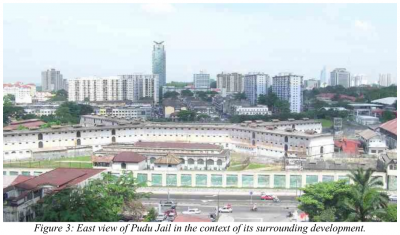

Kiri: Gambar gerbang hadapan (2006): “Figure 1: Pudu Jail’s Front Gate.”
Tengah: Keadaan sekeliling (2006): “Figure 3: East view of Pudu Jail in the context of its surrounding development.”
Kanan: Bahagian dalamnya masih dalam keadaan asal (2006): “Figure 15: The present condition of the Cell Block’s interior. Original design and fittings appear to have survived.”
Keadaannya ketika itu masih agak baik dan bahagian utamanya masih tidak berubah sejak ia mula dibina tahun 1895 dahulu. Lebih penting lagi, ianya adalah sebahagian daripada sejarah Kuala Lumpur sejak lama. Malah peranannya sebagai muzium dan pusat penahanan penagih dadah juga masih menyumbang kepada warna warni pensejarahannya. Jelas, unsur sejarah dan senibina Penjara Pudu wajar dikekalkan sebagai warisan, agar generasi mendatang dapat merasai sendiri kisah-kisah jenayah, peperangan, dan perjuangan yang sarat di dalamnya: “In general, the building is still reasonably intact and is of particular interest for its particular location. The form of Pudu Jail’s core parts dating from 1895 remains unaltered. Past exterior and interior renovations have not detracted its original architectural appearance. A reasonable amount of original fittings (stairs, windows, doors) appear to survive and their durable qualities are of note. Archaeological surveys have not been carried out on site but interesting discoveries of graves are expected. … Pudu Jail’s long relationship with Kuala Lumpur has been important in its evolution. Regardless of its past operations, it remains as a historical landmark. The closure of the prison, its use as a museum and later as a drug addict hold up centre also contributes to the story of Kuala Lumpur. The prison is of local and national interest because it is one of the few examples of a 19th century prison in the region. … The historical and architectural significance of Pudu Jail are too obvious for the prison to be disregarded as a national heritage. After losing so many buildings from the colonial era to modern development, the preservation of Pudu Jail is essential. Malaysians need Pudu Jail to remain not solely for its historic and architectural importance, but for the need to retain a sense of identity. This is only possible with stories from their past and Pudu Jail has much stories to tell about crime and punishment, war and survival, freedom and honour. Without visual proof, these stories will only be legends that will disappear through time.”
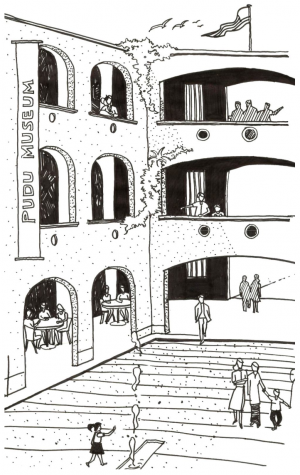
Bayangan naik taraf Penjara Pudu cara alternatif oleh Mariana Isa (2006), iaitu sebagai muzium dan pusat aktiviti masyarakat: “Figure 23: Illustration of Pudu Jail as a museum. The cell block’s courtyard creates an interesting enclosed space.”
(Sumber: Mariana Isa @ University of Bath, 2006: |"Pudu Jail Conservation Statement", 15-17).
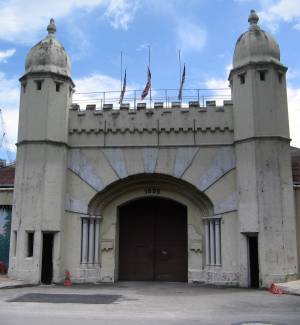

Kiri: Gambar 4 April 2007 (Yosri Mohamed Yong @ Wikimedia, 4 April 2007).
Kanan: Gambar 29 Januari 2006: “Murals outside Pudu Prison, Kuala Lumpur, Malaysia.” (mailer_diablo @ Wikimedia, 2006)
Gambar-gambar Penjara Pudu pada 24 Mac 2007:-
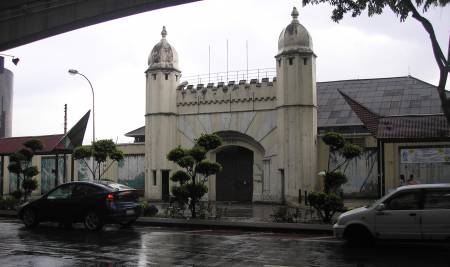
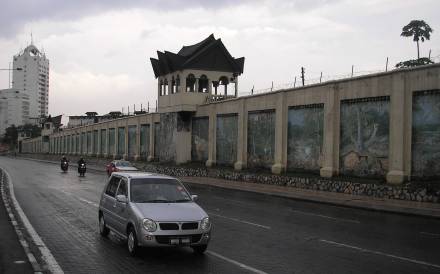
Kiri: “The frontal facade and entrance of the Pudu Prison in Pudu, Kuala Lumpur, Malaysia.”
Kanan: “The northeastern wall of the Pudu Prison in Pudu, Kuala Lumpur, Malaysia, illustrating wall paintings of nature end to end.”
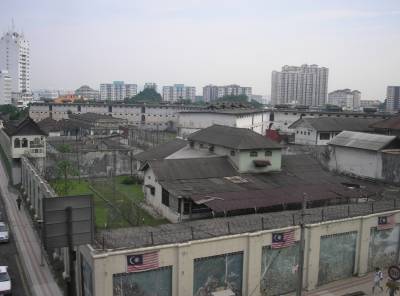
“A view of the Pudu Prison's compound from the northwest end of the prison (as seen from a moving Kuala Lumpur Monorail train) in Pudu, Kuala Lumpur.”
(Sumber: Two hundred percent @ Wikimedia, 2007).
2007: Tahanan HINDRAF
“Additionally, eight supporters of the Hindu Rights Action Force were arrested and incarcerated in Pudu Prison following the 2007 HINDRAF rally. They were later released due to lack of evidence.” (Wikipedia: Pudu Prison).
2007-01-11: Dokumentasi Arkib Negara
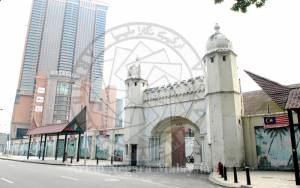
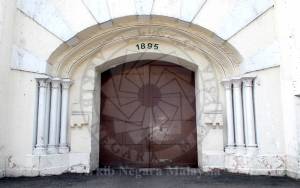
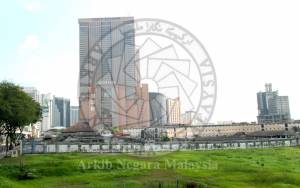
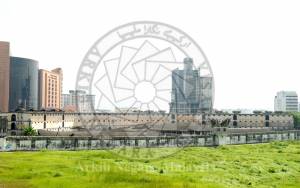
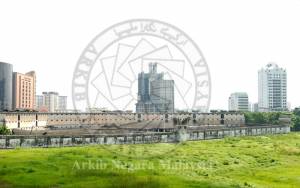
“DOKUMENTASI BANGUNAN LAMA SEKITAR KUALA LUMPUR UNTUK PAMERAN KUALA LUMPUR (PENJARA PUDU )”
(Sumber: JABATAN ARKIB NEGARA MALAYSIA, 11/01/2007: |"DOKUMENTASI BANGUNAN LAMA SEKITAR KUALA LUMPUR UNTUK PAMERAN KUALA LUMPUR (PENJARA PUDU )").
2008-2009: Gambar-Gambar Akhir

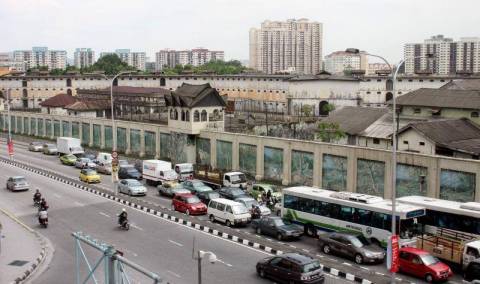
Gambar The Star, Jun 2008: “An aerial view of the X-shaped Pudu Prison on Jalan Hang Tuah before it was torn down by Dec 2012. The prison's most memorable feature was a mural, 860 feet in length, which depicted jungle, beach and other scenes of nature painted by inmates in the 1980s. One of the painters, Khong Yen Chong, completed his sentence before the painting was finished. He then came back to complete the mural as a free man. #StarThrowback (June 2008).” (The Star, 19 Ogos 2015: "An aerial view of the X-shaped Pudu Prison on Jalan Hang Tuah").

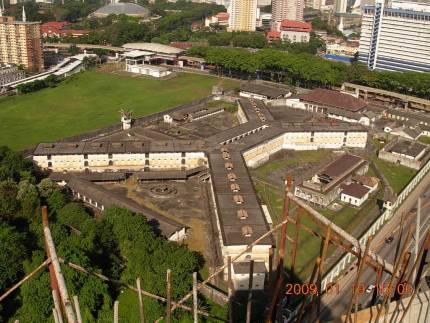
Kiri: Gambar sekitar Februari 2008 (rubberduckee @ flickr, February 21, 2008: |"pudu prison front view").
Kanan: Gambar 19 Januari 2009. Kelihatan keseluruhan Penjara Pudu, termasuk blok hospital dan dinding penjara menghadap Jalan Pudu di sebelah kanan gambar, masih dalam keadaan asal (am3r0L, 16 Mac 2011: |"Apakah?").
Koleksi gambar-gambar Liz Price pada tahun 2008: "Pudu Prison, KL".
2009-10-14: Permulaan Perobohan
Keputusan perobohan Penjara Pudu telah dibuat sekitar Jun 2009, dan ianya bakal dibuat secara berperingkat: “In June 2009, 10 years after closing its doors as a prison for good, the government decided to take down the prison complex in phases to make way for future infrastructure development.” (Esther Landau @ New Straits Times: August 20, 2020: |"NST175: For 100 years a city landmark").
Perobohan Penjara Pudu bermula pada 14 Oktober 2009: “Pudu was demolished on the 14th October 2009 to make way for road expansion. The final wall came down at 10pm, 21 June 2010.” (Malaysia Design Archive: |"The Marginalia of Pudu Jail").
19-24 November 2009: Kira-kira sebulan selepas permulaan perobohan: John Larkin (anak kepada Frank Larkin, bekas tahanan Penjara Pudu ketika penaklukan Jepun, 1942) telah berkesempatan melawat Penjara Pudu ketika menghadiri seminar di UPM Serdang, sekitar 19-24 November 2009. Ketika itu, perobohan telah pun dimulakan di blok-blok sebelah timur Penjara Pudu. Beliau mengambil gambar Penjara Pudu dari Stesen Monorel Hang Tuah di sebelah barat, yang tampaknya masih belum diusik: “During November, 2009 I was able to take some photographs of the gaol. … While I was in Kuala Lumpur I took the chance to visit the gaol and take some photographs. I took most of the photographs from the Hang Tuah monorail station which partially overlooks the gaol.”

Gambar panorama yang diambil dari Stesen Monorel Hang Tuah di sebelah barat. Kelihatan blok-blok dan dinding penjara di sebelah barat masih dalam keadaan asal: “I took a series of shots using the panorama feature of my camera and I stictched the images together using Photoshop Elements. Took a while to merge the nine different images however I am happy with the final result.”
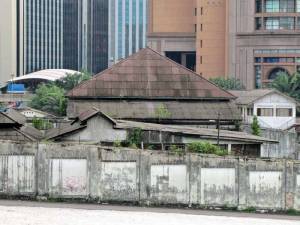
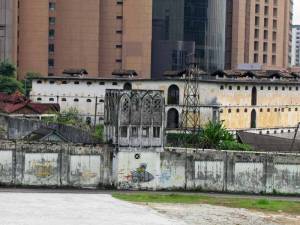
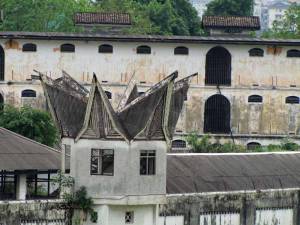
Sebahagian gambar asal dari Stesen Monorel Hang Tuah di sebelah barat, sebelum dijadikan gambar panorama di atas.
(Sumber: John Larkin @ Prisoner of WarFrank Larkin NX43393 AIF, 12/06/2011: |"Pudu Gaol Kuala Lumpur").
2009-10-20: Pernyataan Badan Warisan Malaysia
Pernyataan rasmi Badan Warisan Malaysia berikutan isu peruntuhan Penjara Pudu:-
“Pudu Jail is part of the unique story of Kuala Lumpur's development - its history and its geography. It was originally located in an area well away from the city centre but more than a century later, with the growth of the city especially over the past four decades, the jail is sitting on “prime” land.
From reports in the media we understand that its demolition is part of a plan to reduce KL's traffic woes; it is apparently also to make way for a new shopping centre and residential high-rises.
While the building as an institution has a chilling history - one of brutality and crime - yet, it represents a part of the social history of KL. The preservation of Pudu Jail and its restoration and adapting it to new use would have been an opportunity to place it on the same page as Port Arthur in Australia, or Robben Island in South Africa whose communities fought to preserve their landmark jails as important memories of their past, and where these landmarks have subsequently become great tourist destinations.
If the jail complex were to have been preserved, with a little creative thinking and innovative planning, we could have found a narrative which would fit into our contemporary community and provide a first-hand experience of a unique piece of social, cultural and architectural history. Its demolition denies us this opportunity.
The silver lining has been the expressions of dismay and calls for the preservation of the jail seen especially in blogs and on-line commentaries from the general public, not just heritage advocates. At the very least proposals are for the memory of the site to be retained by keeping the main gate and sections of the wall flanking it and to incorporate this into the new development.
Badan Warisan Malaysia believes that there is a great need for open public discourse on the future of Pudu Jail and that it is time due consideration is exercised by the official custodians of heritage into preserving and restoring not just this site, but all of Malaysia's significant built heritage. Laws, guidelines and standards to position heritage conservation as a critical activity for maintaining our nation's identity is crucial and we can ill afford to keep loosing our fragile heritage.”
(Sumber: Elizabeth Cardosa @ Badan Warisan Malaysia, 20 Oktober 2009: |"Press Statements").
2010-06-21: Perobohan Dinding Timur
Pada Isnin, 21 Jun 2010 jam 10 malam, dinding Penjara Pudu sebelah timur, berhadapan Jalan Pudu telah dirobohkan. Selain sebahagian daripada proses perobohan yang telah pun dimulakan sebelum ini, ianya bertujuan untuk peluasan Jalan Pudu:-
“When the clock strikes 10pm on Monday, the 394-metre stretch of Pudu Jail wall fronting Jalan Pudu will be demolished after having served its purpose for the past 100 years. The wall goes down to accommodate the widening of the busy road that fronts it.” (The Star, 20 Jun 2010: |"Pudu jail wall to be demolished Monday").
“The authority had decided to bring down this historical building to make way for road widening and the construction of an underpass. It is believed to reduce traffic congestion during peak hours at Jalan Hang Tuah.” (Elween Loke Wei Jie @ J-On News, July 27, 2010: |"Break, Prison Break").
Liputan Sebelum Perobohan
Liputan hari-hari akhir sebelum perobohan:-
Malam sebelumnya (Ahad, 20 Jun 2010)
“Last supper with Pudu jail: The wall of Pudu Jail fronting Jalan Pudu will be demolished Sunday night for the construction of an underpass to ease congestion in the area. Staronline.TV visited the final night of the jail before the demolition.” (The Star, 20 Jun 2010: "Last supper with Pudu jail").
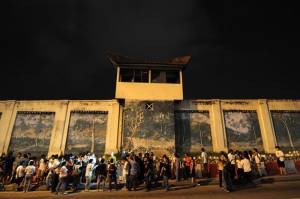
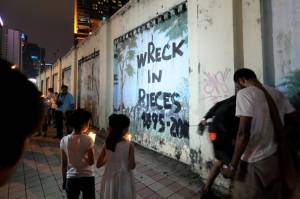
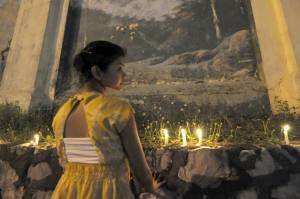
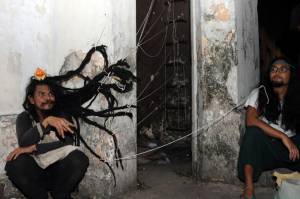
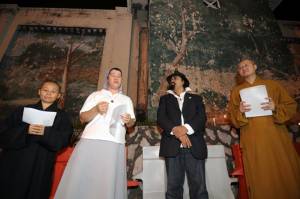
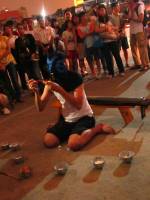

“Say goodbye to our heritage, largest mural painting wall, Gather at Hang Tuah Star LRT station and walk towards Pudu Jail with white candle.” (Lostgens: "A Funeral for Pudu Jail").
The Star, 21 Jun 2010
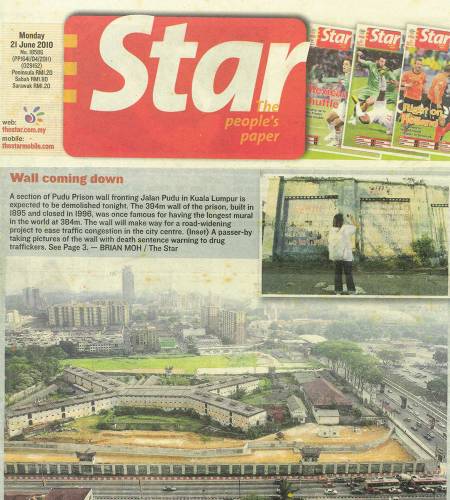
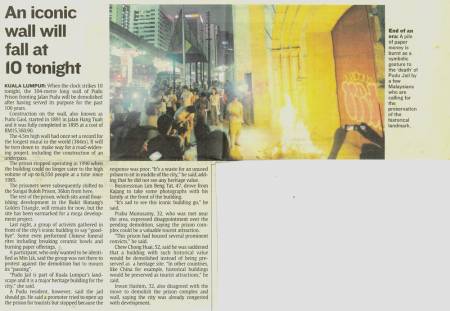
Kelihatan blok-blok Penjara Pudu di sebelah timur, termasuk hospitalnya, telah pun dirobohkan sebelum ini. Yang tinggal hanya dinding bermural di sebelah luarnya sahaja. Namun oleh kerana ianya kelihatan amat jelas dan simbolik pada pandangan orang ramai, perobohannya mendapat liputan yang amat meluas di media massa.
China Press, 21 Jun 2010
(Sumber: Lostgens: "Goodbye Pudu Jail").
The Malaysian Insider (21 Jun 2010)
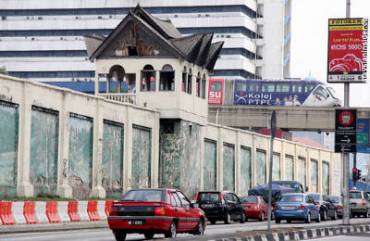
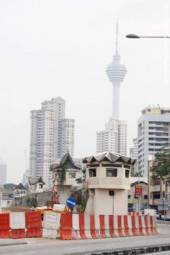
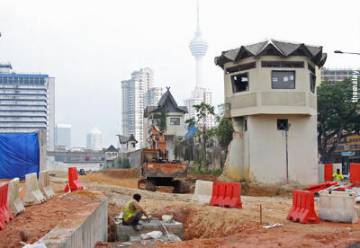
Gambar sebelum perobohan, oleh Choo Choy May: “Driving past Pudu Jail side wall on Jalan Pudu will be a distant memory soon for city dwellers after tonight's demolition. The jail has become a solitary figure in among the rapid development around it over the years. Much of the prison interior has already been brought down.”
Menurut Timbalan Menteri Kewangan ketika itu, Datuk Awang Adek Hussin, pihak kerajaan berpendapat Penjara Pudu tidak sesuai dijadikan warisan negara oleh kerana ianya sebuah penjara, dan tiada apa yang boleh dibanggakan. Sebaliknya, pembangunan bercampur secara berperingkat akan dijalankan di tapaknya: “When responding to a question by Fong Kui Loon (DAP-Bukit Bintang) in Parliament today, Deputy Finance Minister Datuk Awang Adek Hussin said the government had decided that the 115-year-old Pudu Jail was “not something to be proud of” and hence should not be turned into a heritage site. “The government has studied the matter and decided that the site is not a heritage site and will not be turned into one. To our opinion, it is not something to be proud of… there may be other things that we can be proud of, compared to a jail, although it (Pudu Jail) is old. Therefore, there are no plans for us to build a museum there,” he said. Awang Adek said the mixed development project would include a transit centre, serviced apartments, office spaces, recreational areas, hotel and commercial spaces. “The development is divided into six phases and will be developed in stages over a 10 year period beginning from the first quarter of next year,” he said. Awang Adek added that 40 per cent of the development would house residential properties while the remainder would be for commercial spaces. “A large proportion of the commercial lots will be owned by UDA Holdings Bhd and will be rented out,” he said. To a question by Dr Dzulkefly Ahmad (PAS-Kuala Selangor) on the viability of initiating a development project at the Pudu jail site in view of the impending property glut in Kuala Lumpur, Awang Adek said: “The government has also taken into account the current market position as well as the projection for the next 10 years and that is why the development will be in stages. It is not just RM5 billion at one go and it is a mixed development, not just residential areas. Residential spaces will only take up 40 per cent of the total development and the remainder will go for commerical spaces,” he said.”
(Sumber: Clara Chooi @ The Malaysian Insider, 21 Jun 2010: |"No heritage site for Pudu Jail, development will commence").
Hari Terakhir
Gambar-gambar Penjara Pudu pada 21 Jun 2010, sejurus sebelum perobohan dinding sebelah Jalan Pudu pada malamnya:-
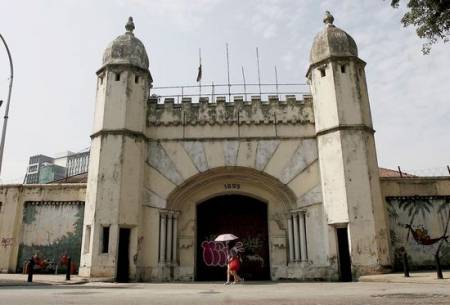
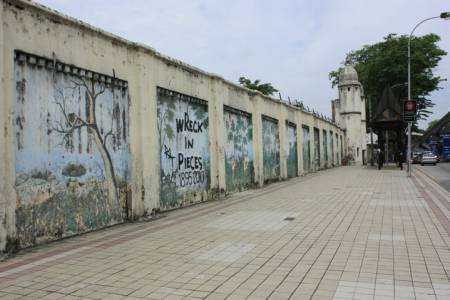
Kiri: “pudu jail (1895-2010): It was more of a teary goodbye of sorts to the old giant, and to administer last rites for its impending demolition rather than anything else. When the death knell sounded (10pm on 21.6.2010)with a thunderous roar of falling rubble effected by bulldozers, souvenir hunters risked life and limb, rushing to get fragments of it as momentous.(brick or stone or dust) Presumably to remind the next generation that a great prison once existed in our midst. It was the folly and shortsightedness of the people today that leveled it to the ground under the pretext and guise of progress and development. The building is no ordinary concrete structure being a penitentiary where convicts were incarcerated and executed. It has become an integral part of our 'turbulent history.' Therefore its a shame to see it go.A lot of exciting events took place over the 108 years of its existence. I need not elaborate.The newspaper will have plenty of it over the next few days.” (ky cheah, 22nd June 2010: |"pudu jail (1895-2010)").
Kanan: Grafiti sebelum perobohan: “The wall said it all: “Wreck in Pieces 1895 -2010” (by Lee Swee Hui)” (Elween Loke Wei Jie @ J-On News, July 27, 2010: |"Break, Prison Break").
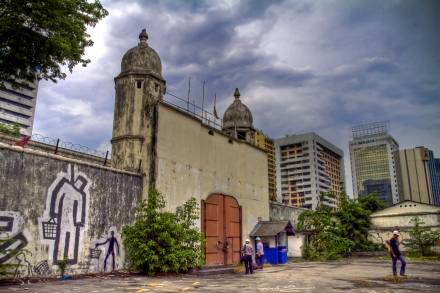
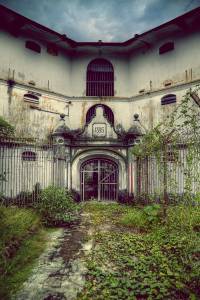
Kiri: Gambar gerbang hadapan, dari dalam: “The main entrance viewed from inside of the prison.”
Kanan: Gambar bahagian dalam: “Interior of the Pudu Prison”
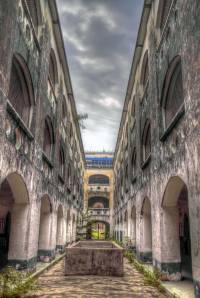
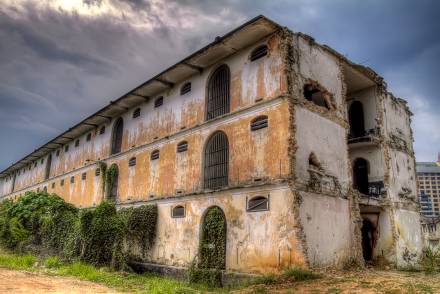
Gambar di blok utama: “Interior of the Pudu Prison”
(Sumber: Ezry Abdul Rahman @ Wikipedia, 21 Jun 2010).
Antara koleksi gambar terbaik yang diambil sebelum perobohan:-
- "PUDU PRISON – THE END OF AN INFAMOUS ERA" (HIGHLANDERIMAGES PHOTOGRAPHY, February 13, 2016).
- "Luahan Dinding, Pudu Jail" (Amri Daud @ Facebook, 21 Oktober 2020).
Perobohan (2010)
2010-06-21: Malam perobohan
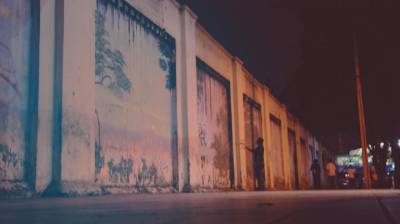
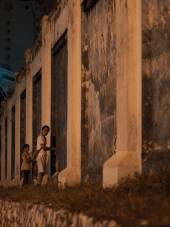
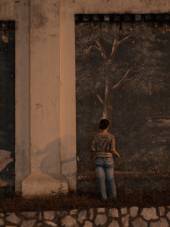
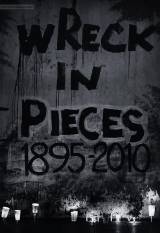
Penghormatan terakhir:-
Kiri: “The last farewell to our unrecognised national heritage before the clock strikes 10.00pm (by Chan Wai Hoe)” (Elween Loke Wei Jie @ J-On News, July 27, 2010: |"Break, Prison Break").
Tengah: (Adi Arfan Mikhail @ Flickr, 21 Jun 2010: "In Memory - Pudu Prison Complex ~ Circa 1895-2010").
Kanan: “Pada malam 21 Jun lalu,Gua bersama Udey Ismail dan Ikmal Ibrahim telah menyaksikan sendiri peristiwa merobohkan benteng sejarah ni.” (Mohd Syimir Izzaffy, June 22, 2010: |"Pudu Gaol, 1895-2010 in memory..").
Ketika Perobohan
“Bulldozers tore down a boundary wall famed for murals mostly painted by anonymous convicts at a 115-year-old Malaysian prison that once held World War II Allied soldiers. Hundreds of onlookers watched as excavators broke through the eastern wall of Pudu Jail on Monday night, leaving many heritage lovers aghast at the loss of an iconic structure for commercial development. Authorities last year began tearing down structures inside the sprawling complex on the edge of Kuala Lumpur’s most famous shopping area Bukit Bintang. But that was done away from public gaze and did not attract as much attention as the demolition of the mural wall. Pudu Jail is notorious for housing Allied prisoners during the Japanese invasion of the Malaya peninsula. After World War II, the prison housed common criminals and some were executed there. Many prisoners with artistic flair were deployed to paint murals depicting scenes of nature on the outside of the wall, creating a wraparound work of art around the jail. Despite fading because of age and the elements, the murals remained a tourist attraction for many years. “Sadly, the custodians of our nation’s heritage have not seen fit to respond to the many different voices which have spoken up against the demolition of Pudu Jail,” The Heritage of Malaysia Trust said in a statement on its website. It said despite having “a brutal and insalubrious story,” the jail was part Malaysia’s penal history. The government refused to turn the prison into a museum, saying the land is sorely needed to make an underpass to ease congestion and to build apartments, hotels and offices over the next 10 years. “It is not something we are proud of, even though it is an old jail,” Deputy Finance Minister Awang Adek told Parliament on Monday. The 83 million-ringgit ($25 million) underpass is expected to be completed by late 2012, said a city hall official, who declined to be named, citing protocol. Construction of the commercial buildings will begin early next year, Awang said. The jail - with a capacity for some 2,000 prisoners - was shut down in 1996 because of overcrowding and the inmates were moved to a more modern prison on the outskirts of Kuala Lumpur. After a brief stint as a museum, Pudu became a temporary holding place for detainees awaiting trial. In 1986, two Australians were hanged in Pudu after being convicted of drug trafficking, becoming the first Westerners executed under Malaysia’s tough anti-drug laws. Conservationists have frequently accused Malaysian authorities of favoring commerce over heritage. In 2006, activists mourned the demolition of a stately downtown Kuala Lumpur mansion, known as Bok House, built in 1929 with a mix of Chinese, Malay and Western architectural forms. The Malay Mail newspaper quoted Kuala Lumpur Mayor Ahmad Fuad Ismail as saying the City Hall asked the contractors to leave the main entrance to Pudu jail intact for “its historical significance.” But The Heritage of Malaysia Trust dismissed it as a futile gesture, saying conservation of just a small part of the jail will make a “mockery of heritage.””
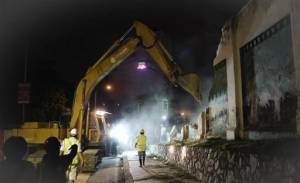
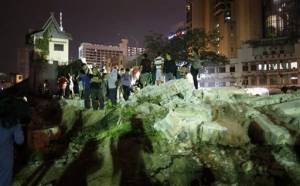
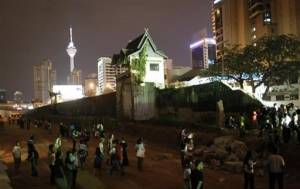
Kiri: “Bulldozer demolishes a section of the wall of Pudu Prison in downtown Kuala Lumpur, Monday, June 21, 2010.”
Tengah: “Malaysian stand on a demolished wall of Pudu Prison in downtown Kuala Lumpur, on Monday June 21, 2010.”
Kanan: “The 394-meter-long wall of Pudu Prison which is being demolished in downtown Kuala Lumpur, on Monday June 21, 2010.”
(Sumber: JULIA ZAPPEI, ASSOCIATED PRESS WRITER @ The San Diego Union-Tribune, JUNE 21, 2010: |"Malaysia tears down iconic mural wall at prison").

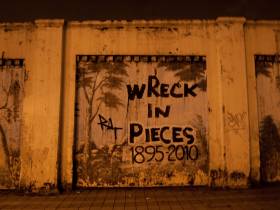
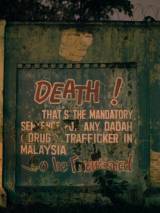

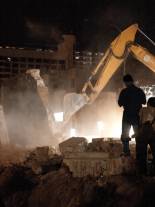
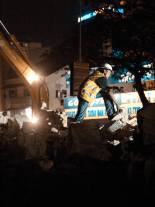
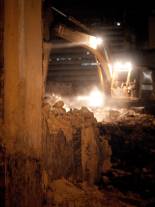
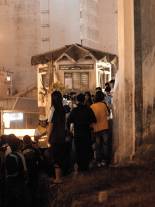
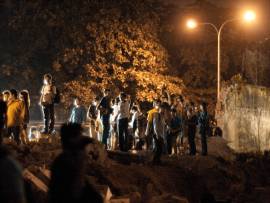
(Adi Arfan Mikhail @ Flickr, 21 Jun 2010: "In Memory - Pudu Prison Complex ~ Circa 1895-2010").
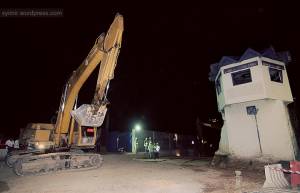
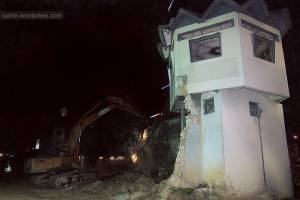
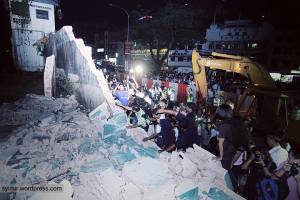
(Mohd Syimir Izzaffy, June 22, 2010: |"Pudu Gaol, 1895-2010 in memory..").
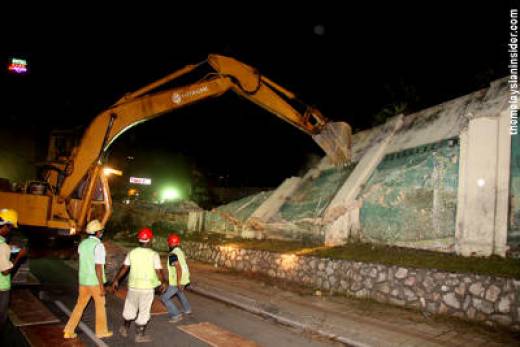
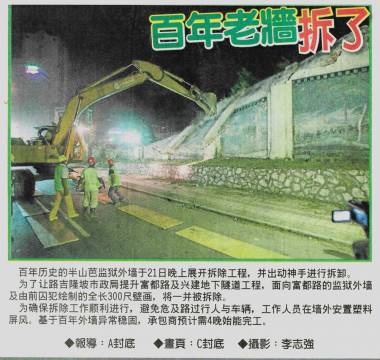
Kiri: Ketika perobohan dijalankan (The Malaysian Insider @ Blog am3r0L, 16 Mac 2011: |"Apakah?").
Kanan: Versi akhbar China Press (Lostgens: "Goodbye Pudu Jail").
China Press (22 Jun 2010)
Guang Ming Daily (22 Jun 2010)
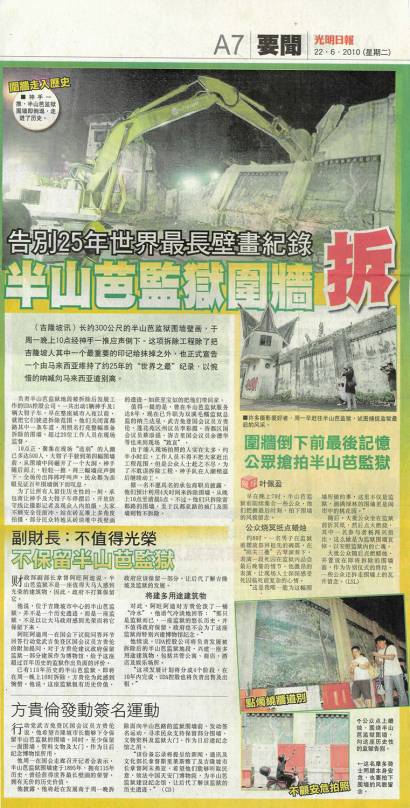
Guang Ming Daily, 22 Jun 2010.
Sin Chew Daily (23-25 Jun 2010)
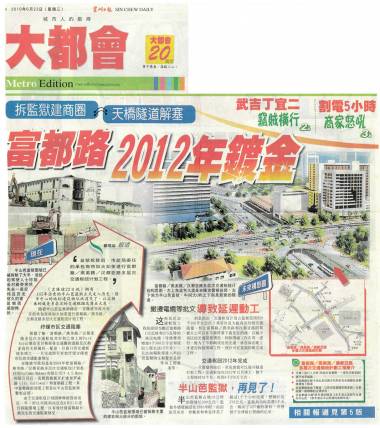
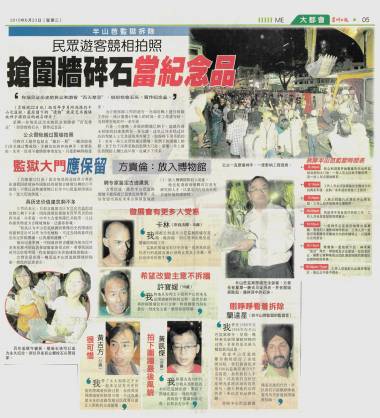

Sin Chew Daily, 23-25 Jun 2010.
(Sumber: Lostgens: "Goodbye Pudu Jail").
Liputan dan koleksi gambar Liz Price ketika perobohan: "Pudu Prison - the demolition".
Keadaan Dinding Timur Selepas Perobohan
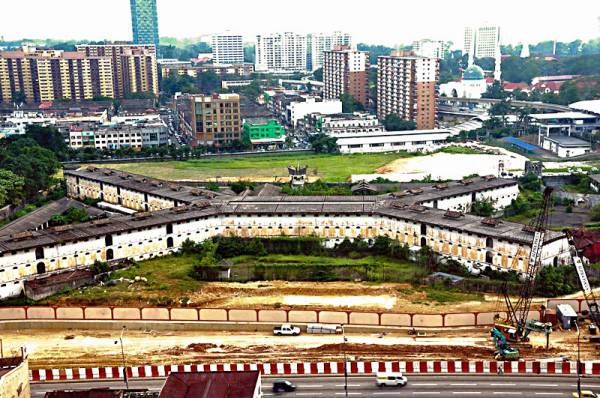
Gambar ini diambil sekitar tahun 2010-2011 (selepas perobohan dinding sebelah timur), dari Berjaya Times Square oleh seseorang yang bertugas di situ. Kelihatan dinding sebelah timur menghadap Jalan Pudu telah pun dirobohkan.: “Interestingly, I shared the story of my visit to the gaol with the participants of the workshop and mentioned how I had attempted to seek permission, without success, to photograph of the prison from the Berjaya Times Square building opposite. Coincidentally one of the participants, Kristy Christie, also worked in an office in that building and she was able to take some photographs of the prison from an elevated position.”
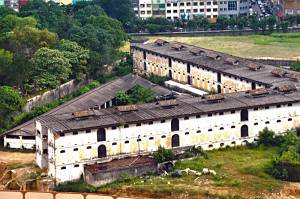
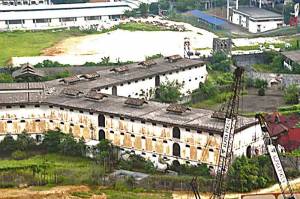
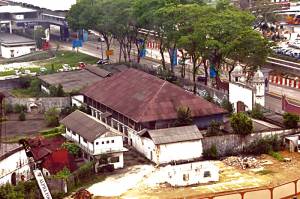
Sebahagian gambar dari Berjaya Times Square di sebelah timur, jari darak dekat.
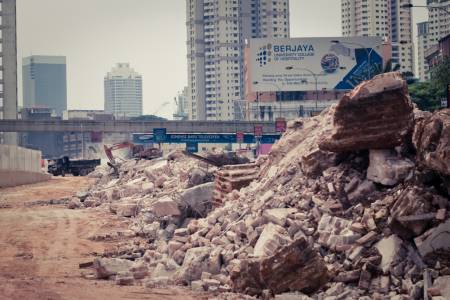
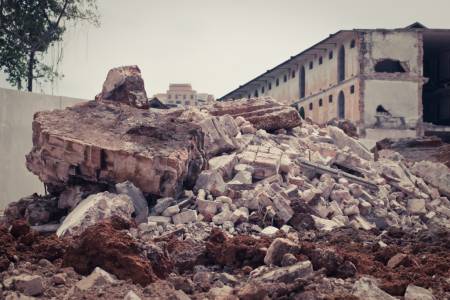
(Adi Arfan Mikhail @ Flickr, 22 Jun 2010: "In Memory - Pudu Prison Complex ~ Circa 1895-2010").
Koleksi gambar-gambar Liz Price pada hari selepas perobohan: "Pudu prison - the farewell".
Reaksi Umum
2010-06-22: Petikan pernyataan Badan Warisan Malaysia: “While it may be too late to save Pudu Jail, Badan Warisan hopes that the awareness raised by this will strengthen the public’s resolve to be conscious of how fragile our heritage is and to speak up for its protection, conservation and preservation.” (Pernyataan penuh: Badan Warisan Malaysia, 22 Jun 2010: |"Demolishing Pudu Jail: Erasing our history").
2010-06-27: Cadangan-cadangan alternatif daripada bekas petugas Penjara Pudu (hanya cadangan pertama sahaja yang akhirnya menjadi kenyataan): “Pudu Prison will not be around for much longer, but both Aziz and Abu Bakar believe it is important to preserve a part of it. “I agree that keeping the structure is a waste – the land is worth millions of ringgit. However, if part of the gate can be preserved, that is good enough. At least our grandchildren will see something to remember that Pudu Prison once stood here – just like A Famosa in Malacca,” he says. Abu Bakar has a grander plan. He suggests that a portion of the 10ha grounds be set aside to build a “monument” of sorts. “They can build a scaled model of the prison in there so people will be able to see what it actually looked like. “Perhaps they could have preserved the building and maybe turned it into a college,” says Pritan Kaur, whose grandfather, father and two uncles all worked at one time or another in Pudu Prison.” (D. RAJ and JOSEPH LOH @ The Star, 27 Jun 2010: |"If the prison walls could talk").
2010-08-26: Perancangan UDA: “UDA Holdings Bhd is talking to a few joint-venture partners to develop the former Pudu jail site and the 22-acre land next to it, but UDA will remain the sole master developer. The project is estimated to cost about RM5bil. … New plans will be submitted by the end of the year by UDA, a government developer. … The proposed project is part of the Kuala Lumpur development master plan. … The development of the former Pudu Prison was first unveiled by Second Finance Minister Datuk Ahmad Husni Hanadzlah in May. Husni said then that the mixed development project, to be known as Bukit Bintang Commercial Centre, will comprise a 33-storey office tower, a shopping complex, 43-storey hotel and a 44-storey serviced apartment.” (THEAN LEE CHENG @ The Star, 26 Aug 2010: |"Development of former Pudu Jail site to cost RM5bil").
2012-01-19: Ringkasan akademik: “On the night of 21 June 2010, a large crowd of onlookers gathered in the darkness to watch bulldozers demolish a 300-metre wall of Kuala Lumpur’s century-old Pudu Prison. The wall was adorned with what was reportedly the world’s longest mural, which had been painted by former inmates of the prison. The onlookers’ attempts to salvage pieces of the rubble as souvenirs bore testimony to the symbolic importance of one of the oldest colonial buildings in Malaysia’s capital city. In fact, some few weeks prior to the day of demolition, battle lines were drawn between developers and conservationists advocating diametrically opposed views about the value of the prison. Real estate speculators and urban planners argued that the removal of the complex was necessary to make way for commercial buildings and hotels, as well as to solve traffic problems in the area. All of these efforts are part of Kuala Lumpur’s ongoing project to transform itself into a model world-city. These arguments for the complete removal of the prison from the city landscape were met with objections from former political prisoners, heritage activists and opposition leaders who contended that Pudu Prison was one of Malaysia’s historical landmarks. Granted, the prison once confined and hanged criminals and drug offenders; but to pull down a building that was at once a site where country’s independence was fought would erase the physical reminder of a core constituent of Malaysian heritage and nationhood.” (Syed Muhd Khairudin Aljunied @ National University of Singapore, 19 January 2012: |"The Prison and the Anti-Colonialist in British Malaya").
2010-06-28 - 07-04: Liputan Khas Nanyang Siang Pau
Sempena perobohan Penjara Pudu seminggu sebelumnya, akhbar Nanyang Siang Pau telah menyiarkan siri ruangan perihal dan sejarah berkaitan, mulai 28 Jun hingga 4 Julai 2010:-
(Sumber: Lostgens: "Goodbye Pudu Jail").
2011-2012: Perobohan Beransur-Ansur
Gambar-gambar Penjara Pudu sebelum perobohan selesai sepenuhnya:-
Perobohan (2011)
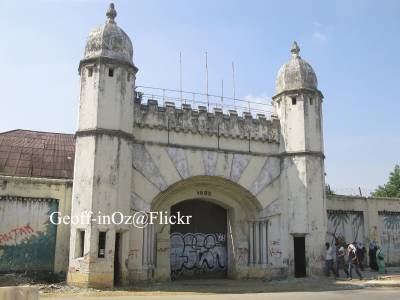
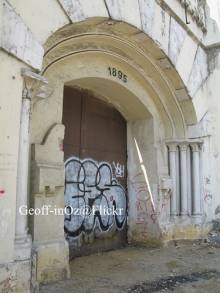
Gambar sekitar Ogos 2011: “Built: 1895 - Architectural style: Indo-Saracenic. Also known as Pudu Gaol, Pudu Jail, Penjara Pudu, Pudoh Gaol and City Gaol. … When I last visited the site in August 2011 it had been partially demolished.” (geoff-inOz @ Flickr, August 22, 2011: |"Pudu Prison, Shaw Road, Kuala Lumpur, Selangor").

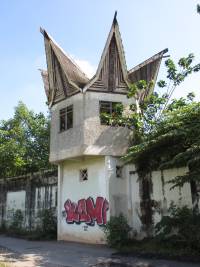
Kiri: Gambar dinding Penjara Pudu sebelah barat yang masih belum diusik, Februari 2011: “Overgrown west wall of Pudu Prison in Feb 2011” (Cmglee @ Wikimedia, 2011).
Kanan: Gambar menara kawalan, masih seperti asal, diambil pada 3 Mac 2012: andre oortgijs @ Wikimedia, 2012).
Perobohan (2012)
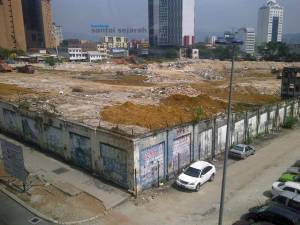

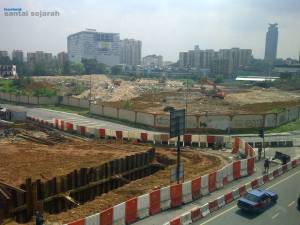
Gambar sebelah utara / barat laut Penjara Pudu pada 20 November 2012. Kelihatan keseluruhan blok-blok penjara telah pun dirobohkan. Hanya dindingnya sahaja yang masih belum dirobohkan sepenuhnya: “gambar ni sy ambil pada 20 November 2012 dari dalam monorel..” (Megat Kucing @ Santai Sejarah: "Penjara Pudu").

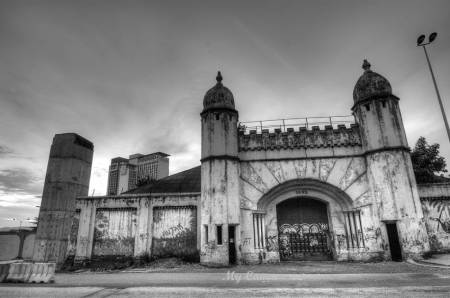
Gambar sekitar tahun 2012:-
Kiri: “Dua tahun lepas rasanya ..”
Kanan: “Tahun lepas pergi.. Dah tak ada dah tembok bergraffiti tu. Pintu Gerbang Penjara Pudu tu pun dah tertutup dengan pagar besi biru .. tak ternampak lagi pintu itu ..”
(Sumber: DRSINGADOTCOM, 17/02/2014: |"PENJARA PUDU : DAHULU DAN SEKARANG").
2012-12: Perobohan Selesai Sepenuhnya
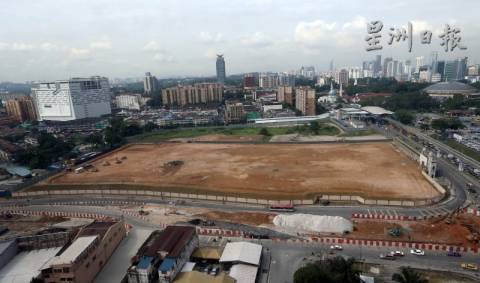
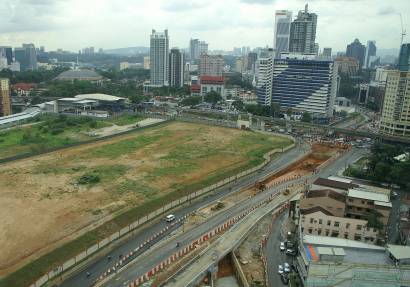
Kiri: Gambar Februari 2013: “The historic Pudu Jail with heritage link to KL city is finally torn down…” (nkkhoo.com, 24th February, 2013: "The historic Pudu Jail with heritage link to KL city is finally torn down").
Kanan: Gambar Jun 2013: hanya gerbang utama dan kolam air pancut lama sahaja yang tinggal: “Area of the former Pudu Prison in June 2013. Only the entrance gate and an old water fountain remain.” (D-M Commons @ Wikimedia, 2013).
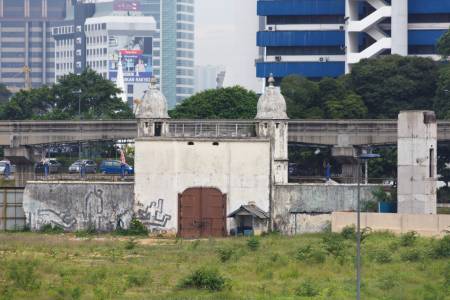
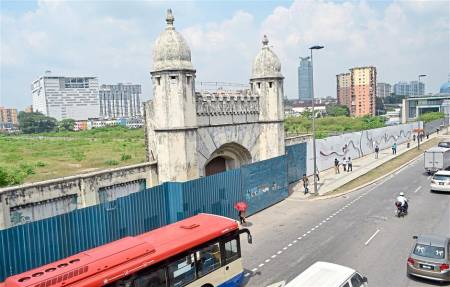
Kiri: Gambar 7 September 2013: “The historic gate of Pudu Prison. The prison is demolished now. However, some murals were still on the walls, revealing the horror of the building” (Uwe Aranas @ Wikimedia, 2013).
Kanan: Gambar tahun 2014: “In 2014, this was all that was left: The front gate flanked by domed towers reflecting Moorish architecture. Photo: Filepic” (Wong Li Za @ The Star, 20 Apr 2016: |"With these buildings gone, have we lost part of our heritage?").
2013-10-08: Pemindahan SAFTEA Clubhouse
Sejak Oktober 1953, Selangor & Federal Territory Eurasian Association (SAFTEA) Clubhouse terletak di tanah rizab Penjara Pudu di sebelah tenggara, beralamat di 167, Jalan Pudu. Pada asalnya ia adalah petempatan sementara sahaja, oleh kerana tanah yang diberikan di Jalan Maxwell (kini Jalan Sultan Ismail) sedang digunakan oleh pihak tentera ketika itu. Pada tahun 1981 pihak DBKL pernah membenarkan pendudukannya secara rasmi pada 1981, namun ia tidak diketahui ketika permohonan lesen pendudukan sementara (TOL) dibuat pada tahun 1985, lalu tidak diluluskan. Hal ini hanya diketahui oleh pihak SAFTEA pada tahun 2012 (kemungkinan ketika UDA sedang meneruskan perobohan seluruh kompleks Penjara Pudu). Setelah siri mesyuarat dengan pihak kerajaan, serta tindakan guaman terhadap UDA, akhirnya pihak SAFTEA dianugerahi sebidang tanah di Bangsar Utama, dan mereka perlu berpindah ke sana pada 8 Oktober 2013:-
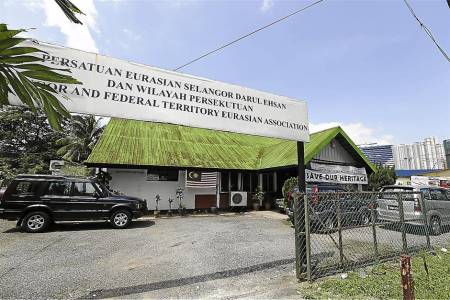
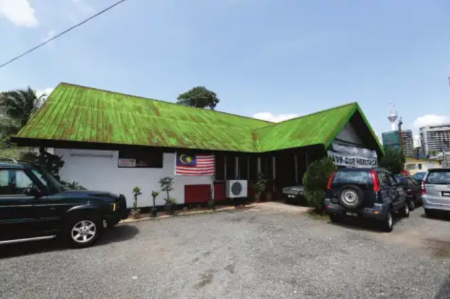
The Saftea Clubhouse @ 167, Jalan Pudu (Gambar September 2013):-
Kiri: (YVONNE T. NATHAN @ The Star, 30 Sep 2013: |"Saftea members sad at prospect of leaving 60-year-old Pudu club").
Kanan: (Selangor & Federal Territory Eurasian Association (SAFTEA), September 2013: |Saftea News, ISSUE 1 / 2013 Jan - Sept, m.s. 1).
“In 1940, the Selangor Eurasian Association (SAFTEA’s earlier incarnation) was offered a licence to use a piece of land (of about 4 acres) in Maxwell Road. We could not accept the land at the time, as we could not afford to build a clubhouse then. After the war, the association wanted to accept the land, but it was then unavailable, as the military was using it. SEA was informed that the land would be available in 1955; according to records however, the association did not claim the land after this time. … We moved to the clubhouse at 167, Jalan Pudu in 1953, and have been here for 60 years; the area now occupied by SAFTEA is 0.64 acres. Thanks to the Government Valuers (JUPEM) who came to the site on 9 September, 2012 we know that our boundary reaches until the edge of the yellow building outside. … It was said that we could never own this plot, as it belongs to the jail reserve. However, on 20 July 1981, a letter was written by Dewan Bandaraya Kuala Lumpur (DBKL) to the Kuala Lumpur Land Office, stating that it had no objections for the Jalan Pudu plot to be used as a private institution by SEA. This was the closest that SAFTEA ever got to getting ownership of 167, Jalan Pudu. Documents show that then-President, Geoff Leembruggen, had gotten architects to drawup plans for a building on this plot. Then we had a change of leadership, and the letter and corresponding documents were lost, only to be found 30 years later in 2012 in DBKL’s office by John De Souza, who worked with the lawyers on the land issue. In 1985 – with no knowledge of what had happened in 1981 – SEA applied for TOL, and was duly rejected by the authorities. In 2011, it was reported at the AGM that we had received from UDA an intention to rent out to us between 1000 and 3000 square feet of property in UDA’s development. This saga continued, until the association received an eviction notice from UDA in 2012. Had this story turned out differently, we might be sitting on a RM33 million piece of land with a 10-storey building today! In response to UDA’s 2012 eviction notice, the GC and the President met with the Minister of Federal Territories and Urban Well-being on 7 May 2012 in Putrajaya and again on 8 October 2012 at Parliament. Attending this first meeting were Edward Joseph, Derek Surin, Elaine Especkerman and Maureen Sibert along with the President, Sheila De Costa, as well as the Deputy Speaker of the Dewan Rakyat, Datuk Dr. Wan Junaidi, who facilitated the meeting. At the second meeting (as the time was changed by the minister at the last minute), only Vice President Edward Joseph and the President attended. Our lawyers, Cheah Teh & Su, have attended court more than 13 times since the first case management on 13 June 2012. SAFTEA’s GC and President have attended 4 meetings with UDA and the Government of Malaysia (GOM) – on 2 August 2012, 3 September 2012, 25 September 2012 (with the Attorney General’s Chambers’ representatives, JUPEM and UDA at the clubhouse) and 11 January 2013. These do not include the consultations and meetings with the lawyers. … As a result of the legal action, in July of 2012, UDA expressed an intention to offer us a piece of land in Bangsar Utama with an area of about 9000 square feet, valued at between RM2.5 million and RM5 million. The offer was only firmed up on 23 November 2012; SAFTEA finally accepted on 11 January 2013. … On 28 August 2013, UDA’s solicitors responded and agreed that while vacant possession will take place simultaneously, SAFTEA will only need to withdraw its suit when consent to transfer the BU land has been obtained. Case management was continued on 5 September, at which time the date for vacation of the Pudu land was given as 8 October. It should be noted that with this agreement, SAFTEA will become owners of a piece of land rather than getting a licence to occupy, as the authorities have been proposing since 1940.” (Selangor & Federal Territory Eurasian Association (SAFTEA), September 2013: |Saftea News, ISSUE 1 / 2013 Jan - Sept, m.s. 1-3).
“Rebuilding Eurasian heritage from the foundation up sounds like beautiful figure of speech but in the case of Selangor and Federal Territory Eurasian Association (Saftea) it is a challenge president Sheila E. De Costa and Saftea members are faced with both metaphorically and literally in relocating their clubhouse. The first Saftea woman president, proudly recounted the way members of the association reused most of the original bricks from their clubhouse in the 1940s to 1950s that was in St. John’s church (now St. John’s Cathedral) to build the one in Jalan Pudu. … The association itself has steadfastly preserved its variety of cultural legacies from 1919 through pre-war times, the Japanese occupation as well as post-war with the clubhouse in historically rich Jalan Pudu for almost 60 years — since October 1953. … The historical value of the clubhouse extends further as De Costa talked about help the association provided to the Eurasian community after World War II. “Jalan Pudu used to be along the main thoroughfare in town where members lived within walking distance. We have a great storehouse of original documents that show how people would write to the association for us to help look for missing Eurasians after the war,” De Costa said.” (YVONNE T. NATHAN @ The Star, 30 Sep 2013: |"Saftea members sad at prospect of leaving 60-year-old Pudu club").
2015: Bukit Bintang City Centre (BBCC) Masterplan
Menjelang tahun 2015, UDA Holdings Berhad, bersama Ecoworld dan Employees Provident Fund (EPF), mula membangunkan tapak Penjara Pudu seluas 19.4 ekar menjadi Bukit Bintang City Centre (BBCC). Pembangunannya di bawah GDP Architects, bersama 3 syarikat arkitek tempatan, dan dijalankan dalam 3 peringkat: “By 2015, the land owners, UDA Holdings Berhad found suitable development partners in Ecoworld and Employees Provident Fund (EPF) to turn this into a 19.4 acre highly integrated mixed use development. Due to the strategy location, this development has been given the name Bukit Bintang City Centre or BBCC. BBCC embraces the live, work & play concept in an integrated development setting. It is a transit-oriented development, with commercial, residential, entertainment & public facilities that intertwined to create a city within a city. The development is envisioned in 3 phases with GDP Architects as the Lead Architect working alongside 3 other local Architects. Concept Design was envisioned with Jerde Partnership. This development ranges from 6 to 80 storeys across nine towers, a retail mall, and an entertainment hub with a distinct architectural language. Each of these components has its own unique design sensibilities that respect local traditions and their tropical climate. A variety of materials, textures, and colours have been considered for the facade, creating an interplay of light and shadow.”
(Sumber: Andrew Yit, GDP Architects & Jerde Partnership, 2022: |"Bukit Bintang City Centre Masterplan").
2016: Sebelum Pembinaan
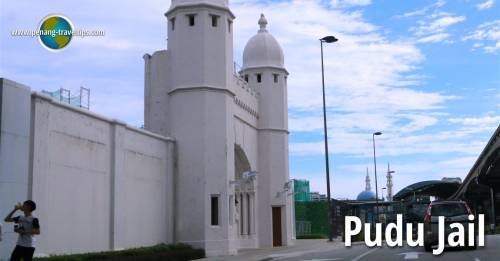
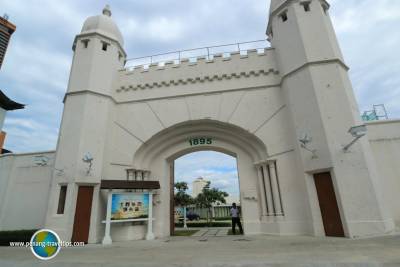
Gambar gerbang hadapan Penjara Pudu, beberapa bulan sebelum pembinaan: The historic entrance of Pudu Jail (8 July, 2016)“ (Dengan izin / with permission: Timothy Tye @ Discover with Tymothy, 2016: "Pudu Jail, Kuala Lumpur").
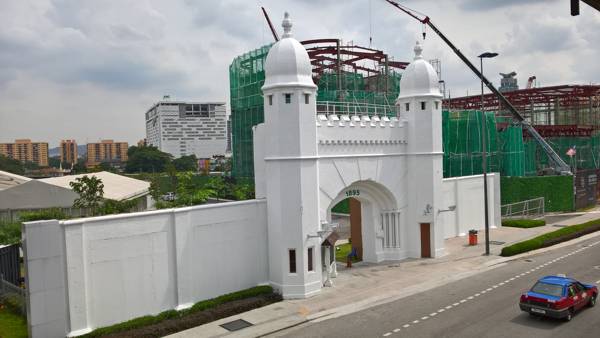
“The gateway to hell, Pudu Prison's last remains (October, 2016).” (Last Geocacher @ Geocaching, 2016: |"Hell's Gate").
2017-06-20: Majlis Pecah Tanah Bukit Bintang City Centre (BBCC)
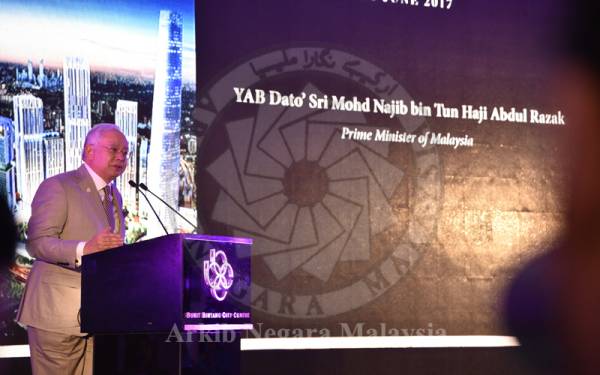
“MAJLIS PECAH TANAH BUKIT BINTANG CITY CENTRE (BBCC) DAN MITSUI SHOPPING PARK LALAPORT KL BBCC, PERASMIAN OLEH PERDANA MENTERI, DATO' SRI MOHD NAJIB BIN TUN HAJI ABDUL RAZAK, KUALA LUMPUR, 20 JUN 2017” (JABATAN PENERANGAN MALAYSIA, 20/06/2017: |"MAJLIS PECAH TANAH BUKIT BINTANG CITY CENTRE (BBCC) DAN MITSUI SHOPPING PARK LALAPORT KL BBCC, PERASMIAN OLEH PERDANA MENTERI, DATO' SRI MOHD NAJIB BIN TUN HAJI ABDUL RAZAK, KUALA LUMPUR, 20 JUN 2017").
2017-2022: Pembinaan BBCC: Fasa Pertama
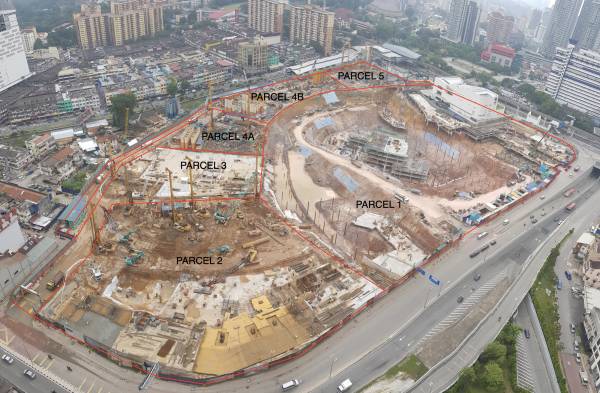
2017: Peringkat awal pembinaan (Andrew Yit, GDP Architects & Jerde Partnership, 2022: |"Bukit Bintang City Centre Masterplan").
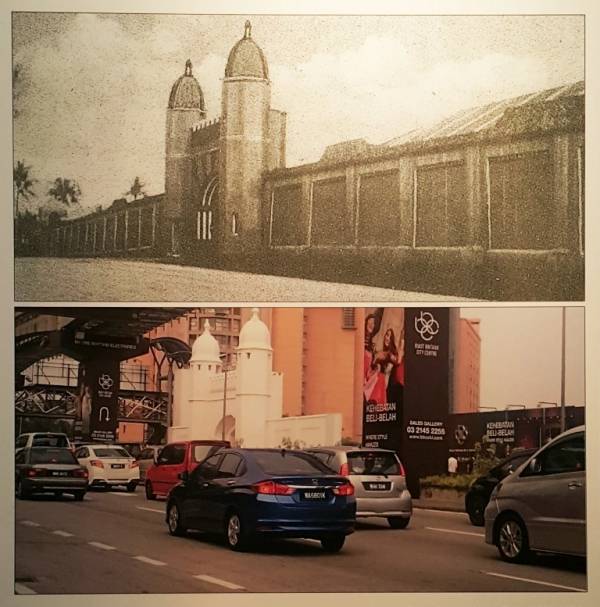
Mac 2017: ketika ini hampir keseluruhan kawasan Penjara Pudu telah diruntuh dan dibangunkan. Yang tinggal hanya pintu besar hadapan dan sebahagian kecil dinding luar: “Pudu Prison at Jalan Hang Tuah. Today, only the main gate and a small part of the exterior wall remains.” (Bahiah Ismail @ Museum Volunteers, JMM, March 22, 2017: |"Kuala Lumpur – Masa Berlalu").
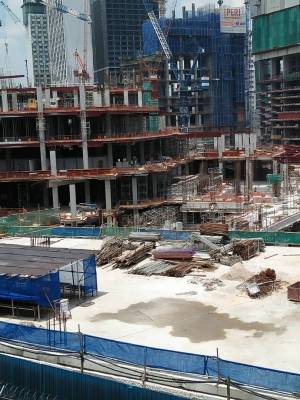
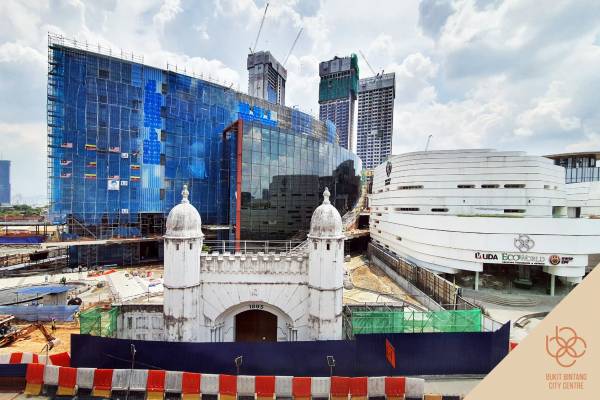
November 2020: pembinaan sedang giat dijalankan, dan bangunan yang baru dibina telah pun kelihatan. Anggaran siap fasa pertama pada tahun 2021: “There has been much progress and we are excited to see the completion of Phase 1 by 2021! … This is also where our sales gallery is located if you would like to visit us to find out more about BBCC” (Gambar kiri: Bebasnews, 05/06/2020: |"Penjara Pudu – Masihkah kau ingat lagi". Gambar kanan: Bukit Bintang City Centre @ Facebook, 6 November 2020: |Bukit Bintang City Centre).
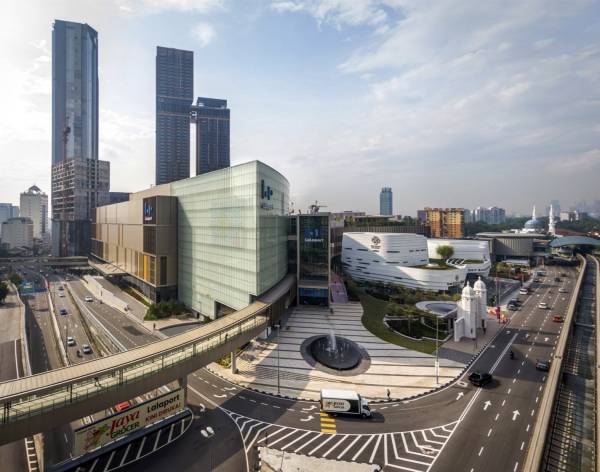
Awal 2022: Fasa 1 siap dibina: “The first phase of BBCC was completed and opened to visitors in early 2022. The area is now home to Mitsui Lalaport lifestyle shopping mall, a railway transit hub and business suites. There will be other upcoming buildings in the area including an 80-storey tower known as the BBCC Signature Tower.” (The Small Local, 29 April 2022: |"Pudu Jail: 7 Facts About The Famous Malaysian Prison That Once Had The World’s Longest Mural").
“Client : BBCC Development
Project Duration : since 2015
Location : Kuala Lumpur, Malaysia
Land Size : 19.4 acres
GFA : 6.7 million sqft
Built Up : 11.5 million sqft
Status : Phase 1 completed Q1 2022
Collaborations : Jerde Partnership, AJM, Veritas Architects, BEP Architects
Responsibilities : Project Architect, Masterplan Design, Schematic Design, Planning Submission, Construction”
(Sumber: Andrew Yit, GDP Architects & Jerde Partnership, 2022: |"Bukit Bintang City Centre Masterplan").
2022-01: Pembukaan LaLaport BBCC
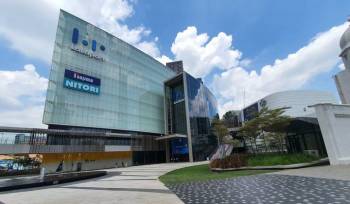
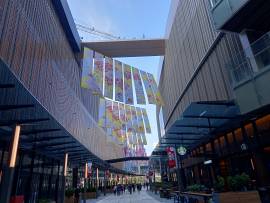
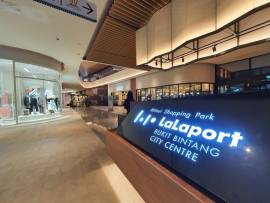
“Mitsui Lalaport Mall is a chain of shopping malls from Japan that just opened its first Malaysian mall right in the city earlier this year. The mall features notable Japanese stores such as NITORI, Nojima, and Don Don Donki. … all that was left is the landmark main gate and a section of the exterior wall. In fact, the main gate has actually been incorporated within the design of Lalaport! Lalaport officially opened in January 2022 to much fanfare and thousands of pictures on their iconic staircase.” (Anne Dorall @ The Rakyat Post, July 27, 2022: |"Is Lalaport, The Mall Built Over Pudu Jail Worth Visiting?").
“Bakal beroperasi pada 20 Januari 2022, Mitsui Shopping Park LaLaport BUKIT BINTANG CITY CENTRE (“LaLaport BBCC”) merupakan fasiliti peruncitan luar negara mereka yang pertama di Asia Tenggara oleh Mitsui Fudosan Co., Ltd. (“Mitsui Fudosan”).” (Skyscrapers MY, 14 Januari 2022: Tapak Penjara Pudu kini menjadi 'Shopping Mall').
Kini
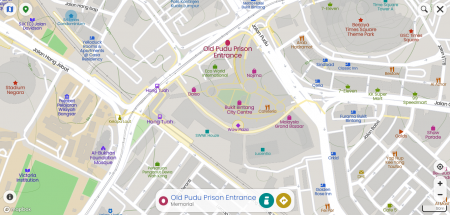
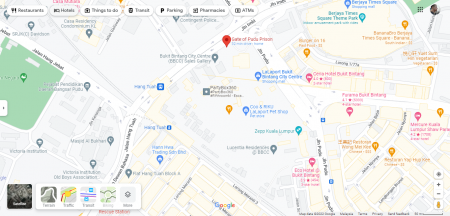
Peta Bukit Bintang City Centre (BBCC) kini:-
Kiri: Mapcarta
Kanan: Google Maps
Peninggalan
Gerbang di LaLaPort, BBCC
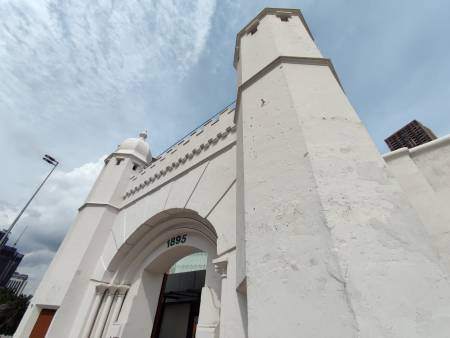
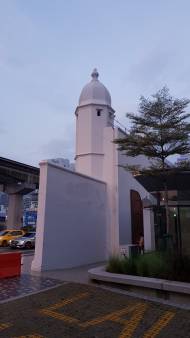
Ogos 2022: Peninggalan Penjara Pudu di Lalaport:-
Kiri: Gerbang utama Penjara Pudu adalah satu-satunya peninggalannya, di hadapan LaLaport Bukit Bintang (2 Ogos 2022): “The Pudu Prison main gate is remained as a vestige in front of LaLaport Bukit Bintang City Centre” (Wee Hong @ Wikimedia, 2 August 2022).
Kanan: Gambar gerbang utama, dari dalam (23 Januari 2022): “The entrance gate of the former Pudu Jail. Next to the BBCC WW2 memorial” (Derkommander0916 @ Wikimedia, 23 January 2022).
Pagar di Muzium Melaka
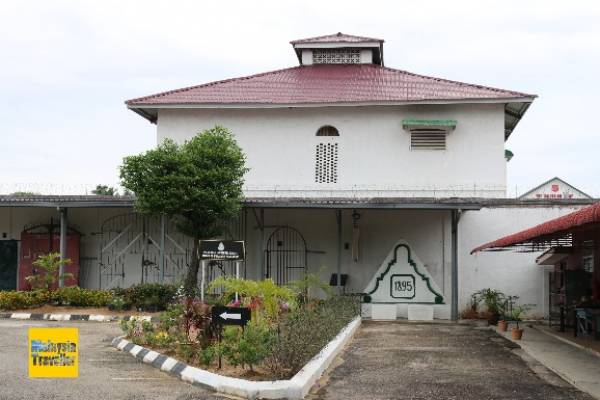
Sebahagian pagar lama Penjara Pudu yang bertanda tahun 1895, disimpan di bahagian belakang Muzium Melaka: “The part of the old Pudu Jail gate bearing the date of its establishment (1895) was preserved and can be seen outside the rear of the Prison Museum.” (David @ Malaysia Traveller: |"The Malaysia Prison Museum Melaka").
| Laman Utama | Hubungi Kami | ||||||||
| Siri Cebisan Sejarah: | Bangi | Gambang | Hutan | Ipoh | Kajang | Kuala Lumpur | Kuantan | Pulau Pinang | Hubungi Kami |

